India’s Startup Revolution

- 15 Jan 2025
Context
India has solidified its position as one of the most dynamic startup ecosystems globally, emerging as a hub for innovation, entrepreneurship, and technological progress. However, realizing its ambition of becoming the top startup ecosystem requires addressing critical challenges and leveraging available opportunities.
Current Landscape of Indian Startups
Growth and Innovation
India ranks as the third-largest startup ecosystem in the world, following the U.S. and China. As of January 15, 2025, over 1.59 lakh startups have been officially recognized by DPIIT, with more than 120 attaining unicorn status (valuation exceeding $1 billion).
Investment Trends
Despite economic fluctuations, India's startups continue to attract significant investments. In 2022, venture capitalists infused $25 billion into the ecosystem, reaffirming India’s position as a preferred destination for global investors. Although there was a slowdown in 2023, domains like Software as a Service (SaaS) and climate tech continue to secure substantial funding.
Government Support
India’s startup-friendly policies, including Startup India, Digital India, and Atmanirbhar Bharat, have created an enabling environment. Notable initiatives include:
- Tax incentives, faster patent approvals, and regulatory relaxations.
- The launch of a ?10,000 crore Fund of Funds for Startups (FFS) in 2023 to improve capital accessibility.
- The Bharat Startup Knowledge Access Registry (BHASKAR) to streamline collaboration among startups and investors.
Regional Growth
- Tier II and III Expansion: Nearly 50% of startups are now based in emerging hubs such as Indore, Jaipur, and Ahmedabad.
- Tamil Nadu: The state boasts a $28 billion startup ecosystem, growing at 23%. Chennai alone houses around 5,000 startups, significantly contributing to employment generation.
- Kerala: With a $1.7 billion startup ecosystem, Kerala exhibits a compound annual growth rate of 254%, emphasizing cost-effective tech talent hiring.
Key Challenges Faced by Startups
1. Funding Constraints
The global economic downturn, coupled with rising interest rates, has limited venture capital inflows, resulting in layoffs and operational cutbacks.
2. Regulatory and Compliance Barriers
Despite government support, startups grapple with complex tax structures, evolving data protection laws, and stringent compliance requirements, including ESOP taxation policies.
3. Scaling and Market Adaptability
Many startups struggle with operational inefficiencies, limited market penetration, and inadequate infrastructure, hampering growth potential.
4. High Failure Rate
Approximately 90% of Indian startups fail within five years due to poor product-market fit, lack of financial planning, and insufficient adaptation to market needs.
5. Talent Shortages
India faces stiff competition in acquiring skilled professionals in areas like AI, cybersecurity, and machine learning, making retention increasingly difficult amid economic uncertainties.
Strategic Measures to Strengthen India’s Startup Ecosystem
1. Enhancing Policy Frameworks
- Simplified Regulations: Streamline startup registration, funding approvals, and international business operations.
- IP Protection: Strengthen intellectual property laws to boost R&D investment.
- Sector-Specific Initiatives: Develop targeted policies for AI, deep tech, healthcare, and green technologies.
2. Expanding Funding Access
- Encouraging Domestic Investment: Leverage pension and sovereign wealth funds to invest in startups.
- Public-Private Partnerships: Foster large-scale government-industry collaboration to finance emerging ventures.
- Decentralized Funding: Expand angel investor networks and micro-investment opportunities, particularly in Tier II and III cities.
3. Building Robust Infrastructure
- Tech Parks and Incubation Centers: Establish state-of-the-art facilities with mentorship programs.
- Improved Digital Connectivity: Ensure high-speed internet access in underserved regions.
- Enhanced Logistics and Supply Chains: Strengthen infrastructure to support startup scalability.
4. Developing a Skilled Workforce
- STEM and Entrepreneurial Education: Introduce curriculum enhancements in technical and business disciplines.
- Upskilling Programs: Collaborate with industry leaders to train professionals in high-demand skills.
- Diversity and Inclusion: Promote initiatives encouraging women and marginalized communities in entrepreneurship.
5. Fostering Innovation and Risk-Taking
- Strengthened R&D Funding: Increase allocations to universities and private research sectors.
- Encouraging Entrepreneurship: Reduce societal stigma surrounding startup failures to promote risk-taking.
- Leveraging Domestic Challenges: Address local issues like climate change and urbanization through innovation.
6. Expanding Global Reach
- International Collaborations: Partner with foreign accelerators and governments.
- Ease of Cross-Border Trade: Simplify export and import regulations for startups.
- Engaging the Indian Diaspora: Encourage successful overseas entrepreneurs to mentor and invest in Indian startups.
7. Advancing Sustainability Goals
- Green Tech Promotion: Support startups focusing on renewable energy and circular economy initiatives.
- Eco-Friendly Incentives: Offer financial support to ventures aligning with sustainability targets.
- Inclusive Growth Strategies: Expand agritech, edtech, and health-tech startups in rural areas, supporting platforms like the Women Entrepreneurship Platform (WEP) by NITI Aayog.
Building a Resilient Digital Economy
To fortify India's digital economy, startups should leverage existing infrastructure like UPI and Aadhaar while capitalizing on emerging technologies such as AI, 5G, and blockchain. A robust cybersecurity framework and data protection policies will be essential to ensure investor confidence.
Why Farmers Deserve Price Security
- 11 Jan 2025
Introduction:
The future of Indian agriculture is at a crossroads. With the shrinking of the agricultural workforce and the diversion of fertile farmlands for urbanization, ensuring the sustainability of farming is a strategic imperative. Among the various support mechanisms for farmers, the Minimum Support Price (MSP) remains a central point of debate. Should there be a legal guarantee for MSP? This question has gained prominence, especially with the rising challenges in agriculture, from unpredictable climate patterns to volatile market prices.
The Decline of Agriculture and Its Impact
India’s agricultural sector faces a dual crisis: loss of both land and human resources. Prime agricultural lands across river basins, such as the Ganga-Yamuna Doab or the Krishna-Godavari delta, are being repurposed for real estate, infrastructure, and industrial projects. Additionally, the number of "serious farmers" – those deriving at least half of their income from agriculture – is dwindling. The number of operational holdings may be 146.5 million, but only a small fraction of these farmers remains committed to agriculture.
This decline threatens the future of India’s food security, as the country will need to feed a population of 1.7 billion by the 2060s. To sustain farming and ensure long-term food security, we must secure farmers' livelihoods. Price security, particularly through MSP, plays a crucial role in this context.
The Role of MSP in Securing Farmers
MSP is the government-mandated price at which it guarantees the purchase of crops if market prices fall below a certain threshold. It provides a safety net for farmers against price volatility. The process of fixing MSP involves recommendations by the Commission for Agricultural Costs and Prices (CACP), which takes into account factors such as the cost of production and market trends. Once approved by the Cabinet Committee on Economic Affairs (CCEA), MSP is set for various crops, including rice, wheat, and sugarcane.
For farmers to stay in business, there must be a balance between production costs and returns. Farming is a risky business – yield losses can occur due to weather anomalies, pest attacks, or other natural factors. However, price risks can be mitigated with a guaranteed MSP. This would encourage farmers to invest in their land and adopt modern farming technologies, which would boost productivity and reduce costs.
Arguments for and Against Legal MSP Guarantee
Supporters of a legal MSP guarantee argue that it would provide financial security to farmers, protecting them from unpredictable market conditions. It would also promote crop diversification, encourage farmers to shift from water-intensive crops to those less dependent on irrigation, and inject resources into rural economies, thus addressing distress in rural areas.
However, critics highlight several challenges with a legal guarantee for MSP. The most significant concern is the fiscal burden it would impose on the government, potentially reaching Rs. 5 trillion. Furthermore, such a system could distort market dynamics, discouraging private traders and leading to a situation where the government becomes the primary buyer of agricultural produce. This could be economically unsustainable, especially for crops with low yields. Additionally, legal MSP guarantees could violate World Trade Organization (WTO) subsidy principles, adversely impacting India’s agricultural exports.
The Way Forward: A Balanced Approach
Given the challenges associated with a legal MSP guarantee, alternative measures should be explored. Price Deficiency Payment (PDP) schemes, such as those implemented in Madhya Pradesh and Haryana, could be expanded at the national level. These schemes compensate farmers for the difference between market prices and MSP, ensuring price security without the fiscal burden of procurement.
Additionally, the government can focus on improving agricultural infrastructure, such as cold storage facilities, to help farmers better access markets and increase price realization. Supporting Farmer Producer Organizations (FPOs) could also help farmers by enhancing collective bargaining power and ensuring better prices for their produce. Moreover, gradual expansion of MSP coverage to include a wider range of crops would encourage diversification, reducing the dominance of rice and wheat.
Government Extends Special Subsidy on DAP

- 03 Jan 2025
In News:
The Indian government has decided to extend the special subsidy on Di-Ammonium Phosphate (DAP) fertilizer for another year, a decision aimed at stabilizing farmgate prices and addressing the challenges posed by the depreciation of the Indian rupee.
Key Government Decision
- Extension of Subsidy: The Centre has extended the Rs 3,500 per tonne special subsidy on DAP from January 1, 2025 to December 31, 2025.
- Objective: This extension aims to contain farmgate price surges of DAP, India’s second most-consumed fertilizer, which is being impacted by the fall in the rupee's value against the US dollar.
Fertilizer Price Dynamics and Impact
- MRP Caps on Fertilizers: Despite the decontrol of non-urea fertilizers, the government has frozen the maximum retail price (MRP) for these products.
- Current MRPs:
- DAP: Rs 1,350 per 50-kg bag
- Complex fertilizers: Rs 1,300 to Rs 1,600 per 50-kg bag depending on composition.
- Current MRPs:
- Subsidy on DAP: The subsidy includes Rs 21,911 per tonne on DAP, plus the Rs 3,500 one-time special package.
- Impact of Currency Depreciation:
- The rupee's depreciation has made imported fertilizers significantly more expensive.
- The landed price of DAP has increased from Rs 52,960 per tonne to Rs 54,160 due to the rupee falling from Rs 83.8 to Rs 85.7 against the dollar.
- Including additional costs (customs, port handling, insurance, etc.), the total cost of imported DAP is now Rs 65,000 per tonne, making imports unviable without further subsidy or MRP adjustments.
- The rupee's depreciation has made imported fertilizers significantly more expensive.
Industry Concerns and Viability Issues
- Import Viability:
- Fertilizer companies face significant cost pressures due to rising import prices and the current MRP caps.
- Without an increase in government subsidies or approval to revise MRPs upwards, imports will be unviable.
- Even with the extended subsidy, companies estimate a Rs 1,500 per tonne shortfall due to currency depreciation.
- Stock Levels and Supply Challenges:
- Current stock levels for DAP (9.2 lakh tonnes) and complex fertilizers (23.7 lakh tonnes) are below last year's levels.
- With inadequate imports, there are concerns about fertilizer supply for the upcoming kharif season (June-July 2025).
Government’s Strategy and Fiscal Implications
- Compensation for Imports:
- In September 2024, the government approved compensation for DAP imports above a benchmark price of $559.71 per tonne, based on an exchange rate of Rs 83.23 to the dollar.
- With the rupee falling below Rs 85.7, these previous compensation calculations have become outdated.
- Fiscal Impact:
- The extended subsidy will cost the government an additional Rs 6,475 crore. Despite this, political implications of raising the MRP are minimal, as only non-major agricultural states are facing elections in 2025.
Future Outlook and Priorities
- Immediate Priority: The government’s primary concern is securing adequate fertilizer stocks for the kharif season, focusing on ensuring sufficient imports of both finished fertilizers and raw materials.
- Balancing Factors: The government will need to navigate the complex balance of maintaining fertilizer affordability for farmers, ensuring the viability of fertilizer companies, and managing fiscal constraints.
As the subsidy extension is implemented, all eyes will be on the government's ability to ensure a stable supply of fertilizers while safeguarding both farmer interests and economic sustainability in the face of an increasingly challenging exchange rate environment.
Introduction to Dr. Manmohan Singh's Economic Reforms
- 31 Dec 2024
In News:
Dr. Manmohan Singh, a distinguished economist, played a crucial role in shaping India’s economic trajectory. His leadership, as Finance Minister (1991–96) and Prime Minister (2004–14), is particularly noted for the economic liberalization and reform policies that transformed India’s economy.
India’s Economic Crisis of 1991
- Economic Collapse: India faced a severe balance of payments crisis, with dwindling foreign reserves and rising inflation.
- Key Challenges: Fiscal deficit, industrial stagnation, and trade imbalances worsened by the collapse of the Soviet Union.
- Urgent Measures: Dr. Singh was appointed Finance Minister during this crisis and initiated bold reforms to stabilize and grow the economy.
Key Reforms in 1991
- Devaluation of the Rupee
- Aimed at making Indian exports competitive in global markets.
- Reduced import tariffs and liberalized foreign trade.
- Industrial Policy Reforms
- Abolition of Licence Raj: Deregulated the industrial sector, promoting private enterprises.
- Reduced state control and encouraged foreign investment, leading to industrial growth.
- Banking and Financial Reforms
- Reduced the statutory liquidity ratio (SLR) and cash reserve ratio (CRR).
- Allowed for more credit flow, fostering economic expansion and banking sector efficiency.
- Global Integration
- Introduced economic liberalization policies, integrating India with the global economy and attracting foreign investments.
Economic Growth and Social Welfare Initiatives
- Poverty Reduction: Reforms helped lift millions out of poverty by fostering job creation and industrial growth.
- Mahatma Gandhi National Rural Employment Guarantee Act (MGNREGA): Launched in 2005, providing 100 days of wage employment to rural households.
- Right to Information (RTI) and Right to Education (RTE)
- Empowered citizens by ensuring transparency and access to government information.
- RTE guaranteed free and compulsory education for children aged 6-14.
- Financial Inclusion: Aadhar project introduced to facilitate welfare delivery and financial inclusion.
Legacy of Economic Liberalization and Growth
- Economic Growth: Under his leadership, India’s GDP grew at an average rate of 8%, establishing India as one of the fastest-growing economies.
- Shift to a Market-Driven Economy: Reforms dismantled socialist controls, facilitating the rise of the private sector.
- Attracting Foreign Investment: Economic liberalization and policy reforms made India an attractive destination for foreign capital.
Leadership During Political and Economic Challenges
- Reluctant Prime Minister
- In 2004, Singh became Prime Minister despite initial reluctance, emerging as a unifying figure during coalition politics.
- His tenure saw India’s rise as a global economic power, particularly from 2004–2009.
- Challenges
- Singh’s second term was marred by allegations of corruption and policy paralysis, leading to criticism of his administration.
- However, his personal integrity remained intact, and he maintained focus on governance.
- Historic India-US Nuclear Deal (2008)
- The deal marked a significant shift in India’s foreign relations and energy policies, enabling civilian nuclear trade.
Conclusion
Dr. Manmohan Singh’s economic policies are central to India's modern economic framework. His vision transformed India from a closed, socialist economy to a vibrant, globalized economy, promoting inclusive growth and institutional reforms. Despite facing challenges and criticisms, his legacy remains a testament to strategic policymaking that continues to influence India’s economic landscape.
Sustainable Groundwater Management in India’s Agriculture
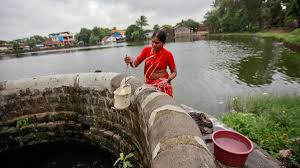
- 30 Dec 2024
Introduction: Groundwater Crisis and Agriculture
- India's Agricultural Dependence on Groundwater: India is a leading producer of water-intensive crops like rice, wheat, and pulses. The country’s agricultural sector heavily depends on groundwater for irrigation, especially for paddy cultivation.
- Over-exploitation of Groundwater: Groundwater extraction for irrigation is increasingly unsustainable, threatening agricultural sustainability in the long term.
Rising Groundwater Usage and Its Implications
- Population Growth and Groundwater Use: Between 2016 and 2024, global population grew from 7.56 billion to 8.2 billion, and India’s population rose from 1.29 billion to 1.45 billion. Concurrently, groundwater used for irrigation increased from 38% in 2016-17 to 52% in 2023-24, exacerbating the water crisis.
- Over-extraction in Major Paddy-Producing States: States like Rajasthan, Punjab, and Haryana have witnessed severe over-exploitation of groundwater for irrigation.
- Rajasthan: Highest groundwater salinisation (22%) despite receiving the highest average rainfall (608 mm) among these states.
- Punjab and Haryana: Lesser groundwater salinity due to canal irrigation and micro-irrigation systems.
Impact of Excessive Fertilizer Use on Groundwater Quality
- Soil Salinity and Groundwater Contamination: Excessive use of fertilizers, particularly for paddy cultivation, increases soil salinity and contributes to groundwater contamination.
- Toxic Chemicals in Groundwater: Nitrate contamination, caused by nitrogen-based fertilizers, and uranium contamination due to phosphate fertilizers are key concerns in states like Maharashtra, Telangana, Andhra Pradesh, and Tamil Nadu.
- Health Risks: Contaminated groundwater poses health risks such as thyroid disorders, cancer, and dental fluorosis, along with reduced agricultural productivity.
Projected Impact on Future Groundwater Availability
- Unsustainable Groundwater Levels: The Central Groundwater Board (CGWB) reports that if current practices continue, over half of the districts in Punjab could face groundwater depletion. Similarly, 21-23% of districts in Haryana and Rajasthan may experience a similar crisis.
- Population Growth and Water Scarcity: With India’s population expected to reach 1.52 billion by 2036, the need for sustainable groundwater management becomes even more critical.
Government Initiatives for Groundwater Management
- National Mission for Sustainable Agriculture (2014): Promotes sustainable practices like zero tillage, cover cropping, and micro-irrigation for efficient water and chemical use.
- Pradhan Mantri Krishi Sinchai Yojana (2015): Aims to boost irrigation efficiency through drip and sprinkler irrigation methods.
- Atal Bhujal Yojana (2019): Targets efficient groundwater management in water-stressed states like Gujarat, Haryana, Rajasthan, Maharashtra, and Uttar Pradesh.
- Success of Government Initiatives: CGWB data shows that the percentage of districts with unsustainable groundwater levels dropped from 23% in 2016-17 to 19% in 2023-24.
Role of State Governments in Groundwater Management
- State-Level Initiatives: States with unsustainable groundwater levels must take proactive measures to manage water resources efficiently.
- Example - Odisha: Odisha's Integrated Irrigation Project for Climate Resilient Agriculture emphasizes irrigation efficiency and climate-smart practices, supported by World Bank funding.
- Encouraging Resource-Efficient Agriculture: States with safe groundwater levels, like Chhattisgarh, Bihar, Jharkhand, Telangana, and Odisha, should adopt water-efficient practices to protect groundwater resources.
Conclusion: Ensuring Agricultural Sustainability and Water Security
- Need for Urgent Action: Scaling up efforts to improve irrigation practices and groundwater management is crucial to securing India’s agricultural future.
- Global Food Security: Protecting groundwater resources will not only ensure water security within India but also contribute to global food security amid climate challenges.
- Blueprint for Sustainable Agriculture: States like Odisha are providing a model for sustainable water management, which can be replicated across water-stressed regions in India.
Bank Credit to Women Self-Help Groups (SHGs)
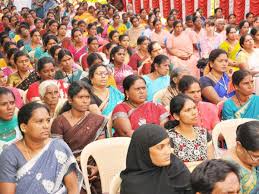
- 21 Dec 2024
Introduction
The Deendayal Antyodaya Yojana – National Rural Livelihoods Mission (DAY-NRLM) is a flagship program by the Ministry of Rural Development (MoRD) that aims to reduce poverty by empowering women, especially through Self-Help Groups (SHGs). These SHGs have been instrumental in improving financial inclusion, providing access to credit, and enhancing the economic and social status of women across India. The program has made significant strides in mobilizing women, improving their access to financial services, and facilitating entrepreneurial ventures in rural areas.
Key Features and Initiatives of DAY-NRLM
- Self-Help Groups (SHGs):
- Formation: DAY-NRLM supports the creation and strengthening of SHGs, primarily focusing on rural women from economically disadvantaged backgrounds.
- Mobilization: As of 2024, over 10.05 crore women have been mobilized into 90.87 lakh SHGs across India.
- Objective: The main goal is to reduce poverty through empowerment by providing access to financial services and sustainable livelihoods.
- Start-up Village Entrepreneurship Programme (SVEP):
- Support for Rural Enterprises: SVEP, a sub-scheme under DAY-NRLM, encourages SHG women and their families to set up small-scale businesses.
- Impact: As of October 2024, 3.13 lakh rural enterprises have been supported under this initiative.
- State-wise Distribution: The program has supported enterprises across various states, with notable contributions from Andhra Pradesh (27,651 enterprises), Kerala (34,569), and Uttar Pradesh (28,904).
- Banking Correspondent Sakhis:
- Role: Women in SHGs are trained as Banking Correspondent Sakhis to enhance access to banking services such as deposits, credit, remittances, pensions, and insurance in rural areas.
- Current Deployment: 1,35,127 Sakhis have been deployed under DAY-NRLM, empowering women to be financial intermediaries in their communities.
- Financial Support for SHGs:
- Revolving Fund: SHGs receive funds ranging from Rs. 20,000 to Rs. 30,000 to boost their operations and financial stability.
- Community Investment Fund: SHGs can avail of up to Rs. 2.50 lakh under the Community Investment Fund to strengthen their financial position.
- Interest Subvention: To make bank loans more affordable, DAY-NRLM provides interest subvention to SHGs, reducing their overall credit costs.
- Online Marketing Platform:
- www.esaras.in: This online platform allows SHGs to market their products, improving their access to broader markets and enhancing their income-generating potential.
Impact of DAY-NRLM and SHGs
- Financial Inclusion: SHGs play a vital role in financial inclusion by providing access to banking services, loans, and insurance to women, especially in rural and remote areas.
- Credit Mobilization: As of November 2024, SHGs have leveraged Rs. 9.71 lakh crore in bank credit, thanks to the capitalization support provided by DAY-NRLM, including Revolving Funds and Community Investment Funds.
- Empowerment of Women: SHGs have significantly contributed to the empowerment of women, providing them with financial independence, social support, and the ability to make decisions in their households and communities.
Challenges Faced by SHGs
- Beneficiary Identification: Ensuring that the most marginalized individuals are included in SHGs can be challenging.
- Training Gaps: There is a lack of quality training programs and expert trainers to build the capacity of SHG members.
- Financial Literacy: Many SHG members have limited knowledge of formal financial services, hindering effective financial management.
- Market Linkages: Poor integration with markets limits the growth potential of SHGs, especially in terms of product sales and business expansion.
- Community Support: Insufficient business environment support and value chain linkages pose challenges to SHG sustainability and growth.
Government Initiatives Supporting SHGs
- SHG-Bank Linkage Programme (SBLP): Launched by NABARD in 1992, this initiative aims to link SHGs with formal banking institutions, facilitating financial inclusion.
- Mission for Financial Inclusion (MFI): A broader initiative to ensure that rural populations have access to affordable financial services such as savings, credit, insurance, and pensions.
- Lakhpati Didi Initiative: Launched in 2023, this initiative empowers SHG women to adopt sustainable livelihood practices and aim for an annual household income exceeding Rs. 1 lakh.
Role of SHGs in Rural Development
- Women Empowerment: SHGs have emerged as a powerful tool for empowering women through financial independence, social security, and the ability to make informed decisions.
- Economic Growth: SHGs foster small-scale entrepreneurship, thereby creating local businesses that contribute to rural economic growth.
- Social Cohesion: By promoting collective action, SHGs provide a social support system that helps in addressing common issues faced by their members, such as health, education, and safety.
Future Prospects and Way Forward
- Technological Integration: SHGs should leverage advanced digital platforms for transaction management, record-keeping, and communication, enhancing efficiency and accessibility.
- Reducing Informal Borrowing: Linking SHGs with formal financial institutions will reduce reliance on informal lenders, promoting financial inclusion.
- Inclusive Approach: SHGs should adopt an inclusive model to ensure that members from diverse socio-economic backgrounds are fairly represented and benefit equally.
- Training and Capacity Building: There is a need for more Community Resource Persons (CRPs) who can guide SHGs in beneficiary identification, financial management, and scaling their activities.
The Costly Push for 100% Electrification of Indian Railways
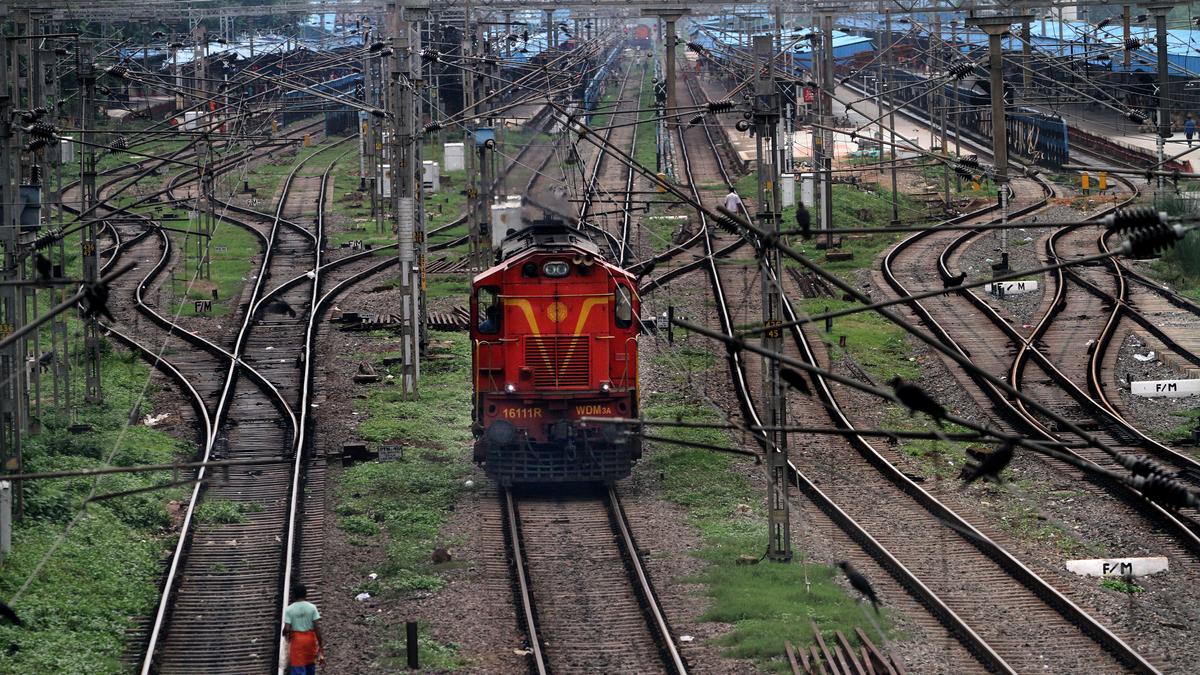
- 19 Dec 2024
Introduction
RITES Ltd., the consultancy arm of the Indian Railways, has secured two contracts to repurpose six broad gauge diesel-electric locomotives for export to African railways. These locomotives, originally designed for India’s broad gauge of 1,676 mm, will be modified for use on railways with the narrower Cape Gauge of 1,067 mm. While this is a commendable re-engineering effort, it also highlights a larger issue within Indian Railways: the unnecessary redundancy of functional diesel locomotives, leading to significant wastage of resources.
The Growing Problem of Idle Diesel Locomotives
As of March 2023, there were 585 diesel locomotives idling across the Indian Railways network due to electrification. This number has now reportedly grown to 760 locomotives, many of which still have more than 15 years of serviceable life. The root cause of this redundancy lies in the government’s mission to electrify the entire broad gauge network at an accelerated pace. This electrification push has resulted in the premature retirement of locomotives that could still serve the network for years, raising questions about the economic and environmental logic behind this decision.
The Justification for Electrification: Foreign Exchange and Environmental Concerns
The Indian government’s electrification drive is often justified on two primary grounds: saving foreign exchange by reducing the import of crude oil and reducing environmental pollution. Additionally, electrification is framed as a step toward a “green railway” powered by renewable energy sources like solar and wind. However, the reality of these claims is more complicated.
Foreign Exchange Savings: A Small Impact on National Diesel Consumption
While electrification may reduce India’s diesel consumption, the impact on national fuel use is minimal. Railways account for just 2% of the country’s total diesel consumption. A report by AC Nielsen in 2014 indicated that the transport sector consumed 70% of the total diesel, with railways accounting for only 3.24%. Even with 100% electrification, the savings in foreign exchange would have little impact on the country’s overall diesel consumption, leaving other sectors like trucking and agriculture as the main contributors.
Environmental Concerns: Shifting Pollution, Not Reducing It
The environmental argument for electrification is also flawed. Electricity in India is still largely generated from coal-fired power plants, with nearly 50% of the country’s electricity coming from coal. Since the Indian Railways is heavily involved in transporting coal, switching from diesel to electric locomotives simply shifts pollution from the tracks to the power plants. This means that the transition to electric traction will not result in a cleaner environment unless the country significantly reduces its reliance on coal. Without a substantial increase in renewable energy generation, the push for a “green railway” remains unrealistic.
The Dilemma of Retaining Diesel Locomotives for Strategic Purposes
Despite the goal of 100% electrification, a significant number of diesel locomotives will remain in service. Reports indicate that 2,500 locomotives will be kept for “disaster management” and “strategic purposes,” although it is unclear why such a large fleet is necessary for these purposes. Additionally, about 1,000 locomotives will continue to operate for several more years to meet traffic commitments. This suggests that even with a fully electrified network, Indian Railways will continue to rely on thousands of diesel locomotives, many of which have substantial residual service life left.
Financial Sustainability and Coal Dependency
The financial sustainability of this transition remains a concern. Currently, the Indian Railways generates a significant portion of its freight revenue from transporting coal—40% of its total freight earnings in 2023-24. If the railways become fully electrified, it will need to find alternative revenue sources, as coal is a primary contributor. Until non-coal freight options can replace this income, the financial health of the railways may be at risk.
Conclusion: Wasted Resources and Unmet Goals
The mission to electrify the Indian Railways, while ambitious, is an example of how vanity projects can lead to colossal waste. Thousands of diesel locomotives are being discarded prematurely, despite their potential to continue serving the network. The environmental and financial justifications for 100% electrification, while appealing in theory, fail to account for the complexities of India’s energy landscape. As a result, the drive to create a “green railway” is likely to fall short, leaving behind a legacy of wasted taxpayer money and unfinished goals.
Analysis of Female Labour Force Participation Rate (LFPR) Trends in India: 2017-2023
- 11 Dec 2024
In News:
The Economic Advisory Council to the Prime Minister (EAC-PM) recently released a working paper revealing critical insights into the trends of female Labour Force Participation Rate (LFPR) in India from 2017-18 to 2022-23. The report highlights an overall increase in female LFPR, with rural areas experiencing more significant growth compared to urban areas. This article delves into the key findings, regional disparities, influencing factors, and government initiatives aimed at promoting female workforce participation.
Key Findings on Female LFPR
The period between 2017-18 and 2022-23 witnessed a notable rise in female LFPR, both in rural and urban regions, though rural areas saw higher gains.
Rural female LFPR surged by approximately 69%, from 24.6% to 41.5%, while urban female LFPR increased from 20.4% to 25.4%. This consistent growth was observed even after excluding unpaid family workers or household helpers, reinforcing the long-term trend of increased female workforce participation across India.
However, a significant point of discussion in the report was the regional variations in female LFPR. States like Bihar, Punjab, and Haryana have consistently reported low female LFPR, which is noteworthy considering that Punjab and Haryana are among India's wealthiest states, while Bihar is the poorest. This regional disparity suggests that economic prosperity does not automatically translate into higher female labour force participation, highlighting deeper socio-cultural and structural barriers.
Regional Disparities in Female LFPR
The report emphasizes the persistent challenges in northern and eastern India. Punjab and Haryana, despite their affluence, have struggled with low female LFPR. Cultural and societal norms in these regions may contribute to the underrepresentation of women in the workforce, particularly in rural areas where traditional gender roles are more entrenched.
On the other hand, Bihar, the poorest state in India, had the lowest female LFPR in the country, particularly in rural areas. However, there has been a significant improvement in recent years, especially among rural married women. This indicates a slow but positive shift in attitudes towards female employment in these states.
In contrast, northeastern states such as Nagaland and Arunachal Pradesh have shown significant improvements in female LFPR, particularly in rural areas. These states have demonstrated that regional and cultural factors can also create conducive environments for female workforce participation.
Demographic Factors Affecting Female LFPR
Several demographic patterns influence female LFPR, including marital status and age. The report notes that married men consistently exhibit higher LFPR compared to women. Marriage, however, has a detrimental impact on female LFPR, particularly in urban areas, where women often face greater familial and societal pressures to prioritize domestic responsibilities over formal employment.
Age dynamics also play a crucial role in female LFPR trends. The data reveals a bell-shaped curve for female participation, peaking around the age of 30-40 years and sharply declining thereafter. This is in stark contrast to male LFPR, which remains almost universally high between the ages of 30-50 before gradually declining. These trends underscore the challenges women face in sustaining their participation in the workforce due to familial responsibilities, especially after marriage and childbirth.
Government Initiatives and the Rise in Female LFPR
The government's focus on women-led development is evident through various schemes aimed at increasing female workforce participation. Programs like Mudra Loans, the Drone Didi Scheme, and the Deendayal Antyodaya Yojana have been particularly instrumental in empowering women, especially in rural areas. These initiatives provide women with access to financial resources, skill development opportunities, and avenues for entrepreneurship, all of which contribute to the rise in female LFPR.
The EAC-PM's analysis acknowledges the positive impact of these government schemes, but it also stresses the need for further research to evaluate their long-term effectiveness. While the descriptive analysis highlights a substantial increase in female LFPR between 2017-18 and 2022-23, especially in rural areas, there remains a need for continuous monitoring and assessment of these schemes to ensure their sustained impact.
Conclusion: A Positive Shift, but Challenges Remain
The increase in female LFPR across India from 2017-18 to 2022-23 signals a positive shift in employment trends, particularly in rural areas. However, regional disparities, societal norms, and demographic factors continue to pose challenges. The rise in female LFPR is encouraging, but it is essential to understand the deeper socio-economic factors that shape women's participation in the workforce.
Government schemes have contributed to this growth, but future research is necessary to gauge their long-term effects and ensure that women’s participation in the workforce is not just a short-term trend. It is crucial that the government continues to refine policies that support women in overcoming socio-cultural and economic barriers, especially in less prosperous states like Bihar, Punjab, and Haryana. Sustained efforts, including education, skill development, and gender-sensitive policies, will be key to ensuring that the rise in female LFPR is both inclusive and long-lasting.
The analysis by the EAC-PM provides an essential framework for policymakers to design more targeted interventions to address regional disparities and create a more inclusive labor market for women in India.
Building on the Revival of the Manufacturing Sector

- 07 Dec 2024
In News:
India’s manufacturing sector has shown remarkable signs of recovery and growth, thanks to strategic policy initiatives like the Production Linked Incentive (PLI) scheme. To fully capitalize on this momentum and become a global manufacturing hub, however, deeper reforms are needed.
The Success of the PLI Scheme: A Catalyst for Growth
The government’s PLI scheme has been instrumental in revitalizing key sectors like electronics, pharmaceuticals, automobiles, and textiles. It has not only boosted production but also increased exports and job creation. According to the Annual Survey of Industries (ASI) 2022-23, manufacturing output grew by an impressive 21.5%, while gross value added (GVA) increased by 7.3%. Sectors such as basic metals, refined petroleum products, food products, and motor vehicles, which are beneficiaries of the PLI scheme, contributed 58% of total manufacturing output, registering growth of 24.5%.
This success underlines the potential of India’s manufacturing sector, with the PLI scheme acting as a key enabler. However, while the recovery is promising, there are significant challenges to overcome to sustain long-term growth.
Expanding PLI Incentives to New Sectors
The PLI scheme has largely benefitted traditional industries like electronics and automotive manufacturing. To further accelerate growth, the scope of the scheme must be extended to labour-intensive sectors such as apparel, footwear, and furniture, which hold immense potential for job creation. Additionally, emerging sectors like aerospace, space technology, and maintenance, repair, and overhaul (MRO) services offer new avenues for growth. By diversifying the incentive structure to these sectors, India could establish a more robust and resilient manufacturing ecosystem.
In sectors like capital goods, where India is heavily import-dependent, the potential for reducing supply chain vulnerabilities is significant. Moreover, promoting green manufacturing and advanced technologies could further bolster India’s competitiveness in global markets.
Addressing the Divergence Between Output and Value Addition
Despite a surge in production, India’s gross value added (GVA) has not kept pace with output growth. The ASI data shows that input prices soared by 24.4% in 2022-23, indicating that while production volumes are up, industries are grappling with high input costs. A more streamlined import regime could mitigate these costs. Simplifying tariffs into a three-tier system (for raw materials, intermediates, and finished goods) would reduce input costs, enhance competitiveness, and improve integration into global value chains.
Regional Imbalance: A Barrier to Inclusive Growth
The manufacturing sector’s growth is heavily concentrated in a few states such as Maharashtra, Gujarat, Tamil Nadu, Karnataka, and Uttar Pradesh, which account for over 54% of manufacturing GVA. This concentration not only restricts equitable development but also hampers the overall growth potential of the sector. To address this, it is crucial that states actively participate in India's manufacturing growth story by implementing market reforms in land, labour, and power. Additionally, infrastructure development and investment promotion in less industrialized regions could help balance growth and ensure that the benefits of manufacturing reach all corners of the country.
Fostering MSME Growth and Enhancing Female Workforce Participation
Micro, small, and medium enterprises (MSMEs) contribute about 45% of India’s manufacturing GDP and employ around 60 million people. To scale these businesses and integrate them into global value chains, PLIs should be tailored to accommodate their needs, such as lowering capital investment thresholds and reducing production targets.
Equally important is the enhancement of female workforce participation. Studies suggest that India’s manufacturing output could increase by 9% if more women enter the workforce. The development of supportive infrastructure, such as hostels and childcare facilities, can play a pivotal role in enabling women’s participation, thus driving inclusive growth.
Conclusion: The Path Forward
To transform into a developed economy by 2047, India must continue to focus on strengthening its manufacturing sector. According to industry estimates, manufacturing’s share in Gross Value Added (GVA) can rise from 17% to 25% by 2030 and further to 27% by 2047. Achieving this will require sustained efforts to enhance competitiveness through business reforms, cost reduction, and policy support. India is well-positioned to harness its manufacturing potential, but timely and focused interventions are necessary to turn this vision into reality.
Scrapping of Windfall Gains Tax
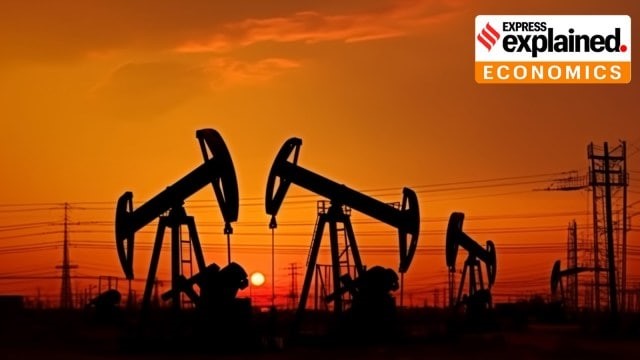
- 05 Dec 2024
Introduction
On December 2, 2024, the Indian government withdrew the windfall gains tax on domestic crude oil production and fuel exports (diesel, petrol, and aviation turbine fuel - ATF). This tax, initially imposed in July 2022, was introduced in response to the surge in global oil prices following Russia's invasion of Ukraine. Its removal reflects the current global oil market stability and the improved fuel supply situation in India.
What is Windfall Gains Tax?
Definition
A windfall tax is a levy imposed on unexpected profits that result from extraordinary events, such as geopolitical crises or market disruptions. In the case of India, the tax was applied to the super-normal profits of oil producers and fuel exporters due to the global energy turmoil.
Key Features
- Domestic Crude Oil: The Special Additional Excise Duty (SAED) was imposed on domestic crude oil production.
- Fuel Exports: A combination of SAED and Road and Infrastructure Cess (RIC) was levied on diesel, petrol, and ATF exports.
Rationale Behind the Windfall Gains Tax
Immediate Context
The tax was introduced during a period of soaring global crude oil prices, driven by the Russia-Ukraine conflict. India, which imports over 85% of its oil, faced concerns about the availability of fuels and the impact of rising prices on domestic consumption. The tax was seen as a way to:
- Ensure Domestic Fuel Supply: By discouraging excessive fuel exports during a period of global supply chain disruptions.
- Increase Government Revenue: The tax aimed to capture windfall profits and offset the duty cuts on domestic fuel sales.
Global Context
Other countries also implemented similar windfall taxes during this period, as energy companies saw record profits due to the price surge.
Decline in Windfall Gains Tax Revenue
Revenue Collection
The windfall gains tax initially raised significant revenue, but the amount has decreased over time due to falling global oil prices:
- FY 2022-23: Rs 25,000 crore
- FY 2023-24: Rs 13,000 crore
- FY 2024-25 (so far): Rs 6,000 crore
This decline, combined with reduced oil prices, led to the tax being effectively inactive before its formal withdrawal.
Withdrawal of the Windfall Gains Tax
Reasons for the Withdrawal
- Global Stabilization: Crude oil prices, which had exceeded $100 per barrel, have now stabilized under $75 per barrel, with no immediate signs of a significant price surge.
- Domestic Fuel Availability: There is now a robust fuel supply in the domestic market, making the tax less necessary.
- Declining Revenues: With the tax generating diminishing returns, it was no longer economically viable for the government to maintain it.
Impact of the Scrapping
The government's move to scrap the windfall gains tax is seen as a signal of stability and predictability in the taxation regime. It assures the oil industry that the government is confident in the stability of global oil prices and supply chains.
Criticism of the Windfall Tax
Industry Opposition
The windfall tax faced opposition from the oil industry, which argued that it:
- Reduced Profitability: The tax limited the profits of publicly listed companies like ONGC and Reliance Industries.
- Discouraged Oil Production: By making the taxation environment unpredictable, it deterred investment in oil exploration and production in a country that is heavily dependent on oil imports.
- Created Uncertainty: Frequent revisions of the tax led to an unstable business environment.
Conclusion
The scrapping of the windfall gains tax is a significant policy shift. It not only provides relief to oil companies but also signals a more predictable and stable taxation regime. By withdrawing the tax, the government is fostering a conducive environment for future investments in domestic oil production and signaling its confidence in the stability of global oil prices. This move is a crucial step in ensuring that India’s energy policies remain adaptable and aligned with the evolving global market conditions.
India's Gig Economy: Growth and Impact on Employment

- 03 Dec 2024
Introduction
India’s gig economy is experiencing rapid growth, with projections indicating it will significantly contribute to the national economy and employment generation. A recent report by the Forum for Progressive Gig Workers estimates the gig economy could reach $455 billion by the end of 2024, growing at a 17% compounded annual growth rate (CAGR). By 2030, it may add 1.25% to India’s GDP and create 90 million jobs.
What is the Gig Economy?
- Definition: The gig economy refers to a labor market based on short-term, flexible jobs, typically facilitated by digital platforms. Gig workers, also called freelancers or independent contractors, are compensated for each task they complete.
- Key Features:
- Flexibility in work schedule and location.
- Task-based employment through digital platforms.
- Common sectors: e-commerce, transportation, delivery services, and freelance work.
Status of the Gig Economy in India
- Market Growth:
- In 2020-21, India had 7.7 million gig workers, which is expected to grow to 23.5 million by 2029-30.
- Key sectors contributing to growth include e-commerce, transportation, and delivery services.
- Driving Factors:
- Digital Penetration: With over 936 million internet subscribers and 650 million smartphone users, digital infrastructure is a key enabler of the gig economy.
- Startup and E-commerce Growth: The rise of startups and e-commerce platforms has increased demand for flexible labor.
- Changing Work Preferences: Younger generations seek work-life balance, opting for flexible gig work.
Gig Economy and Employment Generation
- Contribution to GDP: The gig economy is expected to contribute 1.25% to India’s GDP by 2030.
- Job Creation:
- The gig economy could create up to 90 million jobs by 2030.
- It is estimated that by 2030, gig workers will comprise 4.1% of India’s total workforce.
- Benefits:
- Women’s Empowerment: Gig work provides financial independence and flexibility, especially benefiting women in the workforce.
- Regional Growth: Tier-II and Tier-III cities are seeing accelerated growth in gig work opportunities.
Challenges Faced by Gig Workers
- Job Insecurity: Many gig workers experience instability in their employment, especially in low-skilled jobs.
- Income Volatility: Earnings are unpredictable, and workers face difficulty in financial planning.
- Regulatory Gaps: There is no comprehensive legal framework to protect gig workers’ rights and ensure fair working conditions.
- Delayed Payments: A significant number of workers face delayed payments, affecting their financial well-being.
- Skill Development: Many workers report a lack of opportunities for career advancement and skill development.
Government Initiatives for Gig Workers
- Code on Social Security, 2020: Recognizes gig workers and aims to extend social security benefits, though it lacks comprehensive coverage.
- e-Shram Portal & Welfare Schemes: Initiatives like Pradhan Mantri Shram Yogi Maandhan Yojana and PMJJBY aim to provide financial security to gig workers.
- State-level Initiatives:
- Rajasthan’s Platform-Based Gig Workers Act (2023) focuses on registration and welfare.
- Karnataka’s bill mandates formal registration and grievance mechanisms.
The Way Forward
- Legal Reforms: India can draw from international models like California and the Netherlands, where gig workers are reclassified as employees to ensure protections such as minimum wages and regulated working hours.
- Portable Benefits System: Implementing a system where gig workers can access benefits like healthcare and retirement plans regardless of their employer.
- Skill Development: Strengthening collaborations with vocational institutions to enhance skills and improve earning potential.
- Technological Solutions: Establishing robust feedback mechanisms for workers to report exploitation and ensure fairness within the gig economy.
Conclusion
The gig economy in India is poised to become a significant driver of economic growth and job creation. However, addressing challenges such as income volatility, job insecurity, and regulatory gaps is crucial to ensuring sustainable growth.
National Mission on Natural Farming (NMNF)
- 29 Nov 2024
In News:
The Union Cabinet recently approved the launch of the National Mission on Natural Farming (NMNF), marking a significant shift in the government's approach to agriculture. This initiative, a standalone Centrally Sponsored Scheme under the Ministry of Agriculture & Farmers' Welfare, aims to promote natural farming across India, focusing on reducing dependence on chemical fertilizers and promoting environmentally sustainable practices.
What is Natural Farming?
Natural farming, as defined by the Ministry of Agriculture, is a chemical-free agricultural method that relies on inputs derived from livestock and plant resources. The goal is to encourage farmers to adopt practices that rejuvenate soil health, improve water use efficiency, and enhance biodiversity, while reducing the harmful effects of fertilizers and pesticides on human health and the environment. The NMNF will initially target regions with high fertilizer consumption, focusing on areas where the need for sustainable farming practices is most urgent.
Evolution of Natural Farming Initiatives
The NMNF is not an entirely new concept but a scaled-up version of the Bhartiya Prakritik Krishi Paddhti (BPKP) introduced during the NDA government's second term (2019-24). The BPKP was part of the larger Paramparagat Krishi Vikas Yojna (PKVY) umbrella scheme, and natural farming was also promoted along the Ganga River under the NamamiGange initiative in 2022-23. With the renewed focus on natural farming following the 2024 elections, the government aims to extend the lessons learned from BPKP into a comprehensive mission mode, setting a clear direction for sustainable agriculture.
In Budget speech for 2024-25, it was announced a plan to initiate one crore farmers into natural farming over the next two years. The mission will be implemented through scientific institutions and willing gram panchayats, with the establishment of 10,000 bio-input resource centers (BRCs) to ensure easy access to the necessary inputs for natural farming.
Key Objectives
The NMNF aims to bring about a paradigm shift in agricultural practices by:
- Expanding Coverage: The mission plans to bring an additional 7.5 lakh hectares of land under natural farming within the next two years. This will be achieved through the establishment of 15,000 clusters in gram panchayats, benefiting 1 crore farmers.
- Training and Awareness: The mission will establish around 2,000 model demonstration farms at Krishi Vigyan Kendras (KVKs), Agricultural Universities (AUs), and farmers' fields. These farms will serve as hubs for training farmers in natural farming techniques and input preparation, such as Jeevamrit and Beejamrit, using locally available resources.
- Incentivizing Local Inputs: The creation of 10,000 bio-input resource centers will provide farmers with easy access to bio-fertilizers and other natural farming inputs. The mission emphasizes the use of locally sourced inputs to reduce costs and improve the sustainability of farming practices.
- Farmer Empowerment: 30,000 Krishi Sakhis (community resource persons) will be deployed to assist in mobilizing and guiding farmers. These trained individuals will play a key role in generating awareness and providing on-ground support to the farmers practicing natural farming.
- Certifications and Branding: A major aspect of the mission is to establish scientific standards for natural farming produce, along with a national certification system. This will help in creating a market for organically grown produce and encourage more farmers to adopt sustainable practices.
Targeting High Fertilizer Consumption Areas
The Ministry of Agriculture has identified 228 districts in 16 states, including Uttar Pradesh, Punjab, Maharashtra, and West Bengal, where fertilizer consumption is above the national average. These districts will be prioritized for the NMNF rollout, as they have high fertilizer usage but low adoption of natural farming practices. By focusing on these areas, the mission seeks to reduce the over-dependence on chemical fertilizers and foster a transition to more sustainable farming practices.
Benefits of Natural Farming
The NMNF aims to deliver multiple benefits to farmers and the environment:
- Cost Reduction: Natural farming practices can significantly reduce input costs by decreasing the need for costly chemical fertilizers and pesticides.
- Soil Health and Fertility: By rejuvenating the soil through organic inputs, natural farming improves soil structure, fertility, and microbial activity, leading to long-term agricultural sustainability.
- Climate Resilience: Natural farming enhances resilience to climate-induced challenges such as drought, floods, and waterlogging.
- Healthier Produce: Reduced use of chemicals results in safer, healthier food, benefitting both farmers and consumers.
- Environmental Conservation: The promotion of biodiversity, water conservation, and carbon sequestration in soil leads to a healthier environment for future generations.
Conclusion
The launch of the National Mission on Natural Farming represents a critical step toward transforming India's agricultural practices into a more sustainable and environmentally friendly model. By targeting regions with high fertilizer usage, providing farmers with the tools and knowledge for natural farming, and creating a system for certification and branding, the government hopes to make natural farming a mainstream practice. As India continues to grapple with the challenges of climate change, soil degradation, and health risks from chemical inputs, the NMNF provides a promising framework for sustainable agriculture that benefits farmers, consumers, and the environment alike.
India’s Urban Infrastructure
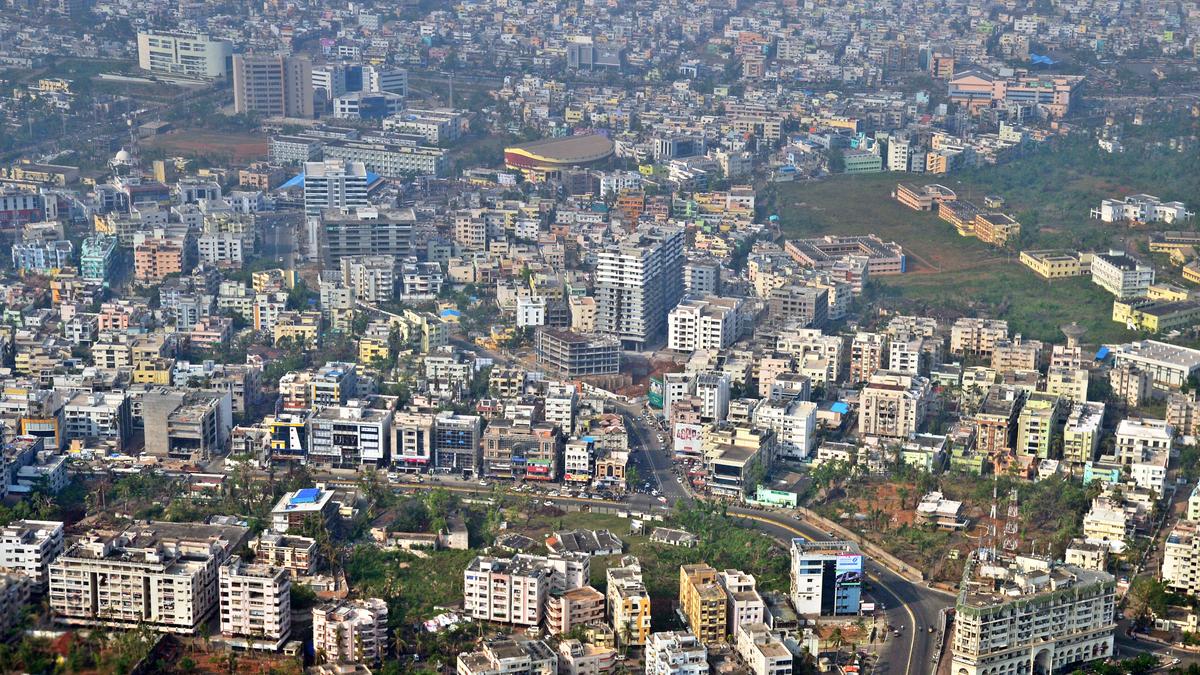
- 28 Nov 2024
Introduction
India’s urban population is projected to double from 400 million to 800 million by 2050. This demographic shift presents both challenges and opportunities for transforming the country’s urban infrastructure. To meet the growing needs of urban areas, India will require an investment of approximately ?70 lakh crore by 2036, a figure significantly higher than current spending levels.
Financial Challenges in Urban Infrastructure
- Investment Gap
- The current annual investment in urban infrastructure stands at ?1.3 lakh crore, which is only 28% of the ?4.6 lakh crore needed annually.
- A large portion of the existing investment, around 50%, is directed towards basic urban services, with the remainder allocated to urban transport.
- Municipal Finances
- Municipal finances have remained stagnant at 1% of GDP since 2002.
- Despite increased transfers from the central and state governments, municipal bodies face financial strain.
- The contribution of municipal own-revenue has decreased from 51% to 43%, indicating a reduced financial independence.
- Revenue Collection Inefficiencies
- Urban local bodies (ULBs) are collecting only a small fraction of their potential revenues, with property tax collections representing just 0.15% of GDP.
- Cost recovery for essential services like water supply and waste management ranges between 20% and 50%, pointing to a significant funding gap.
- Underutilization of Resources
- Cities like Hyderabad and Chennai utilized only 50% of their capital expenditure budgets in 2018-19.
- Central schemes such as AMRUT and the Smart Cities Mission also showed suboptimal fund utilization, with utilization rates of 80% and 70%, respectively.
- Decline in Public-Private Partnerships (PPPs)
- Investments through PPPs in urban infrastructure have seen a sharp decline, from ?8,353 crore in 2012 to ?467 crore in 2018.
- This drop is attributed to limited project-specific revenues and inadequate funding mechanisms.
Structural and Administrative Challenges
- Weak Governance and Fragmented Management
- Fragmented governance and limited administrative autonomy hinder effective urban planning and resource allocation.
- Municipal bodies often lack the ability to undertake long-term planning and project execution due to these governance challenges.
- Climate Vulnerability and Sustainability: Urban areas are increasingly vulnerable to climate risks like floods and heatwaves. However, many urban infrastructure projects fail to incorporate climate resilience in their planning, exacerbating the long-term vulnerability of investments.
- Inadequate Land Management
- There is poor coordination between land use planning and infrastructure development, resulting in urban sprawl and inefficient transportation systems.
- Opportunities to capitalize on the land value generated by metro and rail projects remain underutilized.
Measures for Transforming Urban Infrastructure
- Streamline Revenue Collection: Leverage technology to improve property tax collection systems and enhance cost recovery in essential services.
- Enhance Fund Utilization: Strengthen municipal capacities for effective project planning and incentivize the timely use of allocated grants.
- Scale Public-Private Partnership (PPP) Investments: Develop a pipeline of bankable projects and create risk-sharing mechanisms to attract private sector investments.
- Decouple Project Preparation from Funding: Ensure that infrastructure projects are thoroughly prepared for financial, social, and environmental sustainability before seeking funding.
- Promote Urban Innovation: Establish urban innovation labs and encourage public-private-academic collaborations to foster the adoption of advanced technologies.
- Empower Municipalities: Grant municipalities greater financial autonomy, enabling them to raise capital through municipal bonds and other debt mechanisms.
- Integrated Urban Planning: Align infrastructure development with land use, transport, and housing requirements, while integrating climate resilience into planning.
- Capacity Building: Invest in the training of municipal staff to improve governance and financial management capabilities.
Conclusion
India’s expanding urban population presents a major opportunity for economic growth. However, addressing the financial and structural challenges in urban infrastructure is crucial for harnessing this potential. By adopting a combination of short-term actions, medium-term strategies, and long-term reforms, India can create sustainable, resilient urban infrastructure that meets the growing needs of its cities, fostering inclusive development and long-term prosperity.
RBI brings back 102 tonnes gold from BoE; 60 per cent reserves in India

- 04 Nov 2024
In News:
England over the past two-and-a-half years, reflecting a strategic shift in its approach to safeguarding gold reserves. This move marks a significant increase in the RBI's domestic gold holdings.
Rise in the RBI's Domestic Gold Holdings
- Current Status (September 2024):The RBI's domestic gold reserves have grown to 510.46 metric tonnes, up from 295.82 metric tonnes in March 2022.
- Reduction in Gold Held Abroad:The gold held under the custodianship of the Bank of England has decreased to 324 metric tonnes from 453.52 metric tonnes in March 2022.
- Gold as a Share of Foreign Exchange Reserves:The proportion of gold in India's total foreign exchange reserves increased from 8.15% in March 2024 to 9.32% in September 2024.
Gold Kept in the Bank of England
- Overview of the Bank of England's Gold Vault:The Bank of England is home to one of the largest gold vaults in the world, second only to the New York Federal Reserve, housing around 400,000 bars of gold.
- India’s Gold Held Abroad:The RBI continues to retain 324 metric tonnes of its gold with the Bank of England and the Bank for International Settlements (BIS).
- Additional Gold Management:Around 20 tonnes of gold are managed through gold deposit schemes.
- Strategic Role of London’s Gold Market:Storing gold in London provides immediate access to the global London bullion market, enhancing liquidity for India’s gold assets.
Historical Context of India’s Gold Holdings
- 1991 Balance of Payments Crisis:During a financial crisis in 1991, India had to send 47 tonnes of gold to the Bank of England to secure loans for repaying international creditors.
RBI’s Strategy to Bring Gold Back to India
- Global Trend of Central Banks Buying Gold:Since the imposition of U.S. sanctions on Russia in 2022, central banks globally have been increasing their gold reserves as a hedge against inflation and to reduce reliance on the U.S. dollar. India has outpaced other G20 nations in this trend, surpassing Russia and China in gold purchases.
- De-dollarisation:This shift is part of a broader strategy of de-dollarisation, aiming to diversify away from the U.S. dollar amidst rising gold prices and growing geopolitical tensions.
Significance of Repatriating Gold to India
- Sign of Economic Strength
- Recovery from the 1991 Crisis:The decision to repatriate gold reflects a significant improvement in India's economic position, a stark contrast to the 1991 economic crisis when India had to pledge gold for financial survival.
- Optimizing Financial Resources
- Reducing Storage Costs:Storing gold domestically allows the RBI to save on storage fees paid to foreign custodians, such as the Bank of England.
- Strategic Significance
- Enhanced Resilience Amid Global Instability:By repatriating its gold, India enhances its strategic autonomy and strengthens its economic position in a world of rising uncertainties and currency volatility.
RBI's Capacity to Safeguard Gold Domestically
- Increasing Domestic Storage Capacity:The RBI has been increasing its domestic capacity for gold storage to accommodate rising reserves and reduce dependence on foreign gold safekeeping facilities.
- Current Foreign Exchange Reserves:As of October 2024, India’s total foreign exchange reserves stand at $684.8 billion, sufficient to cover over 11.2 months of imports.
Diversification of Foreign Exchange Reserves
- Mitigating Currency Risks:By increasing gold reserves, India diversifies its foreign exchange holdings, reducing reliance on any single currency and shielding itself from global currency fluctuations and economic volatility.
- Gold as a Stable Asset:Gold serves as a stable asset, providing a safeguard against global economic shocks, and balances India’s reserves portfolio.
Gold as a Hedge against Inflation
- Preserving Wealth amid Inflation:Gold is traditionally viewed as a hedge against inflation, maintaining or appreciating in value when other currencies weaken. By increasing its gold reserves, India positions itself to better withstand the adverse effects of inflation and ensure long-term financial stability.
Conclusion
The repatriation of gold by the RBI reflects a strategic move to bolster India's economic strength and diversify its financial assets. The decision to bring gold back to India not only signifies an improvement in India's economic fundamentals but also aligns with global trends of central banks increasing their gold reserves to ensure long-term stability and reduce reliance on the U.S. dollar.
Analysis of Growing Economic Divide in India

- 29 Oct 2024
Overview
The Economic Advisory Council to the Prime Minister (EAC-PM)'s report titled "Relative Economic Performance of Indian States: 1960-61 to 2023-24" highlights an alarming trend of widening economic disparities across India's states, which is increasingly threatening the principles of federalism and national unity. The findings reveal significant regional imbalances in terms of contributions to the national income, per capita income, and overall economic development. This analysis delves into the key insights from the report and explores the broader implications for India's federal structure, governance, and policy approaches.
Key Insights from the Report
- Regional Economic Disparities:
- Western and Southern States' Dominance: States such as Maharashtra, Gujarat, Tamil Nadu, and Karnataka have consistently outperformed others. These states have benefited from higher private investments, better infrastructure, and a more business-friendly environment. They also enjoy proximity to international markets, especially coastal regions like Gujarat and Tamil Nadu, which have access to ports and export markets.
- Underperformance of Northern and Eastern States: On the other hand, northern states (with exceptions like Delhi and Haryana) and eastern states like Bihar, Odisha, and West Bengal lag behind in economic performance. These regions face challenges such as poor infrastructure, low levels of investment, and weak governance structures, which hinder their growth potential.
- Impact of Liberalization (1991):
- The 1991 economic reforms marked a shift toward market-oriented growth, benefiting states that were already more industrialized or had better urban infrastructure. Southern states, in particular, adapted well to the liberalized environment, attracting higher levels of private investment and expanding their economies.
- The liberalization process disproportionately favored urban centers like Delhi, Mumbai, Chennai, and Bengaluru, where investments were channelized into growing service sectors, technology, and industries, creating a feedback loop of wealth accumulation in these hubs. Meanwhile, the hinterland remained underdeveloped due to insufficient public investment and the lack of private sector interest in these regions.
- Investment Disparities:
- Private Investment: Wealthier states attract a disproportionate share of private investment, which is driven by profitability and market opportunities. These states have better infrastructure, which reduces transaction costs and increases returns on investment. In contrast, underdeveloped states struggle to attract investment due to poor governance, inadequate infrastructure, and perceived higher risks.
- Public Investment: While the public sector still plays a role in investment, the New Economic Policies (NEP) since 1991 have shifted the focus towards private sector-driven growth. This has further widened the investment gap, as the poorer states receive less public investment relative to their needs.
- Role of Infrastructure and Governance:
- The availability and quality of infrastructure are significant determinants of economic performance. States with better roads, energy supply, ports, and communication networks tend to attract more investments. Additionally, good governance, characterized by reduced corruption, better policy implementation, and transparency, also plays a critical role in fostering economic development.
- In contrast, states with weaker governance structures and poor infrastructure struggle to create an enabling environment for businesses, further compounding regional disparities.
- Impact on Federalism:
- The growing economic divide is leading to tensions between the Centre and state governments, particularly in wealthier states that contribute significantly to national income but feel short-changed in resource allocation. These states argue that they are not receiving a fair share of national resources in return for their contributions, leading to growing dissatisfaction with the federal system.
- The tension is exacerbated by political factors, such as accusations from opposition-led states that the Centre uses public investment to favor states aligned with the ruling party. The growing perception of politicization of resource allocation has the potential to undermine the spirit of cooperative federalism.
Structural Causes of Regional Inequality
- Economic and Investment Magnetism:
- Wealthier states attract more private investments, as they offer better returns due to established markets, skilled labor, and urbanization. Cities like Mumbai, Delhi, and Bengaluru serve as economic magnets, drawing talent, technology, and capital, which further consolidates their economic dominance.
- In contrast, states without such economic hubs or access to global markets struggle to attract investment. The absence of urban agglomerations and the concentration of wealth and resources in a few states perpetuate regional disparities.
- Policy and Investment Bias:
- Post-liberalization policies have disproportionately benefited the organized sector, often at the expense of the unorganized sector, which is more prevalent in poorer states. The emphasis on industrial growth and infrastructure development has largely bypassed the rural and informal sectors, which are critical in underdeveloped states.
- The organized sector has also benefited from government support, such as tax concessions and subsidized infrastructure, which have enabled these industries to thrive in already developed regions. This has widened the gap between the haves and the have-nots.
- Cronyism and the Black Economy:
- Crony capitalism and the prevalence of the black economy in poorer states further exacerbate regional imbalances. In some cases, political patronage and corruption divert resources and investments from areas that need them most. This weakens the investment climate, especially in states with higher levels of informal and illegal economic activity.
Implications for Federalism
The growing economic disparity poses a serious threat to India's federal structure. The increasing dissatisfaction of wealthier states with the current fiscal arrangements and the growing demand for fairer resource allocation challenge the spirit of cooperative federalism. A well-functioning federal system relies on equitable distribution of resources and opportunities for all regions to develop.
Policy Recommendations
To address these disparities and strengthen India's federal framework, several policy measures need to be implemented:
- Enhancing Governance and Infrastructure in Lagging States:
- Improved governance and reducing corruption are essential in attracting both private and public investments. Additionally, there must be a focus on developing critical infrastructure, such as roads, energy, and health facilities, which are essential for economic growth.
- States need to increase public investment in sectors like education, healthcare, and social security to improve human capital and productivity.
- Focus on the Unorganized Sector:
- A significant portion of the labor force in poorer states is employed in the unorganized sector. Policies should aim to formalize this sector by providing social security benefits, improving labor rights, and increasing productivity through skill development. This could help raise incomes and stimulate local demand, attracting more private investment.
- Balancing the Organized and Unorganized Sectors:
- While the organized sector has benefited from liberalization, more attention should be given to the unorganized sector, which forms the backbone of the economy in many poorer states. A balanced approach to economic growth, which includes both organized and unorganized sectors, can help reduce disparities.
- Shifting Focus from Urban Centers to Hinterlands:
- Private sector investment must be incentivized in underdeveloped regions through tax breaks, subsidies, and targeted infrastructure projects. This will encourage businesses to expand beyond the major urban centers, thus promoting a more balanced distribution of economic activities.
Conclusion
The widening economic divide in India, as revealed by the EAC-PM report, poses a significant challenge to the country's federalism and unity. To ensure inclusive and balanced development, policy reforms must focus on reducing regional disparities by improving governance, infrastructure, and investment in lagging states. A shift towards equitable growth, addressing the needs of both the organized and unorganized sectors, is essential to promoting national cohesion and ensuring sustainable economic progress across all regions.
Pradhan Mantri Mudra Yojana (PMMY)

- 27 Oct 2024
Introduction
The Pradhan Mantri Mudra Yojana (PMMY) was launched by Prime Minister Narendra Modi on April 8, 2015, with the aim of providing financial support to non-corporate, non-farm small and micro enterprises in India. Through this initiative, loans are provided to individuals and small businesses who are unable to access formal institutional finance.
In the Union Budget 2024-25, Finance Minister Nirmala Sitharaman announced an increase in the loan limit under PMMY from ?10 lakh to ?20 lakh, with the introduction of a new loan category, Tarun Plus, aimed at fostering growth in the entrepreneurial sector.
Key Features of the Pradhan Mantri Mudra Yojana
Loan Limit Increase
- Loan Limit Raised: The loan limit has been increased from ?10 lakh to ?20 lakh for eligible entrepreneurs.
- New Loan Category: The newly introduced Tarun Plus category caters to entrepreneurs who have previously availed and successfully repaid loans under the Tarun category.
- Credit Guarantee: The Credit Guarantee Fund for Micro Units (CGFMU) will cover these enhanced loans, further ensuring the security of micro-enterprises.
Categories of MUDRA Loans
PMMY provides collateral-free loans through financial institutions like Scheduled Commercial Banks, Regional Rural Banks (RRBs), Small Finance Banks (SFBs), Non-Banking Financial Companies (NBFCs), and Micro Finance Institutions (MFIs). These loans are provided for income-generating activities in sectors like manufacturing, trading, services, and allied agriculture activities.
Objectives of PMMY
- Financial Inclusion: PMMY targets marginalized and socio-economically neglected sections of society, promoting financial inclusivity.
- Support to Small Businesses: By providing affordable loans, the scheme encourages small-scale entrepreneurs, particularly women and minority groups, to establish and expand their businesses.
- Fostering Entrepreneurship: PMMY aims to unlock the potential of India’s entrepreneurial spirit, especially in rural and underserved areas.
MUDRA: The Institutional Backbone
Role of Micro Units Development & Refinance Agency Ltd. (MUDRA)
MUDRA is the primary institution set up by the Government of India to manage and implement the Mudra Yojana. It acts as a refinancing agency that provides financial support to small and micro-enterprises by working through financial intermediaries, such as banks and micro-finance institutions.
Funding Sources
- Scheduled Commercial Banks
- Regional Rural Banks (RRBs)
- Small Finance Banks (SFBs)
- Non-Banking Financial Companies (NBFCs)
- Micro Finance Institutions (MFIs)
Application Process
Applicants can avail loans through any of the aforementioned financial institutions or apply online via the Udyami Mitra Portal.
Benefits of Pradhan Mantri Mudra Yojana
- Collateral-free Loans: No security is required to obtain loans, which reduces the financial burden on borrowers.
- Easily Accessible: PMMY loans are available across India, making them accessible to entrepreneurs in both rural and urban areas.
- Quick and Flexible Loans: Loans can be disbursed quickly with flexible repayment terms (up to 7 years).
- Empowering Women Entrepreneurs: The scheme offers special incentives for women entrepreneurs, helping them to establish and grow their businesses.
- Support to Rural Areas: Special emphasis on empowering rural enterprises and reducing regional disparities.
- MUDRA Card: The MUDRA Card is a RuPay debit card that allows borrowers to access funds through an overdraft facility, enhancing liquidity for businesses.
- No Default Penalty: In case of loan defaults due to unforeseen circumstances, the government will step in to reduce the burden on entrepreneurs.
Categories of Loans Under PMMY
1. Shishu Category: Loans up to ?50,000
- Targeted at micro-enterprises at the initial stage of their business journey.
2. Kishore Category: Loans between ?50,000 and ?5 lakh
- Targeted at enterprises looking to expand their operations and upgrade their infrastructure.
3. Tarun Category: Loans between ?5 lakh and ?10 lakh
- For established businesses that are in need of funds to scale up.
4. Tarun Plus: Loans between ?10 lakh and ?20 lakh
- A new category designed for entrepreneurs who have repaid loans under the Tarun category and wish to further expand their business.
Achievements of PMMY (2023-24)
- Total Loans Sanctioned: ?5.4 trillion across 66.8 million loans in FY 2023-24.
- Loans Disbursed: Significant amounts were disbursed under each category:
- Shishu: ?1,08,472.51 crore
- Kishore: ?1,00,370.49 crore
- Tarun: ?13,454.27 crore
- Women Borrowers: A large share of loans have gone to women entrepreneurs, ensuring gender inclusivity.
- Minority Borrowers: The scheme also emphasizes financial empowerment of minority communities.
- NPA Reduction: The Non-Performing Assets (NPA) in Mudra loans have reduced to 3.4% in FY 2024, compared to higher levels in earlier years.
Digital Tools and Support Systems
MUDRA MITRA App
The MUDRA MITRA mobile app helps users access information about the PMMY scheme, loan application procedures, and other resources. The app is available for download on Google Play Store and Apple App Store.
Online Loan Application
Entrepreneurs can apply for loans online via portals such as PSBloansin59minutes and Udyamimitra, providing greater convenience and accessibility.
Steps to Improve Implementation
- Handholding Support: Assistance in submitting loan applications is available for applicants.
- Intensive Awareness Campaigns: The government conducts publicity campaigns to raise awareness about PMMY.
- Simplified Loan Process: The loan application forms have been simplified to encourage wider participation.
- Performance Monitoring: Regular monitoring of PMMY implementation to ensure its success.
- Interest Subvention: A 2% interest subvention is offered for prompt repayment of Shishu loans.
Conclusion
The Pradhan Mantri Mudra Yojana has been a transformative scheme in fostering entrepreneurship and ensuring financial inclusion for small and micro-businesses across India. With the recent increase in loan limits and the addition of the Tarun Plus category, the scheme continues to empower emerging entrepreneurs and provides a crucial lifeline for business growth and sustainability. By supporting women, minorities, and new entrepreneurs, PMMY has contributed significantly to economic upliftment and inclusive growth in the country.
What are the stress factors for Indian Railways?
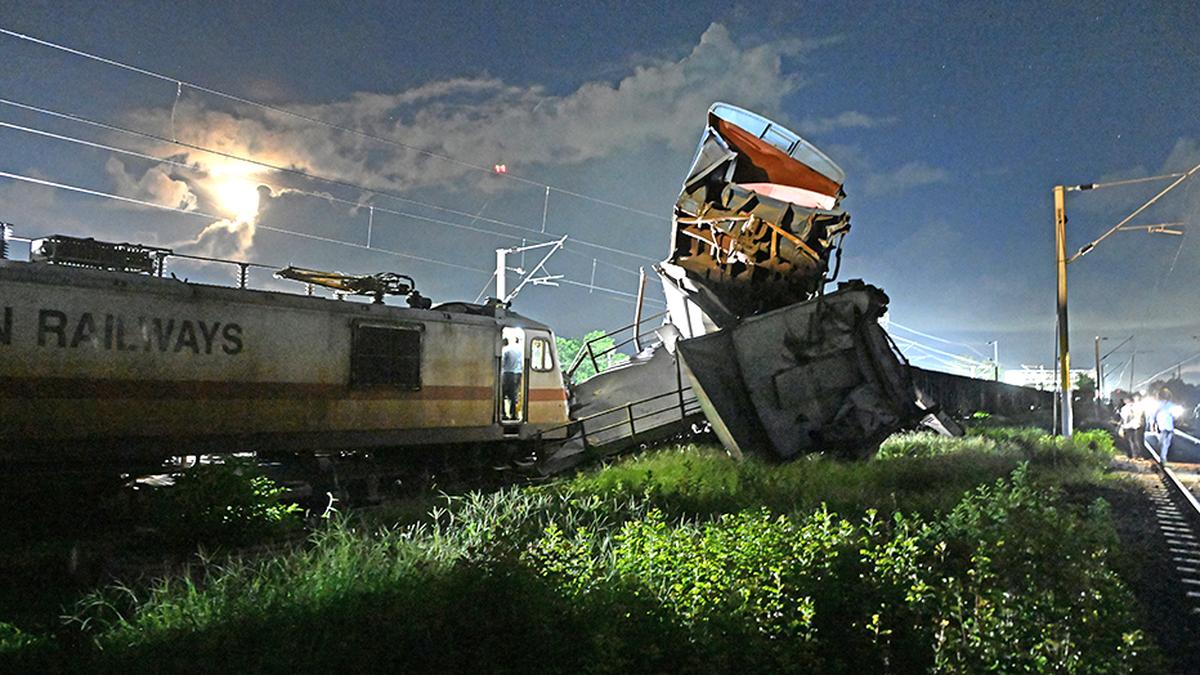
- 22 Oct 2024
In News:
On October 17, eight coaches of the Agartala-Lokmanya Tilak Express derailed in Assam with no casualties. On October 11, a passenger train rear-ended a stationary goods train near Chennai, also with no casualties. Indian trains have been involved in multiple accidents of late. The Balasore accident on June 2, 2023, had the greatest death toll, more than 275, yet pressure on the Railways to improve safety competes with pressures straining its subsistence.
Railway Accident Trends
- Decline in Accidents Over Time:
- From 1,390 accidents per year in the 1960s, railway accidents have reduced to about 80 accidents per year in the last decade.
- Recent Consequential Accidents:
- 34 accidents in 2021-2022
- 48 accidents in 2022-2023
- 40 accidents in 2023-2024
- Primary Causes of Accidents:
- 55.8% due to staff errors (railway personnel).
- 28.4% due to non-staff errors.
- 6.2% due to equipment failure.
- Role of Signalling Failures:
- Major accidents, such as Balasore and Kavaraipettai, were attributed to signalling system failures.
Key Safety Technologies and Measures
- Kavach System:
- Kavach is an automatic train protection system designed to prevent collisions by monitoring train positions and activating alarms or braking.
- As of February 2024, Kavach was implemented on only 2% (1,465 route km) of the railway network, limiting its effectiveness.
- Signalling System Overhaul:
- Outdated and faulty signalling systems contribute significantly to accidents. Both Balasore and Kavaraipettai incidents were linked to failures in signalling infrastructure.
Financial Strain on Indian Railways
- Operating Ratio (OR):
- The Operating Ratio (OR) in 2024-2025 is estimated to be ?98.2, indicating that the Railways spends ?98.2 for every ?100 earned.
- A higher OR reduces available funds for safety improvements and infrastructure upgrades.
- Budgetary Constraints:
- The 2023-24 budget showed a 7.2% reduction in capital outlay for track renewal and a 96% decrease in the Depreciation Reserve Fund, which is used to replace aging assets.
- Revenue Imbalance:
- Freight services account for 65% of Railways’ revenue but face capacity constraints, with 30% of the network operating at over 100% capacity.
- Passenger services, however, continue to incur significant losses, with ?68,269 crore loss in 2021-22.
Challenges in Rail Infrastructure
- Slow Infrastructure Development:
- The government's Dedicated Freight Corridors (DFCs), intended to alleviate congestion, are severely delayed:
- The Eastern DFC is the only fully operational corridor.
- Other corridors, including the Western DFC and additional planned routes, remain incomplete.
- Track and Equipment Maintenance:
- Ongoing delays in upgrading and maintaining essential infrastructure (tracks, wagons, signalling) contribute to the rising number of accidents.
Loco Pilot Working Conditions
- Extended Working Hours:
- Loco pilots often work 12-hour shifts due to manpower shortages, leading to fatigue and increased risk of human error.
- Stress and exhaustion are significant contributors to accidents caused by human error, including Signal Passed at Danger (SPAD).
Recommendations for Improving Railway Safety
- Loco Pilot Vacancies:Immediate recruitment to fill the 18,799 vacant loco pilot positions to prevent overworking and reduce fatigue-related errors.
- Expand Kavach Deployment:Accelerate the nationwide installation of the Kavach system, particularly on high-risk and high-traffic routes, to enhance safety.
- Complete Dedicated Freight Corridors (DFCs):Expedite the completion of DFCs to ease congestion and increase freight movement efficiency.
- Independent Railway Safety Authority:Establish an independent Railway Safety Authority with statutory powers, as recommended by the Kakodkar Committee (2012), to enforce safety standards and monitor implementation.
- Improve Signal Infrastructure:Invest in advanced and reliable signalling systems to prevent errors stemming from outdated or malfunctioning infrastructure.
- Regulate Working Hours:Enforce strict work hour limits to reduce fatigue among railway staff and ensure proper rest between shifts.
- Strengthen Trackside Infrastructure:Install fencing along tracks in high-risk areas to prevent cattle run-overs, a common cause of derailments in rural and semi-urban areas.
Conclusion
- Indian Railways faces a complex set of challenges, balancing safety requirements with financial constraints. Despite technological advancements like Kavach, its limited deployment and outdated infrastructure continue to present significant risks.
- A holistic approach to reform is needed, including addressing manpower shortages, upgrading safety technologies, and investing in infrastructure development. This will be essential for reducing accidents, improving safety, and ensuring the long-term sustainability of India’s vast railway network.
Global Hunger Index 2024
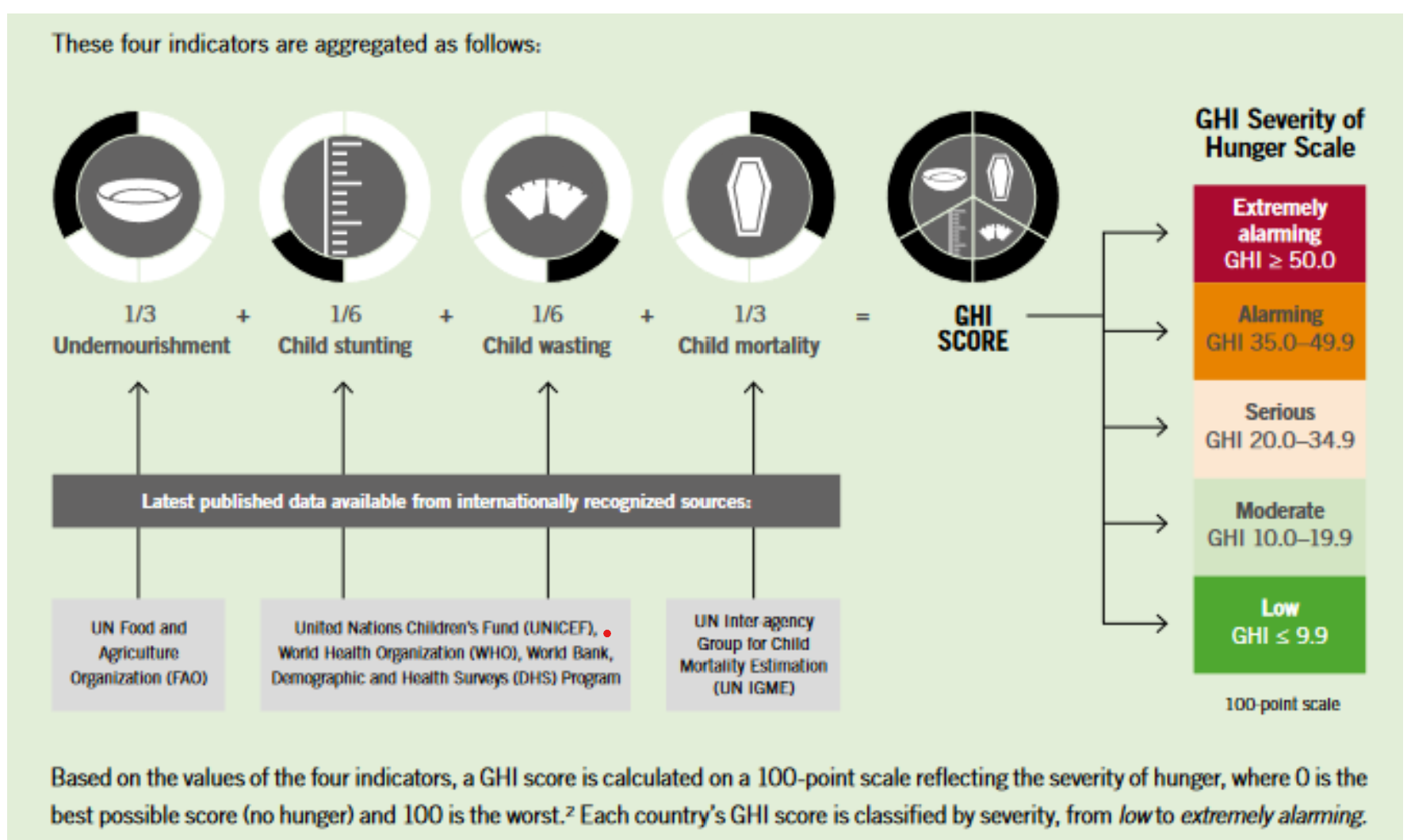
- 17 Oct 2024
Why in the news?
India is ranked 105th among 127 countries in the Global Hunger Index (GHI) 2024, indicating a ‘serious’ level of hunger, along with Afghanistan and Pakistan, which also face hunger challenges.
According to the Global Hunger Index released on 10th October 2024, the hunger levels in 42 countries are at alarming levels, making the goal of Zero Hunger by 2030 unattainable. At this pace of progress, the world will not even attain a low hunger level until 2160. The world’s GHI score is 18.3, which is considered moderate in the severity of hunger scale.
Key Takeaways:
1. The GHI is published by Concern Worldwide and Welthungerhilfe annually to measure and track hunger at global, regional, and national levels. The purpose of the report is to create awareness and understanding of the struggle against hunger and call attention to those areas of the world where hunger levels are highest and there is a need for additional efforts.
2. GHI is calculated based on a formula that combines four indicators that together capture the multidimensional nature of hunger:
- Undernourishment: the share of the population whose caloric intake is insufficient;
- Child stunting: the share of children under the age of five who have low height for their age, reflecting chronic undernutrition;
- Child wasting: the share of children under the age of five who have low weight for their height, reflecting acute undernutrition; and
- Child mortality: the share of children who die before their fifth birthday, reflecting in part the fatal mix of inadequate nutrition and unhealthy environments.
3. The 2024 GHI reflects that multiple factors are posing challenges in attaining Zero Hunger. The challenges include large-scale armed conflicts, climate change indicators that are worsening faster than expected, high food prices, market disruptions, economic downturns, and debt crises in many low- and middle-income countries.
4. The report highlights the link between Gender inequality, climate change, and hunger. Gender is intertwined with climate and food security challenges in ways that respective policies and interventions often ignore. Women and girls are typically hardest hit by food insecurity and malnutrition. They also suffer disproportionately from the effects of weather extremes and climate emergencies.
5. Six countries – Somalia, Yemen, Chad, Madagascar, Burundi, and South Sudan- have levels of hunger considered alarming. This is the result of widespread human misery, undernourishment, and malnutrition.
What is Hunger?
The Food and Agriculture Organization of the United Nations (FAO) defines hunger as food deprivation, or undernourishment, as the habitual consumption of too few calories to provide the minimum dietary energy an individual requires to live a healthy and productive life, given that person’s sex, age, stature, and physical activity level.
6. India ranked 105th out of 125 countries in the Global Hunger Index 2024, with a score of 27.3, indicating a serious level of hunger. Child wasting is particularly high in India. Child undernutrition in India goes hand in hand with the poor nutritional status of mothers, suggesting an intergenerational pattern of undernutrition and underscoring the need for attention to maternal health nutrition and infant feeding.
7. India’s GHI score of 27.3 is a cause for concern, especially when compared to its South Asian neighbours like Bangladesh, Nepal, and Sri Lanka, which fall into the “moderate” category
8. The performance of India on various parameters of GHI:
- 13.7 per cent of India’s population suffers from undernourishment,
- 35.5 per cent of children under the age of five are stunted
- 18.7 per cent experience child wasting and
- 2.9 per cent of children do not reach their fifth birthday.
9. The policy recommendations made in the document include strengthening accountability to international law and the enforceability of the right to adequate food, promoting gender-transformative approaches to food systems and climate policies and programs, and making investments that integrate and promote gender, climate, and food justice.
National Family Health Survey
1. The National Family Health Survey (NFHS) in India provides estimates of underweight, (low weight for age), stunting (low height for age), and wasting (low weight for height). These conditions affect preschool children (those less than 6 years of age) disproportionately and compromise a child’s physical and mental development while also increasing the vulnerability to infections.
2. According to the NFHS 5, the percentage of stunted, wasted, and underweight children is 36 per cent, 19 per cent and 32 per cent respectively.
(Thought Process: These data can be incorporated in your Mains Answer Writing to enrich your content.)
3. NFHS 5 highlighted that among mothers with a child between ages 6-23 months, 18 per cent reported that their child did not eat any food whatsoever — referred to as “zero-food” — in the 24 hours preceding the survey. The zero-food prevalence was 30 per cent for infants aged 6-11 months, remains worryingly high at 13 per cent among the 12-17 months old, and persists even among 18-23 months-old children at 8 per cent.
Hidden Hunger
In India, we suffer largely from “hidden hunger” which does not always manifest itself in an emaciated appearance. It is a hunger caused by the constant or recurrent lack of food of sufficient quality and quantity. It is the deprivation of vitamins and minerals, essential micronutrients that are necessary for proper growth, physical fitness, and mental development.
4. Going without food for an entire day at this critical period of a child’s development raises serious concerns related to severe food insecurity. According to the World Health Organisation, at six months of age, 33 per cent of the daily calorie intake is expected to come from food. This proportion increases to 61 per cent at 12 months of age. The recommended calorie percentages mentioned here are the minimum amount that should come from food.
5. India has a challenging task in attaining the Sustainable Development Goal (SDG) 2 of “zero hunger”. Mission Poshan 2.0, the overarching flagship programme dedicated to maternal and child nutrition, has evolved in the right direction by targeting SDG 2 “zero hunger” and focusing on food-based initiatives, including its flagship supplementary nutrition programme service as mandated by the 2013 National Food Security Act.
Asset Monetisation
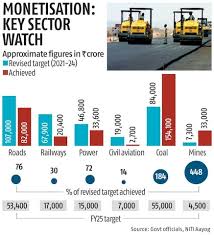
- 15 Oct 2024
In News
The NITI Aayog has recently increased the asset monetisation target for the fiscal year 2024-25 (FY25) by ?23,000 crore, bringing the total to ?1.9 trillion. This adjustment aligns with the broader target of ?6 trillion set under the National Monetisation Pipeline (NMP) for the period from FY 2022 to FY 2025.
Understanding Asset Monetisation
Definition
Asset monetisation refers to the process of converting public assets into revenue-generating assets without selling them outright. This includes using assets to generate profit or cash, thereby unlocking their economic value.
Importance
- Revenue Generation: Monetisation creates new revenue streams for governments by leveraging underutilised public assets.
- Focus on Public Assets: The emphasis is on monetising existing infrastructure such as roads, airports, railways, and pipelines, primarily targeting brownfield assets—those that can be improved or repurposed.
Monetisation vs. Privatisation
While privatisation involves complete ownership transfer to the private sector, asset monetisation allows public authorities to retain ownership while benefiting from private sector efficiencies through structured partnerships.
The National Monetisation Pipeline (NMP)
Overview
The NMP is an initiative aimed at promoting sustainable infrastructure financing through the monetisation of operational public assets. It envisions a monetisation potential of ?6 lakh crore, focusing on leasing core assets from the Central government and public sector entities.
Preparation and Coverage
- Collaborative Approach: Developed by NITI Aayog in consultation with infrastructure ministries such as Roads, Railways, and Power.
- Sector Coverage: Encompasses various sectors including roads (27% of the total value), railways (25%), power (15%), and telecom (6%).
Framework for Monetisation
- Retention of Rights: The government retains ownership, with assets reverting to public authorities post-transaction.
- Stable Revenue Streams: Focus on de-risked brownfield assets that provide consistent revenue.
- Defined Partnerships: Establishment of contractual frameworks with strict performance indicators.
Alignment with National Infrastructure Pipeline (NIP)
The NMP is integrated with the NIP, which seeks to attract investments in both greenfield and brownfield projects across all sectors.
Current Status of the NMP
Revenue Generation
As of FY24, the NMP has generated ?3.9 trillion, slightly below the original target of ?4.3 trillion for the initial three years.
Successful Monetisation Examples
- The Ministry of Coal exceeded its target, raising ?1.54 trillion against a goal of ?80,000 crore.
- Mining assets have also been monetised significantly, surpassing their revised targets.
Sectors Lagging
- Railways: Only ?20,417 crore monetised, achieving just 30% of the target.
- Civil Aviation: A mere 14% of its targeted monetisation has been achieved.
Challenges Facing the NMP
- Low Monetisation Potential: The NMP's ?6 lakh crore target represents only a small fraction (5-6%) of the total capital expenditure under the NIP.
- Disinvestment Issues: Many sectors chosen for monetisation have consistently fallen short of their disinvestment targets, raising doubts about achieving future goals.
- Long-Term Rights Concerns: Granting private entities long-term operational rights may be perceived as a form of privatisation, potentially leading to public distrust.
- Budget Clarity: There is a lack of transparency regarding how monetisation proceeds will be allocated within the government budget.
- Potential for Monopolies: Consolidation of asset ownership could lead to monopolistic practices, especially in critical infrastructure sectors.
- Taxpayer Concerns: Taxpayers are wary of the potential for double charges on public assets they initially funded.
Way Forward
- Accelerating Monetisation: The government should expedite contract-based monetisation through Public-Private Partnerships (PPP), particularly in sectors like railways and airports.
- Land Monetisation Initiatives: Engaging real estate companies to develop multi-storey buildings can generate additional revenue while enhancing housing options.
- Establishing Budget Guidelines: Clear budgeting guidelines should be developed to clarify the allocation of funds generated from monetisation, ensuring they are used for infrastructure development rather than operational expenses.
Navigating the Middle-Income Trap: Challenges and Solutions for India

- 14 Oct 2024
Introduction
The World Development Report 2024 addresses the phenomenon of the middle-income trap, where countries struggle to maintain growth as they transition from low to middle-income status. This report advocates for a "3i" approach—Investment, global Technology infusion, and domestic Innovation—to overcome this challenge. India faces specific hurdles, including stagnant exports, rising protectionism, and premature deindustrialization.
Understanding the Middle-Income Trap
Definition and Characteristics
- A middle-income trap occurs when a country, after achieving middle-income status, fails to progress to high-income status.
- This phenomenon typically arises when a country's per capita income reaches about 11% of US levels, leading to:
- High wage levels that diminish competitiveness against low-wage economies.
- Insufficient technological advancement to compete with high-income nations.
Economic Implications
- Traditional growth drivers become ineffective.
- Rising wages in labor-intensive sectors decrease competitiveness, while innovation and productivity remain stagnant.
Historical Context: India’s Income Evolution
1. Post-Independence Era (1950s-1970s)
- Per Capita Income: ?265 in 1950-51.
- Growth Rate: 3.5%, dominated by agriculture.
- Economic Structure: Heavy state intervention and public sector focus.
2. Liberalization Phase (1980s-1990s)
- Per Capita Income Growth: Accelerated to 5.6%.
- Major Shift: 1991 liberalization led to a rise in the services sector and an expanding middle class.
3. High Growth Phase (2000-2010)
- GDP Growth: 8-9% annually.
- Per Capita Income: Increased from ?16,173 in 2000-01 to ?24,295 in 2007-08.
- Sectoral Dominance: Surge in software and services exports.
4. Mixed Growth Phase (2010-2020)
- Growth Volatility: Average of 6-7%.
- Wealth Inequality: Top 1% owned 40.5% of national wealth by 2021.
5. Post-Covid Recovery (2020-Present)
- GDP: Reached $3.75 trillion.
- Current Issues: Unemployment at 8.1%, while digital payment systems expanded.
Challenges in Overcoming the Middle-Income Trap
1. Premature Deindustrialization
- The manufacturing sector's GDP share has stagnated at 15-17%, far below the target of 25%.
- Limits potential productivity gains and innovation.
2. Limitations of Services-Led Growth
- Over-reliance on the services sector hampers mass employment and inclusive growth.
3. Declining Total Factor Productivity (TFP)
- TFP growth has been declining, indicating a shift toward input-driven growth rather than efficiency-driven growth.
4. Informal Sector Dominance
- The informal economy comprises about 90% of the workforce, leading to low productivity and limited access to technology.
5. Risk of a Demographic Burden
- Youth unemployment is rising, with only 2.3% of the workforce receiving formal skill training.
6. Global Economic Headwinds
- Slowing global growth affects India’s export-led strategies, with a recent contraction in merchandise exports.
7. Infrastructure and Logistics Bottlenecks
- India ranks 38th in the World Bank’s Logistics Performance Index, highlighting significant infrastructure gaps.
Strategic Measures for India
1. Enhance Manufacturing Competitiveness
- Targeted Industrial Policies: Refine the Production-Linked Incentive scheme and extend it to emerging sectors like green hydrogen.
2. Accelerate Digital Infrastructure and Skills Development
- Leverage India's digital platforms to create a skills ecosystem and modernize vocational training.
3. Boost R&D Expenditure
- Increase public R&D spending to 2% of GDP by 2030, focusing on key sectors like renewable energy.
4. Foster an Innovation-Driven Manufacturing Policy
- Shift focus to high-value specialized manufacturing rather than competing in mass production.
5. Integrate Skills and Education
- Align educational curricula with industry needs and establish centers of excellence in tier-2 and tier-3 cities.
6. Lead in Green Technology
- Scale initiatives like the International Solar Alliance and create a national carbon market.
7. Reform Market Regulations
- Liberalize product and factor markets to enhance competition and efficiency.
Conclusion
India's path out of the middle-income trap necessitates a concerted effort to boost manufacturing, foster innovation, and address productivity challenges. By leveraging digital infrastructure and enhancing skills, alongside adopting green technologies, India can create a sustainable framework for growth. Effective execution of targeted policies will be crucial for transitioning to a high-income economy.
MeitY relaxes AI compute procurement norms for Start-ups

- 09 Oct 2024
Overview
The Ministry of Electronics and IT (MeitY) has relaxed certain provisions related to the procurement of computing capacity for artificial intelligence (AI) solutions. This decision is part of the Rs 10,370 crore IndiaAI Mission, aimed at enhancing the country’s AI capabilities.
Key Relaxations
Annual Turnover Requirements
- Primary Bidders: Turnover requirement reduced from ?100 crore to ?50 crore.
- Non-Primary Consortium Members: Requirement halved from ?50 crore to ?25 crore.
Computing Capacity Adjustments
- The performance threshold for successful bidders has been revised:
- FP16 Performance: Reduced from 300 TFLOPS to 150 TFLOPS.
- AI Compute Memory: Reduced from 40 GB to 24 GB.
Importance of the Changes
These adjustments respond to concerns raised by smaller companies about exclusionary requirements that favored larger firms. The aim is to create an inclusive environment that allows start-ups to participate in the AI landscape.
AI Mission Goals
- Establish a computing capacity of over 10,000 GPUs.
- Develop foundational models with capacities exceeding 100 billion parameters.
- Focus on priority sectors such as healthcare, agriculture, and governance.
New Technical Criteria
- Companies must demonstrate experience in offering AI services over the past three financial years.
- Minimum billing of ?10 lakh required for eligibility.
Local Sourcing Requirements
- Components for cloud services must be procured from Class I or Class II local suppliers as per the ‘Make in India’ initiative:
- Class I Supplier: Domestic value addition of at least 50%.
- Class II Supplier: Local content between 20-50%.
Data Sovereignty and Service Delivery
- All AI services must be delivered from data centres located in India.
- Data uploaded to cloud platforms must remain within India's sovereign territory.
Implementation Strategy
- The Rs 10,370 crore plan will be implemented through a public-private partnership model.
- 50% viability gap funding has been allocated for computing infrastructure development.
Conclusion
The relaxations in AI compute procurement norms aim to support the growth of start-ups in India, fostering an environment conducive to innovation in artificial intelligence. With these changes, smaller companies are better positioned to contribute to the country's ambitious AI goals.
Fairwork India Report
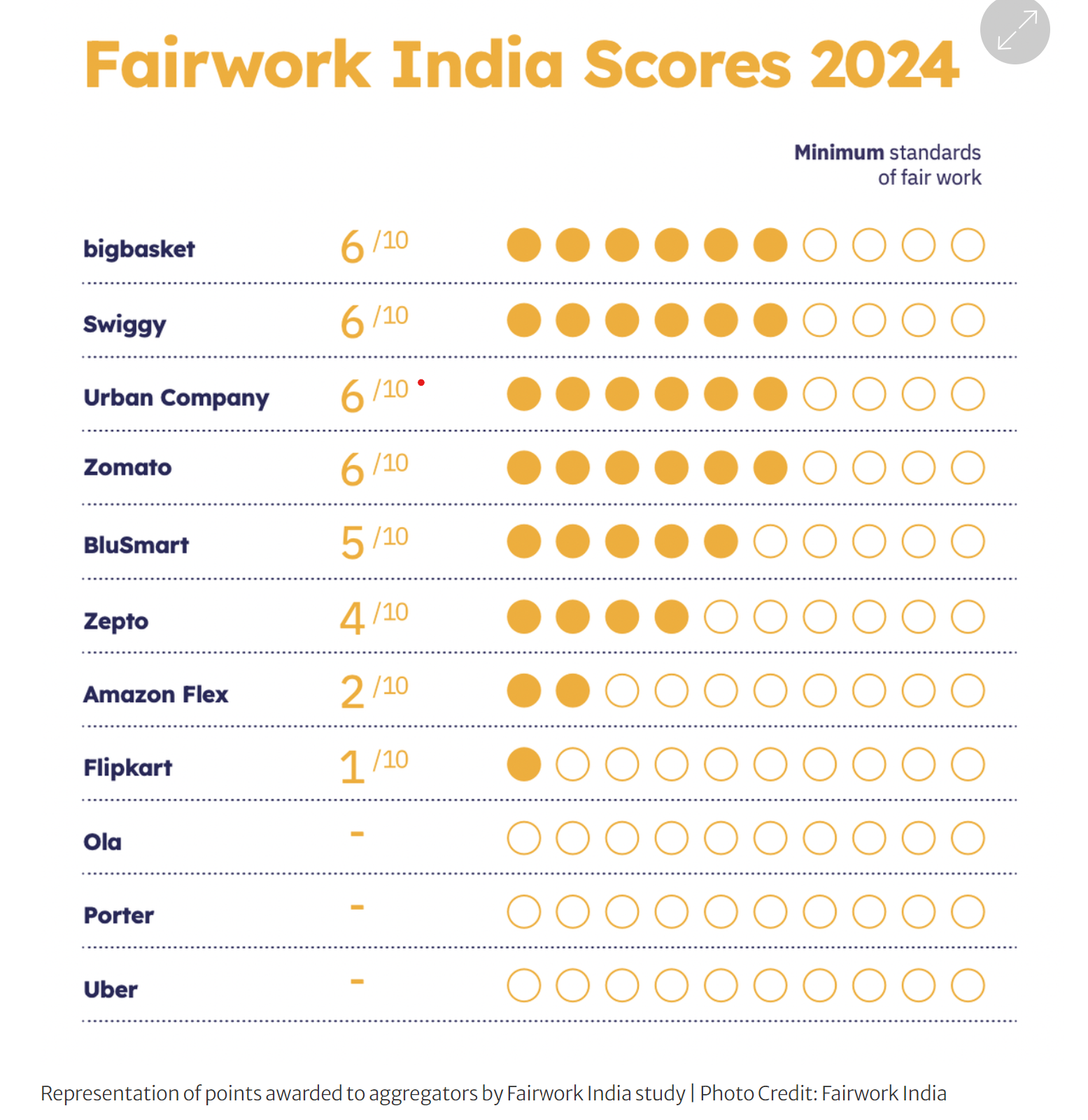
- 06 Oct 2024
In News:
The Fairwork India Ratings 2024 report, which analyses the work conditions of platform workers on digital labour platforms in India, draws a picture of aggregators who are non-committal to ensuring that workers earn the local living wage and unwilling to recognise collectivisation of workers.
Key Findings:
- Overall Performance: No platform scored above six out of ten, and none achieved top points across the five assessed principles: Fair Pay, Fair Conditions, Fair Contracts, Fair Management, and Fair Representation.
- Study Background: This report is the sixth annual analysis conducted by the Fairwork India Team, in collaboration with the Centre for IT and Public Policy (CITAPP), IIIT-Bangalore, and Oxford University.
Analysis of Welfare Legislation
- The report discusses the evolving nature of platform work and its implications for proposed legislation affecting gig workers in Karnataka and Jharkhand.
- Political interest in gig workers' welfare has increased, but the effectiveness of these initiatives remains uncertain.
- Professors Balaji Parthasarathy and Janaki Srinivasan highlight the importance of ongoing research and advocacy for improving gig worker conditions.
Methodology
- Principles of Assessment: Platforms were evaluated based on five principles, each consisting of two points—one that could only be awarded if the first point was fulfilled.
- Data Collection: Worker interviews were conducted across multiple cities, including Bengaluru, Chennai, Delhi, Kochi, and Thiruvananthapuram.
- Platforms Analyzed: The study included 11 platforms from various sectors, such as logistics, food delivery, and personal care.
Detailed Findings by Principle
Fair Pay
- First Point: Bigbasket and Urban Company were recognized for implementing a minimum wage policy ensuring workers earn at least the local minimum wage.
- Second Point: No platform met the criteria for committing to a local living wage after work-related costs.
Fair Conditions
- First Point: Platforms such as Amazon Flex, BigBasket, and Swiggy provided adequate safety equipment and training.
- Second Point: BigBasket, Swiggy, Urban Company, Zepto, and Zomato offered additional protections, including accident insurance and compensation for medical-related work absences.
Fair Contracts
- First Point: BigBasket, BluSmart, and others ensured contract accessibility and data protection protocols.
Fair Management
- First Point: Amazon Flex, BigBasket, and several others provided due process in disciplinary decisions.
- Second Point: BluSmart, Swiggy, Urban Company, and Zomato were noted for regular external audits and anti-discrimination policies.
Fair Representation
- Despite increased collectivization efforts among platform workers, no platform showed a willingness to recognize collective bodies, underscoring a critical gap in worker representation.
Conclusion
The Fairwork India Ratings 2024 report highlights significant challenges in ensuring fair work conditions for platform workers in India, stressing the need for continuous advocacy and reform in the gig economy.
National Urban Livelihood Mission (NULM)
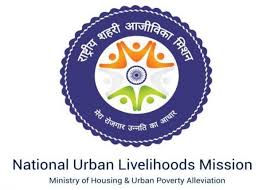
- 05 Oct 2024
In News:
The Government is set to launch NULM 2.0, the latest iteration of the National Urban Livelihood Mission (NULM), aimed at enhancing the livelihoods of urban poor and vulnerable populations. This version will specifically target six key groups: construction workers, gig workers, waste management workers, care workers, domestic workers, and transportation workers.
Overview of DAY-NULM
The Deendayal Antyodaya Yojana-National Urban Livelihoods Mission (DAY-NULM) was initiated in 2014 by the Ministry of Housing and Urban Affairs to replace the Swarna Jayanti Shahari Rozgar Yojana. It aims to uplift urban poor through organized self-help groups (SHGs), skill development, and access to credit.
Key Features:
- Funding Structure: DAY-NULM operates as a Centrally Sponsored Scheme, with a funding ratio of 75:25 between the central and state governments, adjusted to 90:10 for North Eastern and Special Category states.
- Mobilization of Women: The mission has successfully formed over 831,000 SHGs, mobilizing more than 8.4 million urban poor women by 2023.
- Objectives: It focuses on sustainable livelihoods through skill development, financial access, and entrepreneurship, particularly for women.
Components and Achievements
DAY-NULM includes various initiatives such as:
- Skill training programs.
- Support for self-employment.
- Rehabilitation for street vendors.
Performance Highlights:
- Over 89.33 lakh women have joined SHGs, with 6.12 lakh receiving initial funds.
- Approximately 15 lakh individuals have undergone skill training, leading to employment for 8.20 lakh.
- Surveys have identified 53.76 lakh street vendors, resulting in significant documentation and support.
Introduction of NULM 2.0
NULM 2.0 is a revamped initiative designed to further support urban livelihoods through financial aid and infrastructure enhancements.
Key Features:
- Microcredit Access: Eligible individuals can obtain microcredit of up to ?4 lakh, while groups can access up to ?20 lakh, with a subsidized interest rate of 5%.
- Support for Enterprises: The funding aims to assist beneficiaries in starting small businesses, creating social infrastructure, and providing grants for innovative projects, such as sanitation machinery.
Pilot Initiative
To effectively implement NULM 2.0, the government will conduct a pilot program in 25 cities. This will focus on:
- Identifying urban poor populations.
- Ensuring targeted assistance to improve beneficiaries’ earnings and living conditions.
Conclusion
The rollout of NULM 2.0 represents a significant step in addressing the needs of the urban poor, with a comprehensive framework designed to provide financial support and improve livelihoods. By focusing on critical worker groups and leveraging microcredit, the initiative aims to foster sustainable development and enhance the quality of life for urban vulnerable communities.
Tax Crackdown on NGOs: Overview and Allegations

- 03 Oct 2024
Introduction
In recent months, the Income Tax (I-T) Department has intensified scrutiny of several non-governmental organizations (NGOs) in India, linking them to allegations of misconduct, particularly in relation to foreign funding and activities that allegedly stall economic development. The investigation, which began with searches on September 7, 2022, targets prominent NGOs such as Oxfam, the Centre for Policy Research (CPR), and others.
Background of the Investigation
Triggering Events
The I-T probe was initiated following extensive searches at the premises of five major NGOs, including Oxfam, CPR, Environics Trust (ET), the Legal Initiative for Forest and Environment (LIFE), and Care India Solution for Sustainable Development (CISSD).
Key Allegations
The investigation highlights several critical allegations:
- Foreign Funding: Over 75% of funding for four of the NGOs during a five-year period was sourced from abroad, which is claimed to shape their activities in India.
- Interconnections: There are allegations of overlapping personnel and funding connections between these NGOs.
- Legal Challenges: Following the cancellation of their Foreign Contribution Regulation Act (FCRA) licenses, these organizations have filed legal challenges that are currently under review by the Delhi High Court.
Violations of the FCRA
The I-T department asserts that these NGOs violated multiple provisions of the FCRA, including discrepancies in annual returns and misappropriation of foreign funds. The cancellation of their FCRA licenses has led to heightened scrutiny and legal ramifications.
Specific NGO Allegations
- Oxfam India
- Accused of supporting foreign entities in efforts to halt mining projects by the Adani Group, violating its stated charitable objectives.
- Allegations include attempts to redirect funds through other NGOs post-FCRA cancellation.
- Centre for Policy Research (CPR)
- Charged with mishandling foreign donations and involvement in environmental litigation, notably the Hasdeo movement against coal mining in Chhattisgarh.
- Received substantial funding for its Namati-Environmental Justice Programme, purportedly to facilitate legal actions rather than educational initiatives.
- Environics Trust (ET)
- Allegedly funded protests against significant industrial projects, including JSW’s Utkal Steel Plant.
- Claims of collaboration with international organizations to impede development projects, particularly coal initiatives.
- Legal Initiative for Forest and Environment (LIFE)
- Accused of being used as a conduit by the US-based Earth Justice to obstruct coal mining and thermal projects in India.
- Internal communications allegedly reveal awareness of their controversial activities.
Interconnected Operations
The investigation indicates that these NGOs may be working in concert, as highlighted by the I-T department:
- Funding Networks: For instance, Oxfam is cited as a primary funder of ET, allegedly to mobilize local communities against coal industries.
- Personnel Links: Relationships between key figures in these organizations, such as the former president of CPR, who is also associated with Care India, raise concerns about coordinated efforts.
Responses from NGOs
Denial of Allegations
The allegations have been met with strong denials from the NGOs involved. Ritwick Dutta, founder of LIFE, characterized the claims of interlinking as baseless, asserting that his organization operates independently and has no financial ties to Oxfam or CPR.
Lack of Official Responses
Other NGOs, including Oxfam and CPR, have not officially responded to the I-T department's accusations, leaving some questions unanswered regarding their operational practices.
The Role of Civil Society Organizations (CSOs) in India
Definition and Importance
CSOs encompass a range of nonprofit organizations that operate independently from the government. In India, these include:
- Non-Governmental Organizations (NGOs): Primarily focused on community welfare and development across various sectors.
- Community-Based Organizations (CBOs): Grassroots entities that directly serve local needs and interests.
Impact and Challenges
CSOs play a crucial role in advocating for vulnerable populations and addressing social issues. However, they face significant challenges, including scrutiny over funding sources and operational transparency, especially amid increasing governmental oversight.
Conclusion
The ongoing investigation into these NGOs raises critical questions about the relationship between civil society and government regulation in India. While the I-T department's crackdown aims to ensure compliance with foreign funding regulations, the implications for activism and public participation in developmental issues remain contentious. As the legal proceedings unfold, the future of these organizations and their missions may be at stake.
What is the Unified Lending Interface by the RBI?
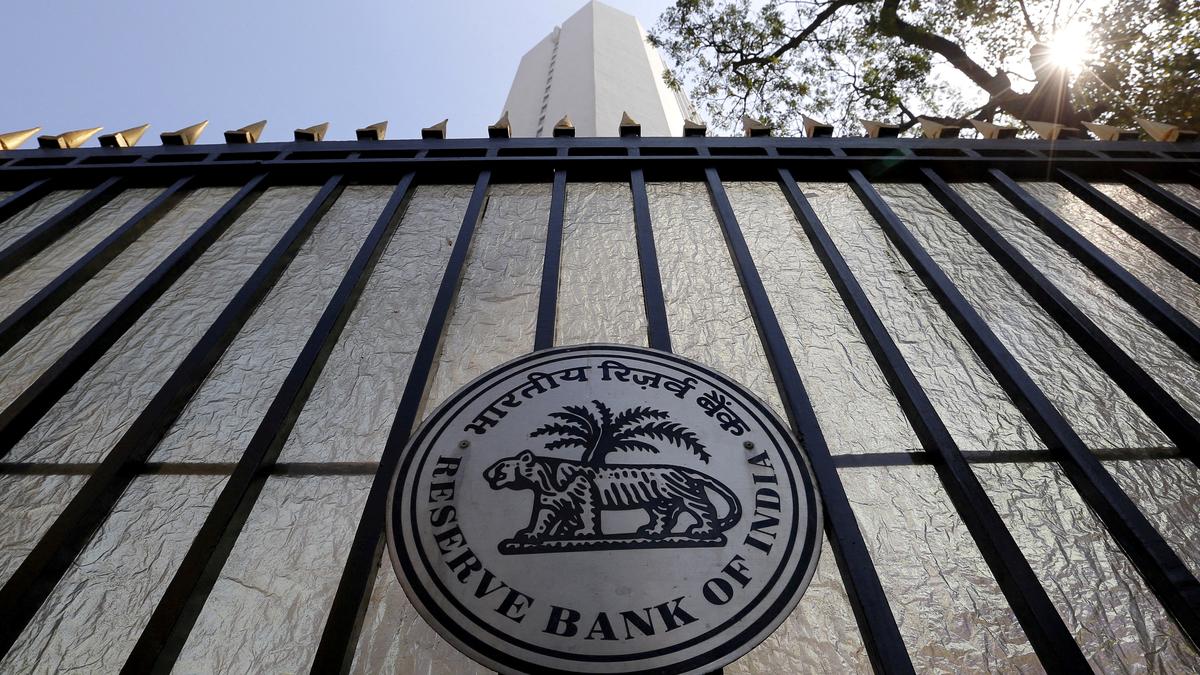
- 03 Sep 2024
In News:
The Reserve Bank of India (RBI), as part of its strategy to create digital public infrastructure in the country, has announced that a new technology platform called the Unified Lending Interface (ULI) would be introduced by the Reserve Bank Innovation Hub, Bengaluru which will enable friction-less credit to farmers and MSME borrowers to begin with.
What is ULI?
The ULI platform, aims to revolutionize the credit underwriting process by enabling a streamlined and consent-based transfer of both financial and non-financial data from various sources to lenders.
- Seamless Data Flow: ULI facilitates an efficient flow of digitized data, including crucial records like land titles, directly to lenders, enhancing the credit appraisal process.
- Faster Credit Appraisal: The platform is particularly beneficial for smaller and rural borrowers who may lack extensive credit histories, significantly reducing the time required for credit assessments.
- Standardized APIs: ULI employs common, standardized Application Programming Interfaces (APIs) that allow for a plug-and-play integration, simplifying the technical requirements for lenders and ensuring easy access to diverse data sources.
- Access to Diverse Data: Lenders can access a wealth of information from various databases, including government records and satellite imagery, which can provide deeper insights into potential borrowers.
- Opportunities for FinTechs: The platform also opens up opportunities for FinTech companies by connecting them with multiple lenders, thereby enhancing their ability to deliver tailored financial solutions.
ULI aims to create a more inclusive and efficient lending ecosystem, ultimately improving access to credit for a wider range of borrowers.
How will it work?
The ULI platform transforms the loan application process, especially for first-time borrowers and those without traditional credit histories. Here’s how it works:
- Centralized Data Access: ULI acts as a single point of access for lenders to retrieve crucial economic data about loan applicants. This reduces the need for applicants to gather extensive documentation themselves.
- Plug-and-Play Integration: Financial institutions can easily connect to the ULI platform through standardized APIs, allowing them to quickly access various data sources relevant to the borrower’s financial history and status.
- Automated Data Retrieval: Instead of borrowers spending weeks collecting documents, lenders can automatically fetch necessary information from the platform. For instance, data for a dairy farmer may include:
- Cash Flow Information: Sourced from local milk cooperatives.
- Land Ownership: Verified through state land records.
- Financial Insights: Derived from the farmer’s historical farming patterns.
- Enhanced Visibility: This comprehensive data access turns what were previously blind spots for lenders into clear insights, allowing them to assess applicants more accurately.
- Rapid Decision-Making: With immediate access to essential data, lenders can quickly determine the borrower’s income and creditworthiness. This streamlines decision-making, enabling loans to be sanctioned and disbursed within minutes.
- Supporting Tenant Farmers: Tenant farmers, who typically struggle to obtain loans due to lack of land titles, can also benefit. ULI can facilitate loans by allowing banks to verify identity and eligibility based on the intended use of funds for agricultural inputs rather than land ownership.
In summary, ULI simplifies the loan process, making it faster and more inclusive for diverse borrowers by leveraging digital data access and automation.
How did it start?
The ULI platform, officially launched by the RBI on August 10, 2023, emerged from the need for a streamlined approach to credit appraisal in an increasingly digital landscape. Here’s how it all began:
- Identification of Need: The RBI recognized that with rapid digitalization, there was a pressing need for a centralized platform to provide access to the data necessary for credit assessments. This was essential for facilitating frictionless digital credit delivery.
- Pilot Project: To test the concept, the RBI initiated a pilot project focused on the digitalization of Kisan Credit Card (KCC) loans under ?1.6 lakh in September 2022. This pilot was launched in select districts across Madhya Pradesh, Tamil Nadu, Karnataka, Uttar Pradesh, and Maharashtra.
- Encouraging Results: The initial outcomes of the KCC pilot were promising, showcasing the potential for seamless loan disbursement. The pilot demonstrated that loans could be disbursed at the doorstep, either through assisted or self-service modes, all without the need for extensive paperwork.
- Development of ULI: Building on the success of the KCC pilot, the RBI moved forward with the establishment of the ULI platform to broaden the scope of digital credit accessibility for a wider range of borrowers.
PLFS REPORT 2023-24
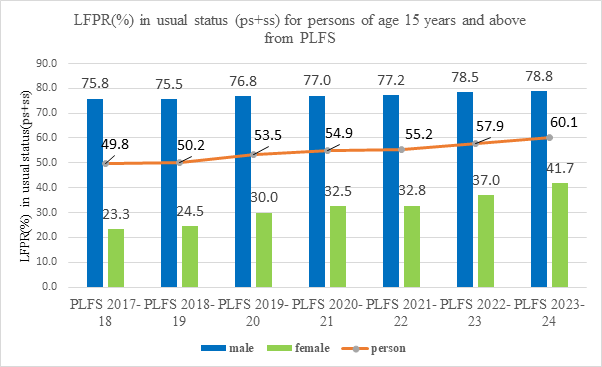
- 26 Sep 2024
In News:
The Periodic Labour Force Survey (PLFS) conducted by the National Statistical Office (NSO) from July 2023 to June 2024 provides crucial insights into the employment landscape in India.
Key Findings from the PLFS Report 2023-24
- Labour Force Participation Rate (LFPR):
- The LFPR for individuals aged 15 years and above rose to 60.1%, an increase from 57.9% the previous year.
- For males, LFPR is at 78.8%, while for females, it increased to 41.7%, up from 37.0%.
- Worker Population Ratio (WPR):
- The WPR for the same age group stands at 58.2%. This is composed of 76.3% for males and 40.3% for females.
- Female WPR improved from 35.9% to 40.3% during the reporting period.
- Unemployment Rate (UR):
- The overall unemployment rate is 3.2%. It slightly declined for males from 3.3% to 3.2%, while it increased for females from 2.9% to 3.2%.
Overview of the PLFS
The PLFS, initiated in April 2017, aims to provide timely and accurate labor market data. It focuses on two main objectives:
- Short-term Employment Indicators: Measure key employment metrics every three months in urban areas using the Current Weekly Status (CWS) approach.
- Annual Estimates: Gather employment and unemployment data for both urban and rural areas, assessing them in terms of Usual Status and CWS.
Methodology and Sample Design
- The survey employs a rotational panel sampling design in urban areas, where households are visited multiple times to ensure comprehensive data collection.
- During the 2023-24 period, a total of 12,800 Field Sampling Units (FSUs) were designated, with 12,743 successfully surveyed.
Conceptual Framework
Key indicators measured include:
- Labour Force Participation Rate (LFPR): Percentage of the population working or actively seeking work.
- Worker Population Ratio (WPR): Percentage of employed individuals in the total population.
- Unemployment Rate (UR): Proportion of unemployed individuals among the labor force.
Challenges in Job Creation
India continues to face significant challenges in generating formal jobs. Key factors contributing to this issue include:
- Informalization of Employment: Growth in sectors like agriculture and construction is leading to increased informal employment, lacking social security and job protections.
- Technological Advancements: Automation and AI threaten job opportunities, even for skilled workers, as evidenced by layoffs in the IT sector.
- Skill Mismatch: Despite a push for skill development, the share of skilled jobs has declined, highlighting a growing disconnect between training programs and labor market needs.
- Policy Impacts: Past policies, such as demonetization and poorly implemented GST, have negatively impacted small and medium enterprises (SMEs), which are vital for job creation.
Way Forward:
To address these challenges, several strategies are proposed:
- Sectoral Diversification: Fostering investments in manufacturing, renewable energy, and technology can generate productive jobs.
- Support for MSMEs: Targeted financial aid and regulatory relief for micro, small, and medium enterprises are crucial for boosting their employment potential.
- Skill Development: Aligning training initiatives with current industry demands, particularly in emerging sectors, is essential.
- Focus on New-Age Services: Encouraging growth in sectors like e-commerce and online education could create diverse job opportunities.
Conclusion
The PLFS 2023-24 reveals an encouraging increase in labor force participation, particularly among women, while also highlighting persistent challenges in unemployment and gender disparities. The findings underscore the need for continued efforts to enhance job creation and improve employment conditions in both formal and informal sectors.
ANALYSIS OF INDIA'S TRADE DEFICIT
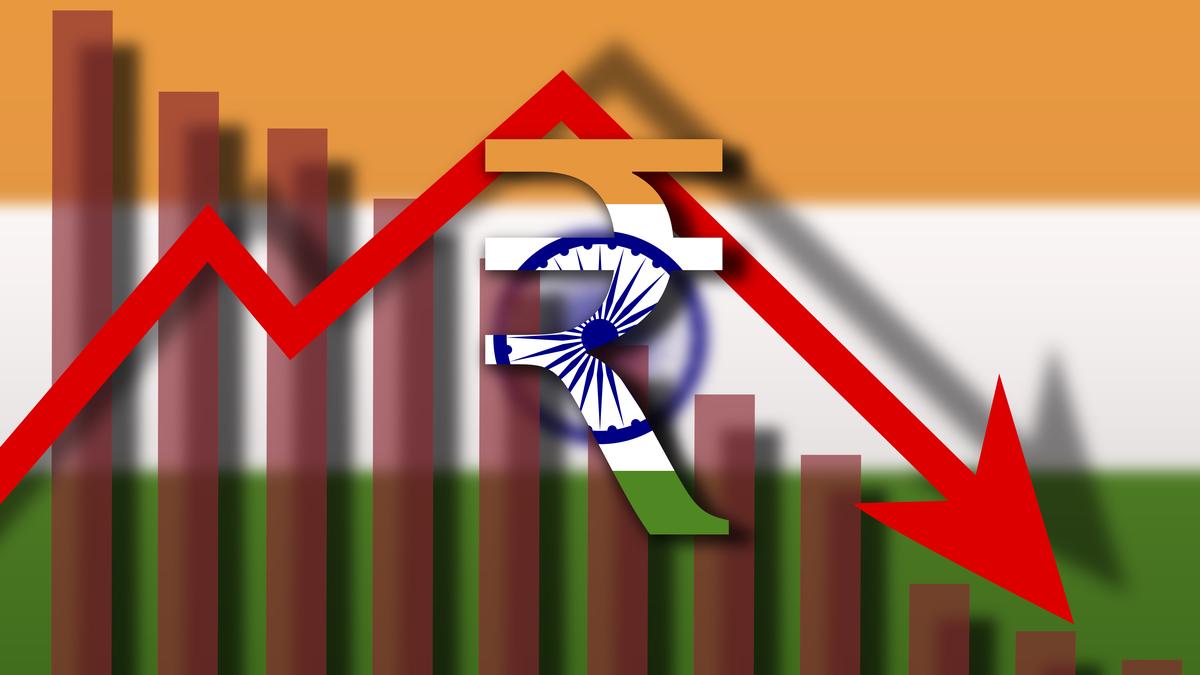
- 23 Sep 2024
Overview of the Trade Deficit
India experienced a notable increase in its trade deficit during July and August 2024, primarily due to declining exports and rising imports. This trend is indicative of both domestic challenges and global economic conditions.
Understanding Trade Deficit
A trade deficit occurs when a country's imports surpass its exports, leading to a negative trade balance. While not inherently detrimental, sustained trade deficits can result in issues such as currency depreciation, rising national debt, and pressure on local industries.
Factors Influencing India's Trade Deficit
Several key elements have contributed to the widening of India’s trade deficit in recent months:
- Decline in Exports
- Oil Exports: A sharp decline was observed in petroleum exports, which dropped by 22.2% in July and 37.6% in August, influenced by both weakened global demand and falling oil prices.
- Gems & Jewellery: This sector saw a reduction exceeding 20% in exports during both months, adversely affecting overall trade performance.
- Pharmaceuticals and Electronics: These sectors also faced slower growth due to ongoing weak global demand.
- China's Economic Slowdown
- Exports to China, particularly in materials such as stone and iron ore, diminished as China grappled with internal economic challenges and reduced infrastructure spending, negatively impacting India's export revenue.
- Surge in Gold Imports
- August saw a record $10.1 billion in gold imports, more than doubling previous figures. This increase was driven by lowered import duties and heightened domestic demand for the festive season, significantly contributing to the trade deficit.
- Decline in Oil Imports
- On a more positive note, India’s oil import bill decreased by nearly a third due to falling global oil prices, marking the lowest petroleum trade deficit in three years. However, this reduction did not sufficiently counterbalance deficits in other areas.
Implications of the Trade Deficit
- Currency Depreciation: A growing trade deficit may exert downward pressure on the Indian rupee, making imports costlier and potentially worsening the deficit further, given India's heavy reliance on imported commodities.
- Impact on Economic Growth: Prolonged trade deficits can hinder economic growth by reflecting diminished export competitiveness and excessive reliance on imports.
- Foreign Exchange Reserves: While India’s foreign exchange reserves are currently robust, a sustained deficit could deplete these reserves, complicating efforts to stabilize the rupee in the future.
Long-term Challenges and Outlook
India's trade deficit is shaped by a mixture of global and domestic influences:
- Weak Global Demand: Economic sluggishness in developed markets, such as the U.S. and EU, reduces demand for Indian exports, particularly in pharmaceuticals and textiles.
- China’s Economic Issues: As China seeks to offload surplus goods, India may face increased competition from cheaper imports, which could challenge domestic industries.
- Trade Barriers and Regulations: New international trade policies, particularly in the EU regarding environmental standards, impose additional compliance burdens on Indian exporters.
Conclusion and Strategic Recommendations
While India's escalating trade deficit poses challenges, it is not an insurmountable issue. Policymakers need to adopt strategic measures to tackle underlying structural problems:
- Boosting Exports: Enhancing the competitiveness of export sectors through technological investment and market expansion is vital. Strengthening trade agreements can also improve market access.
- Reducing Non-essential Imports: Minimizing reliance on luxury imports, particularly gold, while promoting domestic manufacturing can help in balancing the trade deficit.
- Developing Domestic Industries: Fostering growth in sectors such as electronics and renewable energy will not only reduce import dependence but also enhance export capacity.
- Managing Currency and Debt: Careful management of the rupee's valuation and maintaining adequate foreign exchange reserves are crucial in mitigating trade deficit impacts.
Achieving the ambitious goal of $1 trillion in exports for both goods and services by 2030 is attainable but requires overcoming current global economic hurdles, adapting to new trade regulations, and building a self-sufficient economy. By strategically addressing these challenges, India can work toward reducing its trade deficit while maintaining economic growth.
Financing Sustainable Agriculture: Insights from the RBI
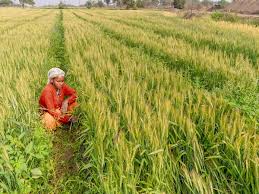
- 18 Sep 2024
Context
At the International Research Conference, the Deputy Governor of the Reserve Bank of India (RBI) addressed the crucial topic of financing sustainable agriculture, emphasizing the need for effective solutions.
What is Sustainable Agriculture?
Sustainable agriculture involves farming practices that meet current food demands while conserving resources for future generations. This approach aims to:
- Protect the environment
- Reduce reliance on chemical inputs
- Efficiently use water and land
The goal is to balance productivity, environmental health, and socio-economic equity.
Benefits of Sustainable Agriculture
- Environmental Conservation: Promotes biodiversity, reduces soil degradation, and conserves water.
- Economic Stability: Lowers dependence on costly chemical inputs, improving farmers’ profitability.
- Improved Food Security: Enhances soil health and crop diversity, ensuring resilience against climate change.
- Social Equity: Farmer Producer Organizations (FPOs) empower small and marginal farmers by providing access to technology, markets, and financial resources, enhancing their bargaining power.
Challenges Facing Sustainable Agriculture
- Low Productivity: Small, fragmented landholdings hinder investment in sustainable practices and mechanization.
- Dependence on Rainfall: Approximately 60% of Indian agriculture is rain-fed, making farmers vulnerable to climate variability.
- Price Volatility: Fluctuating prices force farmers to sell at low prices during peak harvests, while limited processing capacity leads to post-harvest losses.
- Access to Finance: Small farmers struggle to obtain credit, as the formal banking system often favors larger agribusinesses.
Initiatives for Sustainable Agriculture
- Farmer Producer Organizations (FPOs): Over 24,000 FPOs formed by March 2023 enhance farmers’ access to resources and markets.
- Warehouse Receipt Financing: This model allows farmers to store produce and sell when prices are favorable, stabilizing commodity prices.
- Priority Sector Lending (PSL): RBI regulations enable loans up to ?2 crore for agricultural activities, with higher limits for FPOs involved in assured marketing.
- Climate-Smart Agriculture (CSA): India is adopting practices such as drought-resistant crops and advanced water management.
- Technology Integration and Mechanization: Initiatives like the “Per Drop More Crop” scheme promote efficient water use, while Custom Hiring Centres (CHCs) enhance mechanization, reducing labor costs.
The Shock of Crumbling Infrastructure and the Path Forward

- 15 Sep 2024
Infrastructure is a cornerstone of economic development, and in a rapidly growing economy like India’s, its robustness is vital. Recent incidents, particularly the collapse of several under-construction bridges in Bihar, have cast a spotlight on significant issues within the Indian infrastructure sector, particularly in terms of quality control and project management. With the country's aim to become a developed nation by 2047, addressing these challenges is crucial for sustaining economic growth and ensuring safety.
Current Challenges
- Cost Overruns and Delays: One of the most pressing issues is the frequent occurrence of cost overruns and delays. According to a report by the Ministry of Statistics and Programme Implementation, 431 infrastructure projects with investments exceeding ?150 crore each have faced cost overruns totaling ?4.82 lakh crore as of December 2023. Additionally, a significant percentage of projects are delayed, with 36% running behind schedule by 25 to 60 months and 15% delayed for over 60 months.
- Bureaucratic Hurdles: Infrastructure projects often face delays due to the complex maze of clearances required. The implementation status of many projects indicates a lack of comprehensive planning and coordination, especially in urban infrastructure projects managed by local bodies that may lack sufficient capacity and expertise.
- Project Management Deficiencies: Traditional project management practices in India are often outdated. There is a need for an overhaul to incorporate modern tools and techniques for real-time data management and analysis. Insufficient attention during the planning stages of projects exacerbates these issues, leading to increased costs and project failures.
Path Forward
1. Integrating Modern Practices: Adopting modern project management practices is essential. This includes real-time data management, use of advanced analytics, and adopting global best standards. For example, in the United Kingdom, the Infrastructure and Projects Authority focuses on refining project processes, while countries like China and Saudi Arabia have established agencies dedicated to end-to-end project delivery.
2. PM Gati Shakti National Master Plan: India has initiated the PM Gati Shakti National Master Plan, aimed at integrating various government departments and stakeholders into a unified platform. This GIS-based ERP portal is designed to monitor real-time progress and enhance coordination among departments. While this initiative is promising, the effectiveness will depend on the quality of implementation and oversight.
3. Holistic Program Management Approach: The “Program Management Approach” used in industrial corridor development projects, like the Shendra-Bidkin in Aurangabad, exemplifies effective management of multiple projects simultaneously. This disciplined approach, involving systematic coordination of resources and information, can be applied more broadly across infrastructure projects.
4. Professional Training and Certification: To build a capable workforce, there is a need to establish agencies for professional training in project management. Similar to the Institute of Chartered Accountants of India, such agencies can focus on developing professional ethics and responsibilities in project execution and oversight.
Conclusion
With substantial taxpayer money allocated for infrastructure development, it is imperative to prevent the pitfalls of cost overruns and project failures. A robust program management system, incorporating modern practices and professional training, will enhance the efficiency and effectiveness of infrastructure projects. This approach will not only support India’s high-growth trajectory but also contribute to creating a safer, more affluent future for its citizens.
How can biotechnology be harnessed for economic development?
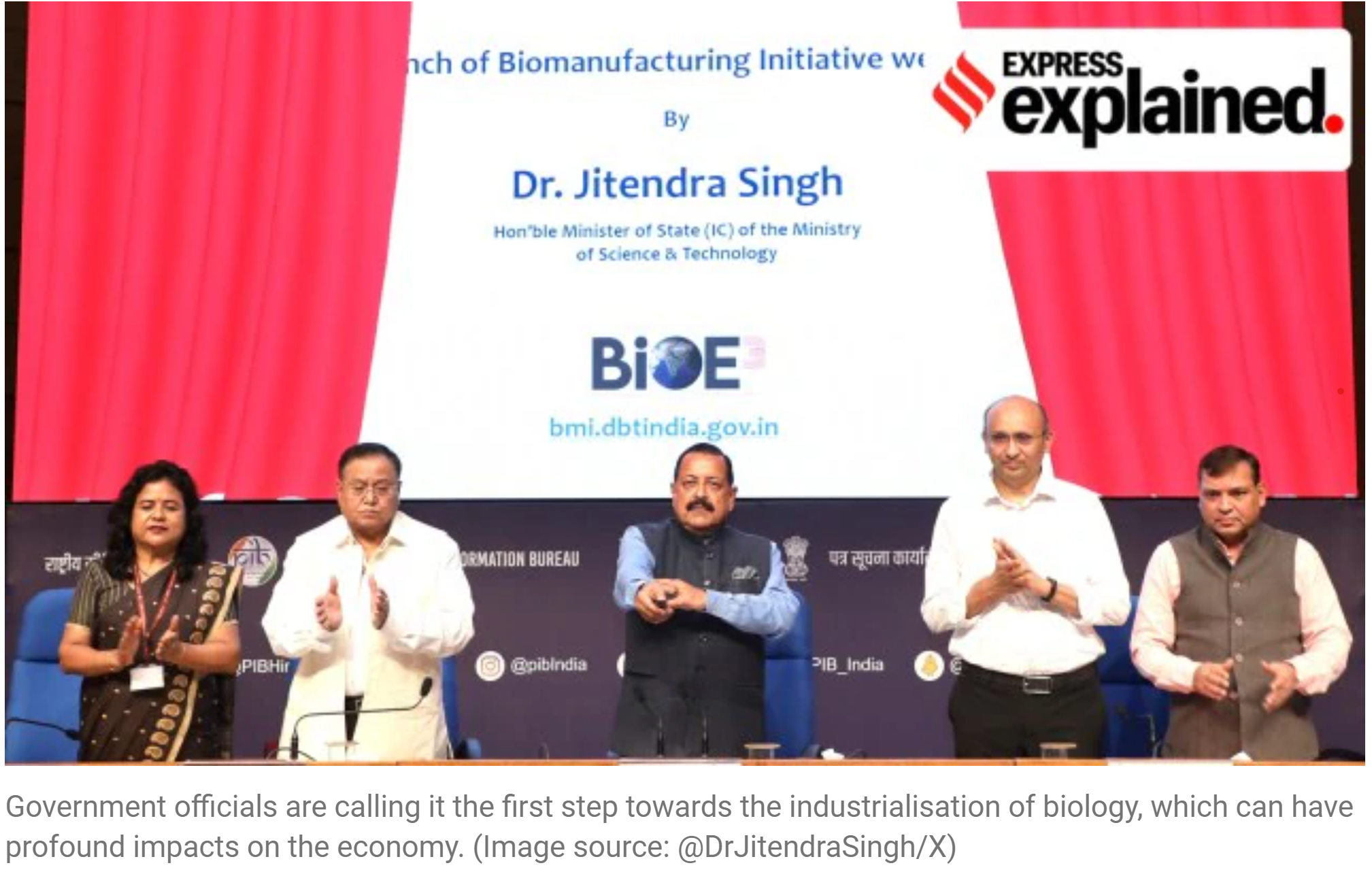
- 04 Sep 2024
The Centre unveiled its BioE3 (Biotechnology for Economy, Environment and Employment) policy last week.
On the face of it, the policy appears to be a routine attempt to create incentives and opportunities to energise growth in the biotech sector. But it is, in fact, about transforming existing industrial and manufacturing processes across various sectors to make them more sustainable and environment-friendly, and less wasteful.
The policy seeks to achieve this by harnessing the power of biotechnology, and developing new manufacturing methods that replicate, or mimic, processes found in natural biological systems.
Potential Benefits of Biotechnology:
- Medical Science:
- Cures for genetic disorders.
- Development of targeted therapies and treatments.
- Agriculture:
- Creation of new plant varieties with desirable traits.
- Increased crop yields and resistance to pests and diseases.
- Environmental Sustainability:
- Bioplastics: Eco-friendly alternatives to traditional plastics (e.g., polylactic acid from corn starch).
- Carbon Capture: Micro-organisms capture and convert CO2 into biofuels, reducing the need for CO2 storage.
- Synthetic Biology:
- Design of novel organisms for specific functions.
- Laboratory-grown organs for transplantation, reducing reliance on organ donors.
- Industrial Processes:
- Replacement of chemical processes with biological ones, reducing pollution.
- Production of sustainable materials and fuels.
BioE3 Policy Benefits for India:
- Economic Impact:
- Expected $2-4 trillion from biomanufacturing over the next decade.
- Prepares India for future economic opportunities in biotechnology.
- Research and Development:
- Promotes competencies, research, and talent development.
- Supports technology development and maturation.
- Biomanufacturing Hubs:
- Establishes facilities for producing bio-products: chemicals, enzymes, functional foods, and more.
- Focus areas: bio-based chemicals, smart proteins, precision therapeutics, climate-resilient agriculture, carbon capture, and marine/space research.
- Future Technologies:
- Supports development of life support systems for space and innovative marine-based products.
- Encourages collaboration among multiple government departments for effective implementation.
Redefining India's Poverty Threshold: Embracing New Perspectives
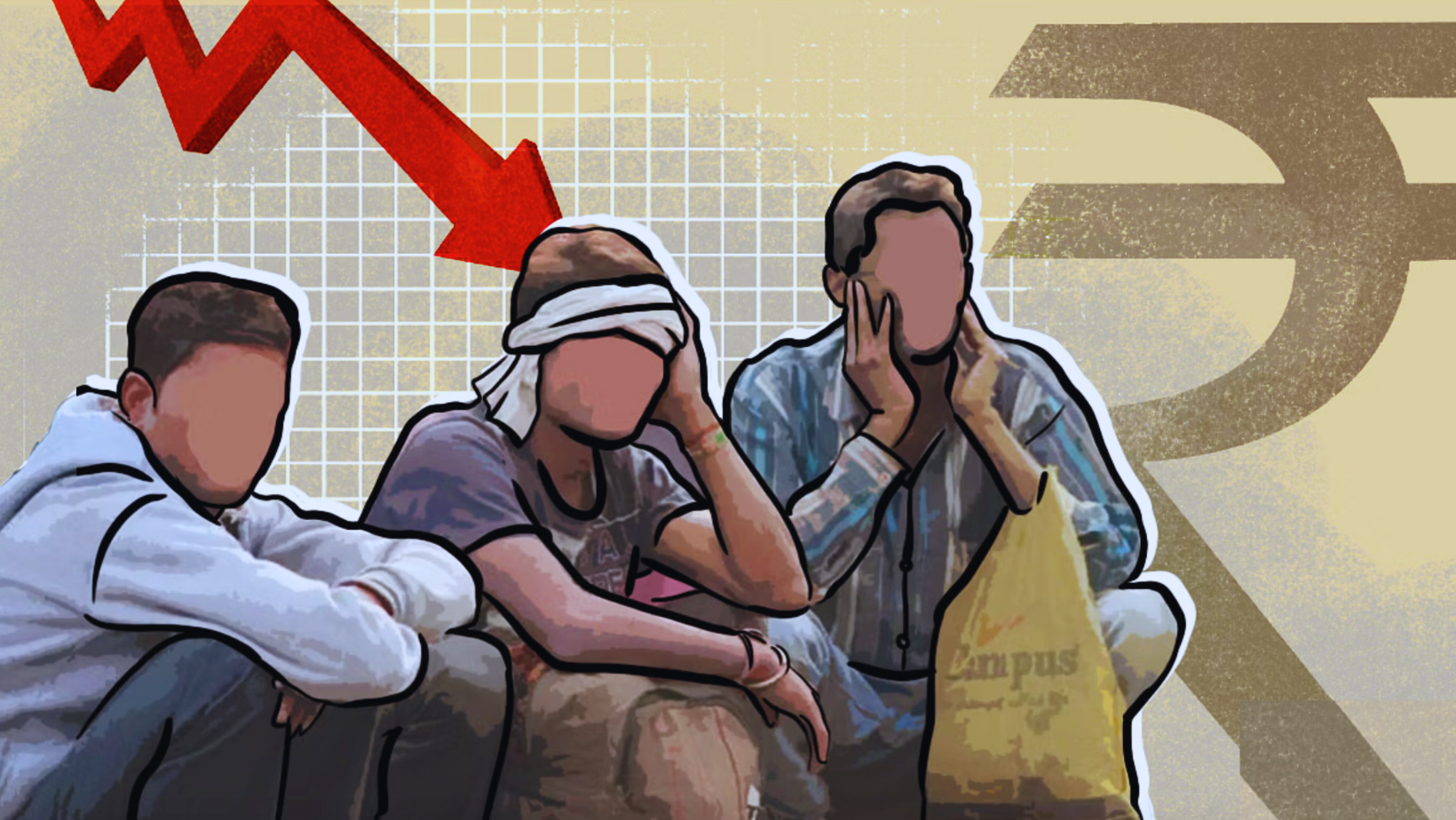
- 16 May 2024
Why is it in the News?
It is important to recognize India’s progress in alleviating poverty based on norms established in the 1970s. However, there is a need to update the poverty threshold to reflect contemporary notions of a ‘decent standard of living’.
Context:
- The recent release of the Household Consumer Expenditure Survey (HCES) data by the National Sample Survey Office (NSSO) has sparked renewed debates on poverty estimation in India.
- According to estimates derived from the methodologies proposed by the Tendulkar and Rangarajan Committees, poverty levels have reportedly decreased significantly since 2011-12, with figures standing at approximately 6.3% and 10% respectively for the year 2022-23.
Evolution of Consumption-Based Poverty Measurement in India:
- India's consumption-based poverty measurement has evolved since its inception in the 1960s.
- The approach was first introduced by the 1962 Working Group and further refined by the 1979 Task Force.
The 1979 Task Force:
- The task force defined the poverty line as the per-capita consumption expenditure level that could satisfy the average daily calorie requirement of 2,400 kcal in rural areas and 2,100 kcal in urban areas.
- This included associated non-food expenditures, and the monetary value of this norm became the foundation for subsequent poverty line revisions.
Tendulkar and Rangarajan Committees:
- These committees revisited the calorie norms and expenditure levels established by the 1979 Task Force.
- However, they did not adequately address non-food components.
- The committees argued that if expenditures on specific necessities meet nutritional requirements, they should also cover other essential non-food needs.
Implications of the estimates:
- The estimates indicate a notable decrease in poverty since 2011-12.
- However, some commentators advocate for a reassessment of the poverty line in light of changes in survey methodology.
- They contend that recent alterations in survey methodology in the Household Consumer Expenditure Survey (HCES) make previous methodologies unsuitable for analyzing HCES data.
- Surjit S. Bhalla, an economist and former member of the Economic Advisory Council, has provided comprehensive counterarguments to such assertions.
- Nevertheless, none of these discussions have addressed the suitability of current methodologies for monitoring poverty using consumption data.
Historical Background of Poverty Measurement:
- Early approaches: Consumption-based poverty measurement was initiated with a Working Group established by the Planning Commission in 1962 and further refined by a task force in 1979.
- This task force meticulously outlined its rationale for establishing a poverty line specific to India.
- Definition of poverty line: It was delineated as the per-capita consumption expenditure required to fulfil average daily calorie needs (2,400 Kcal in rural areas, 2,100 Kcal in urban areas) along with associated non-food expenses.
- This average calorie standard was derived from an analysis of the demographic and activity-based composition of the population during that period.
- The monetary value assigned to this standard became the foundation for subsequent revisions of poverty lines.
- However, the fundamental methodology underpinning this calculation was not critically reassessed.
Reevaluating Poverty Measurement Norms in India:
- The Tendulkar and Rangarajan Committees acknowledged the evolving demographic and activity composition in India, leading them to propose adjustments to calorie norms and expenditure levels for poverty measurement.
- However, these committees did not adequately reconsider the non-food components of the poverty line.
- At the core of their argument was the assertion that if spending within an expenditure class is sufficient to meet nutritional requirements, it should also be adequate to cover associated non-food needs.
- This assumption is questionable in the context of modern India, as the country has undergone significant changes since the 1970s when the Task Force on Poverty was established.
Demographic and Educational Indicators in India Since the 1970s:
Several significant demographic and educational shifts have taken place in India since the 1970s:
- Life Expectancy: Life expectancy at birth has improved from 49.7 years in 1970 to 69.4 years in 2018, reflecting advancements in healthcare and overall quality of life.
- Ageing Population: The proportion of individuals aged 60 and above has grown from 6.1% in the 1970s to 10.1% by 2021.
- This shift highlights the need for policies and programs that address the unique needs of an ageing population.
- Primary Education: The Gross Enrolment Ratio (GER) in primary education has experienced substantial growth, increasing from 62% in 1971 to universal enrolment today.
- This progress demonstrates a stronger emphasis on ensuring access to basic education for all children.
- Higher Education: The Gross Enrolment Ratio for higher education has also seen significant growth, rising from below 6% in the 1970s to approximately 28% in recent years.
- This development signals a greater focus on providing opportunities for advanced education and skill development.
Implications of Demographic and Educational Changes in India:
- The demographic and educational shifts observed in India since the 1970s have significant implications for out-of-pocket expenditures on health and education, as revealed by National Sample Survey (NSS) data. Key implications include:
Education Expenditures:
- The increase in primary and higher education enrolment has led to stiffer competition for aspirational jobs.
- This competition has driven higher spending on private tuition, leading to 'education poverty' among families with young children.
- Addressing this issue requires a change in the approach to education, as outlined in the National Education Policy (2020).
Health Expenditures:
- The rise in life expectancy and an ageing population have led to increased health expenditure needs, especially among the elderly.
- Changes in household composition and a growing elderly population living independently have further highlighted the need for better healthcare provisions.
- Political parties, like the ruling party with its Ayushman Bharat promise, recognize the importance of addressing these healthcare needs, indicating a potential shift in policy focus.
Elderly Population and Household Composition:
- The increase in life expectancy and decline in mortality rates have created a more age-diverse population with a larger elderly population.
- This ageing population necessitates greater attention to healthcare and financial support for the elderly, an issue that may not be adequately captured by current poverty measurement norms.
Redefining Poverty Norms for a Changing India:
- Current consumption-based poverty measures capture average population attributes but face limitations when accounting for increased population heterogeneity.
- As the population structure evolves, using averages to describe poverty becomes problematic.
- For example: Elderly households may meet nutrition expenditure requirements but struggle with healthcare costs.
- Households with young children might cover food needs yet face challenges in meeting aspirational education expenses, like private tuition.
- These examples highlight how households could surpass extreme poverty thresholds yet lack resources for a decent living standard.
- Consequently, updating poverty norms is essential to accurately capture the realities of diverse household needs.
- To achieve the Sustainable Development Goal of eradicating poverty in all forms, India must redefine its poverty norms, moving away from outdated standards based on 1970s data.
- By establishing fresh norms for the Amrit Kaal, India can better address the unique challenges faced by its population and make significant strides towards alleviating poverty.
Conclusion
India has made remarkable progress in alleviating poverty based on existing norms. However, to ensure a decent living standard for all citizens, it is crucial to update poverty measures to reflect current demographic and economic changes. By acknowledging the evolving needs of its population, India can continue making significant strides in poverty reduction and work towards a more inclusive and prosperous future.
Need for a Farmer-Friendly Agri-Export Policy
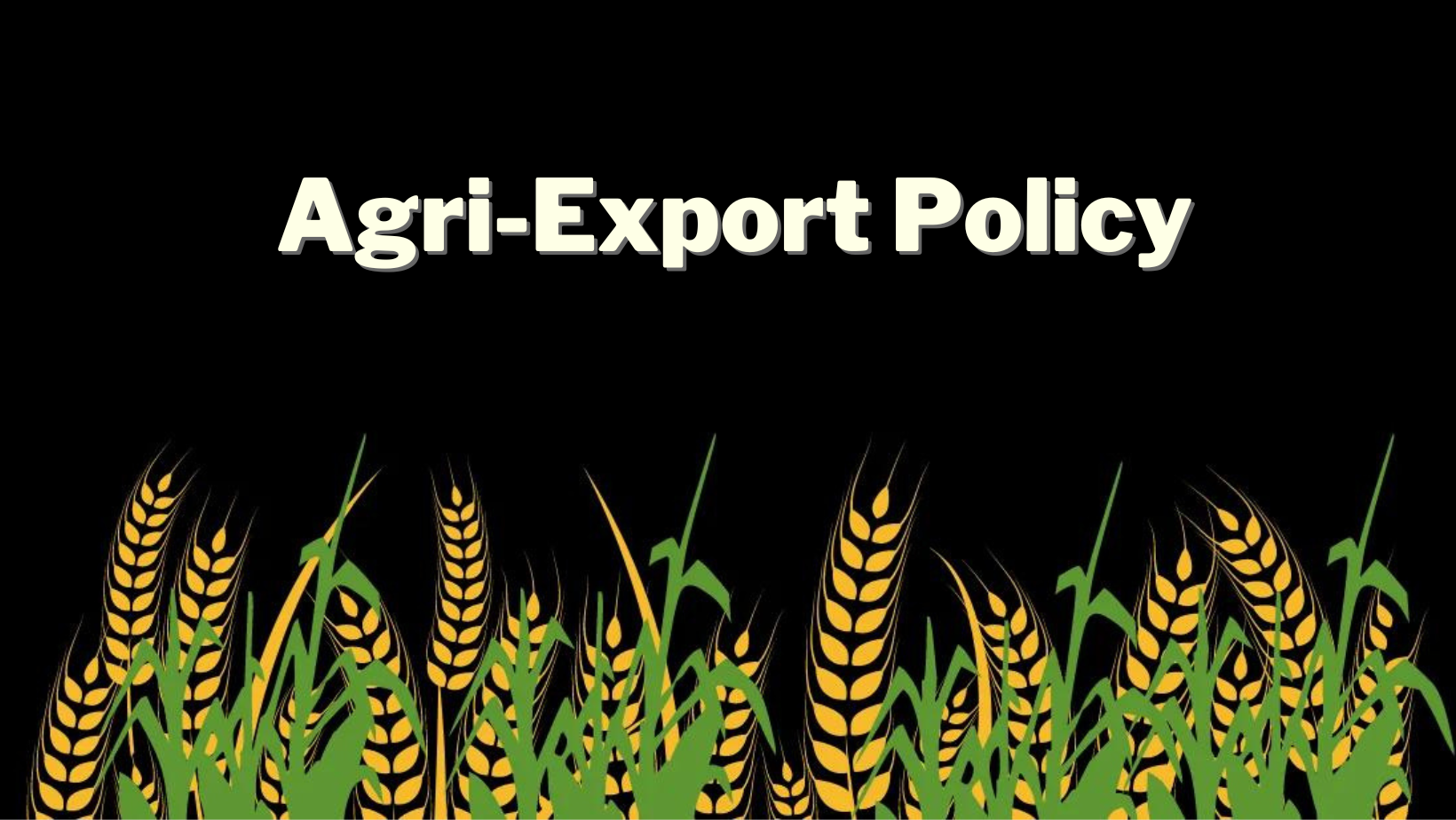
- 14 May 2024
Why is it in the News?
The current government policy, skewed towards consumers, unfavourably impacts farmers, necessitating a shift to enhance farmers' incomes.
Current State of India‘s Agricultural Exports:
- The current status of India's agri exports highlights a notable shortfall in achieving government targets.
- Despite aiming for $60 billion in 2022, actual exports in 2023-24 amounted to $48.9 billion, showing an 8% decrease from the previous year's $53.2 billion.
- Between 2004-05 and 2013-14, agricultural exports witnessed remarkable growth, expanding nearly fivefold from $8.7 billion to $43.3 billion.
- However, this growth trajectory slowed significantly in the period from 2014-15 to 2023-24, with an annual growth rate of merely 1.9%.
- Key exports include rice ($10.4 billion), marine products ($7.3 billion), spices ($4.25 billion), bovine meat ($3.7 billion), and sugar ($2.8 billion).
What is Agricultural Export Policy?
- The Agricultural Export Policy, commonly known as an agri-export policy, encompasses a range of governmental regulations, strategies, and incentives aimed at facilitating and encouraging the export of agricultural commodities from a specific nation.
- It encompasses diverse measures such as export subsidies, tariff adjustments, quality benchmarks, market access arrangements, financial support, and promotional efforts to assist agricultural producers and exporters in accessing global markets, enhancing their competitiveness, and broadening their export horizons.
- The Government of India introduced a comprehensive Agriculture Export Policy in December 2018, with the following objectives:
- To diversify our export basket, and destinations and boost high-value and value-added agricultural exports, including focus on perishables.
- To promote novel, indigenous, organic, ethnic, traditional and non-traditional Agri products exports.
- To provide an institutional mechanism for pursuing market access, tackling barriers and dealing with sanitary and phytosanitary issues.
- To strive to double India’s share in world agri exports by integrating with global value chains.
- Enable farmers to get the benefit of export opportunities in overseas markets.
What is the Need for an Agri-Export Policy?
- Economic Contribution: India's agricultural exports, totalling around USD 53 billion in the fiscal year 2022-2023, constitute a significant portion of overall exports, yet the country's global share in agricultural exports remains low at 2.2% as of 2016.
- Food Security Enhancement: Despite catering to a substantial portion of the world's population with limited resources, a well-designed export policy can generate additional revenue to invest in bolstering food security and augmenting farmers' incomes.
- Inflation Control: Agricultural exports have the potential to stabilize domestic prices, benefiting consumers and producers, particularly during periods of abundant harvests.
- Job Creation: With approximately 45% of the workforce engaged in agriculture, promoting agricultural exports can foster employment opportunities, particularly in rural areas where agriculture is predominant.
- Balance of Payments Support: Agricultural exports significantly contribute to India's foreign exchange reserves, helping to offset trade deficits and maintain currency stability.
- Crop Diversity Utilization: India's diverse agricultural production offers substantial export potential, which can be tapped into through a well-structured export policy.
- Trade Relations Strengthening: Agricultural exports are pivotal in fostering and reinforcing trade ties with countries like the United States, Saudi Arabia, and the United Arab Emirates.
- Addressing Structural Challenges: The policy framework can effectively tackle obstacles such as low farm productivity, inadequate infrastructure, global price fluctuations, and limited market access.
What are the Challenges in India's Agri-Export Policy?
Several challenges hamper the effectiveness of India's agricultural export policy, requiring strategic interventions to unleash the sector's full potential:
- Restrictive Export Policies: Favoring domestic consumers over farmers often impedes the achievement of export targets.
- Restrictions on commodities like Basmati rice, such as the Minimum Export Price (MEP) of USD 1,200, can limit export volumes.
- Subsidy-Centric Schemes: Increased subsidies during election periods, including food and fertilizer subsidies, strain fiscal discipline.
- Populist measures like loan waivers and free power for farmers impact the financial health of the agricultural sector.
- Insufficient R&D Investment: Low investment in agricultural R&D, approximately 0.5% of agricultural GDP, hinders growth prospects.
- Doubling or tripling R&D investments is essential for India to excel in agricultural production and exports.
- Quality and Standards: Maintaining consistent quality and meeting international standards is challenging.
- Variability in quality, compliance issues, and difficulties in meeting Sanitary and Phytosanitary (SPS) Measures due to pests and diseases impede exports.
- Infrastructure: Inadequate infrastructure for storage, transportation, and processing results in post-harvest losses, reducing export competitiveness.
- Environmental and Sustainability Concerns: Balancing the growth of agricultural exports with environmental sustainability is crucial.
- Over-exploitation of resources may have long-term consequences, necessitating careful resource management and sustainable practices.
Government Initiatives Promoting Agri-Export in India:
To unlock the full potential of India's agricultural exports, the government has launched several initiatives to enhance productivity, modernise infrastructure, and promote sustainable practices. Key schemes include:
- E-NAM (National Agriculture Market): A pan-India electronic trading portal, E-NAM enables farmers to sell directly to buyers, reducing intermediaries and ensuring fair prices.
- E-NAM has integrated 1,000 wholesale markets and 585 mandis across 18 states and 3 Union Territories.
- National Horticulture Mission (NHM): Promoting sustainable horticulture practices, including organic farming and precision farming, NHM supports the establishment of over 100 Farmer Producer Organizations (FPOs) for horticultural products.
- The mission also backs the production of high-value horticultural products for export.
- Market Access Initiative (MAI): Supporting export promotion activities, such as participation in trade fairs, capacity building, and market research, MAI has facilitated Indian exporters' participation in over 100 international trade fairs annually.
- Operation Greens: With an allocation of INR 500 crores in the Union Budget 2023-2024, Operation Greens stabilizes the supply and prices of essential agricultural commodities like fruits and vegetables.
- The scheme reduces price volatility, ensures fair prices for farmers, and fosters sustainable agri-exports.
- Scheme for Agro-Marine Processing and Development of Agro-Processing Clusters (SAMPADA): With a budgetary allocation of INR 6,000 crores for the period 2020-2021 to 2024-2025, SAMPADA modernizes infrastructure for agro-processing clusters.
- This reduces post-harvest losses and increases shelf life, improving the overall export potential.
- APEDA: Promoting the export of scheduled products, APEDA provides guidelines for sustainability and quality.
- APEDA facilitated exports of agricultural products worth USD 22.17 billion during the financial year 2022-2023.
- Agri Export Zones (AEZs): AEZs provide infrastructure development and technology adoption for sustainable agri-exports.
- Established for commodities like mangoes, grapes, and spices, AEZs have contributed to increased export volumes.
- Promotion of Organic Farming: Initiatives promoting organic farming for environmental sustainability and the export potential of organic products have resulted in increased organic farming area, reaching 3.90 million hectares in 2022-2023, with exports of organic products totalling USD 1.04 billion.
Way Forward for a Stable Agricultural Export Policy in India:
To establish a stable and prosperous agri-export policy in India, several strategic actions and considerations must be taken into account. These include:
- Prioritizing Farmer Welfare: Ensuring that farmers receive fair prices for their produce is crucial for the success of agricultural exports and the well-being of the farming community.
- Supporting Domestic Consumers: Implementing targeted income policies to support vulnerable populations and maintain food security for domestic consumers.
- Enhancing Productivity: Increasing agricultural productivity through investments in R&D, seeds, irrigation, fertilizers, and improved farming practices to bolster global competitiveness.
- Diversifying Export Basket: Expanding the range of agricultural exports, focusing on value-added products, and targeting a wide array of international markets to minimize reliance on a select few commodities.
- Quality Assurance: Implementing strict quality standards and certification mechanisms to ensure that exported agricultural products meet international norms.
- Establishing uniform quality and standardization protocols is vital, particularly for horticultural items.
- Infrastructure Development: Investing in modern infrastructure, such as cold storage, processing facilities, transportation, and logistics, to reduce post-harvest losses and enhance export competitiveness.
- Offering financial incentives, subsidies, and credit facilities can encourage investments in agriculture, infrastructure, and processing facilities.
- Technology Adoption: Promoting the use of advanced agricultural technologies, precision farming, and efficient irrigation techniques to boost productivity.
- Encouraging the growth of agri-startups and fostering innovative solutions can enhance agricultural production and export efficiency.
- Environmentally Sustainable Practices: Encouraging sustainable farming practices, including organic farming, to ensure environmental sustainability in agriculture.
- Learning from Global Best Practices: Gaining insights from successful agricultural export policies and best practices in other countries can inform India's approach.
- Strengthening diplomatic efforts to negotiate favourable trade agreements and reduce trade barriers will provide better access to international markets.
Conclusion
To ensure India's continued growth in global agricultural trade, a stable export policy is crucial, embodying dynamism, responsiveness, and adaptability. It must prioritize agricultural sustainability, environmental responsibility, and farmer welfare, securing India's position in international trade. Balancing economic growth with farmer well-being and environmental concerns is key to unleashing India's agricultural potential. Forward-looking policies and innovative solutions will strengthen the agri-export sector, fostering a prosperous and sustainable future for all.
Evaluating the Enhancement of State-run Companies Under Modi Government and Realities

- 13 May 2024
Why is it in the News?
Finance Minister Nirmala Sitharaman on Wednesday said the government's focus on capital expenditure and infrastructure development has directly benefited state-run companies and led to substantial growth in their stock performance.
Context:
- In a democratic system, robust opposition plays a vital role in upholding accountability and fostering balanced governance.
- However, the absence of an effective opposition can impede democratic processes, resulting in unfounded criticisms and ineffective checks and balances.
- Prime Minister Narendra Modi's government has encountered such obstacles, especially concerning its oversight of public sector enterprises (PSEs).
- Thus, it is imperative to evaluate the performance of PSEs during the Modi administration, juxtaposing it with historical contexts, and elucidating the government's strategic initiatives aimed at their revitalization.
Strategic Divestment Initiatives by the Modi Government:
- The divestment strategy adopted by the Modi government involves a well-thought-out approach to balance fiscal objectives and national interests.
- This is exemplified through the decisions made regarding Air India and Bharat Petroleum Corporation Ltd (BPCL).
- Air India Privatisation: Air India's transition from a loss-making entity reliant on government subsidies to a privately-owned enterprise signifies a strategic move to enhance efficiency and competitiveness in the aviation sector.
- Privatisation aims to inject agility and market responsiveness into Air India's operations, fostering growth and profitability amidst intense industry competition.
- Post-privatisation, Air India's ambitious expansion plans underscore its renewed focus on capturing market opportunities and improving financial performance.
- Retaining Stake in BPCL: Contrary to Air India, the government's decision to maintain ownership of Bharat Petroleum Corporation Ltd (BPCL) reflects strategic considerations linked to energy security and sectoral importance.
- BPCL's extensive retail network and expertise in areas like ethanol blending align with the government's objectives in sustainable energy transition.
- By retaining control over BPCL, the government ensures influence over critical sectors while leveraging the company's capabilities to advance national priorities such as sustainability and energy resilience.
- Strategic Decision-Making: The government's divestment strategy goes beyond immediate financial gains, considering broader strategic implications and long-term national interests.
- Factors like sectoral significance, market dynamics, and alignment with development goals inform divestment decisions, ensuring they contribute to India's economic growth and strategic objectives.
- Through a strategic divestment approach, the government aims to strike a balance between fiscal imperatives and broader developmental priorities, driving sustainable and inclusive growth.
An In-depth Review of PSE Performance During the Modi Era:
- Under Prime Minister Narendra Modi's leadership, Public Sector Enterprises (PSEs) have experienced notable growth and transformations across various sectors. This comprehensive analysis showcases the strides made by PSEs under the current administration:
- Financial Sector: The Modi government's intervention and reforms revitalized public sector banks (PSBs), inherited with significant non-performing assets (NPAs).
- PSBs reported their highest-ever profits and lowest-ever NPAs in the fiscal year 2022-23, indicating a substantial improvement in their financial health and investor trust.
- Oil and Gas Sector: Oil India Ltd, an upstream oil company, achieved its highest-ever crude and natural gas production, contributing to India's energy security.
- Indian Oil Corporation Limited (IOCL) reported record-high refinery throughput, sales volume, and net profit, highlighting its operational efficiency and market competitiveness.
- Energy Generation: Bharat Petroleum Corporation Limited (BPCL) achieved its highest-ever profit for the first nine months of any fiscal year, demonstrating resilience and adaptability in a dynamic market.
- Coal India registered its highest-ever production, underscoring the government's emphasis on maximizing domestic coal output to meet growing demand.
- Infrastructure Development and Expansion: National Thermal Power Corporation (NTPC) set a new record for the highest-ever electricity generation in a year, strengthening India's power infrastructure.
- PSEs like Indian Railways and Ports have undertaken ambitious plans to modernize and expand infrastructure capacity, supporting economic growth and development.
Notable Differences Between the Current Government's Strategy and Results and Those of its Predecessors:
- Comparing the current government's approach to managing Public Sector Enterprises (PSEs) with that of its predecessors reveals significant differences:
- UPA Era Mismanagement: During the UPA regime, PSEs were frequently subjected to political interference and corruption, resulting in inefficiency and stagnation.
- Sectors like Indian Railways faced systemic challenges, such as bureaucratic hurdles and lack of accountability, leading to suboptimal performance and reduced contributions to the economy.
- Corruption and Cronyism During Past Administrations: The UPA era was tainted by major corruption scandals, damaging the credibility of PSEs and eroding public trust in the government's capacity to manage public resources.
- Political-corporate alliances further undermined the integrity and efficiency of PSEs, compromising their capacity to serve the public interest.
- Policy Paralysis and Inefficiency: The UPA government's policy paralysis and administrative inefficiencies hindered innovation and growth in the public sector.
- Delayed projects and bureaucratic obstacles led to missed economic opportunities and job creation constraints.
- Modi Government's Transformative Reforms: The Modi government has pursued a reform agenda to revitalize and enhance the competitiveness of the public sector through strategic vision, decisive action, and an emphasis on transparency and accountability.
- Prime Minister Modi's leadership has emphasized accountability and performance, with measures to streamline decision-making processes, reduce red tape, and hold PSEs accountable.
- Proactive governance and strategic initiatives, including divestment, strategic partnerships, and infrastructure investments, have unlocked new growth opportunities, improved operational efficiency, and positioned PSEs for long-term success in a global market.
Conclusion
- The governance of Public Sector Enterprises (PSEs) under Prime Minister Modi's leadership marks a transformative era characterized by forward-thinking reforms, efficient management, and a clear vision for national development.
- In the face of opposition critique, the government's strategic interventions have successfully positioned PSEs as significant contributors to India's growth trajectory, ultimately fostering a brighter and more prosperous future for the nation and its citizens.
- Through a combination of bold decision-making, transparency, and a commitment to accountability, the Modi government has revitalized the public sector and enhanced its competitiveness.
- By addressing the challenges inherited from previous administrations, the current leadership has demonstrated its dedication to promoting sustainable growth and development while effectively managing PSEs for the greater good of the country.
Challenges Faced by MSME Sector in India & Its Solution
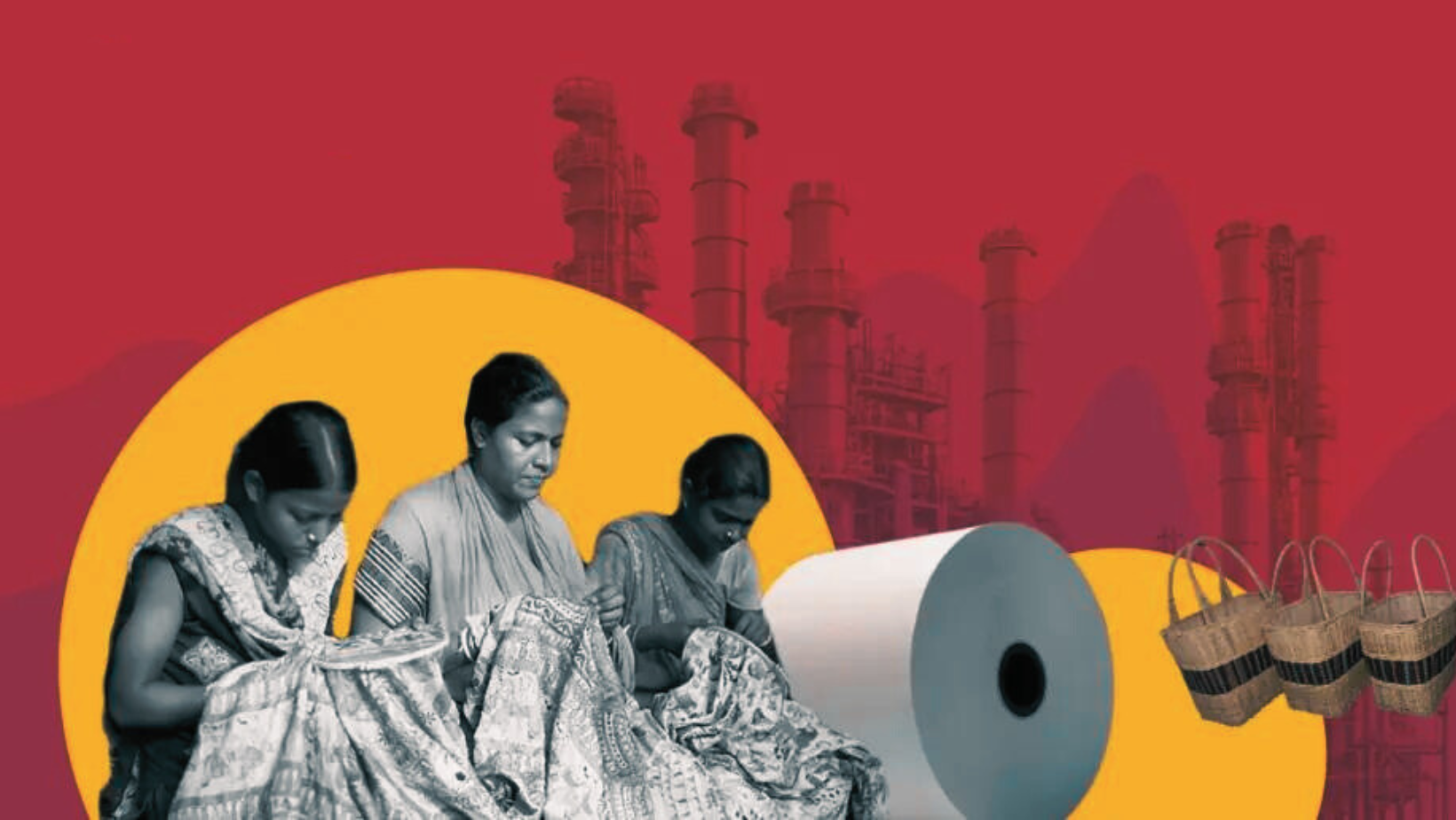
- 06 May 2024
Why is it in the News?
A new provision in the Income-Tax Act from Budget 2023-24 ensures prompt payments to MSMEs however, it's causing a problem: large companies are cancelling orders from registered MSMEs and giving them to unregistered ones.
Context:
- The Union Budget 2023-24 brought in a fresh provision in the Income-Tax (IT) Act to ensure timely payments to micro, small, and medium enterprises (MSMEs) within 45 days of supplying goods or services.
- Yet, this measure has led to an unusual issue: big corporations are cancelling orders from registered MSMEs and redirecting them to unregistered ones.
What is the Latest Tax Compliance Guidelines for MSMEs:
- In India, businesses typically record expenses as they occur (accrual basis), regardless of whether payment has been made.
- However, under Section 15 of the MSMED Act 2006 and the newly enacted Section 43B(h) of the IT Act, businesses are obligated to settle payments with MSME Registered Enterprises within 15 days or up to 45 days if stipulated in an agreement.
- Failure to adhere to this regulation results in the inability to deduct these payments as expenses in the same fiscal year, potentially increasing taxable income and business taxes.
- Moreover, delayed payments to MSME-registered units incur interest liabilities, placing the responsibility on the payer to fulfil outstanding dues.
What is MSME?
- MSMEs are Micro, Small, and Medium Enterprises that are usually involved in the manufacture and production of goods and commodities.
- These business enterprises are the backbone of a country’s development and provide holistic development to the rural and urban population of the country.
- The MSME sector in India makes a contribution of around 30% to the nation’s GDP.
- Moreover, it contributes about 40% to the total exports of India, and
- It provides more than 110 million job opportunities in the country.
- The Government of India introduced the MSME under the Micro, Small, and Medium Enterprises Development (MSMED) Act of 2006.
- MSMEs are managed under the Ministry of MSMEs.
- The objective of MSMEs is to primarily engage in manufacturing, processing, production, and preservation of goods and commodities.
- These business enterprises play an important role in the socio-economic development of the country.
- Thus, the importance of MSME in the growth and development of India is vital.
MSME Classification:
- Businesses are classified as micro, small or medium enterprises based on their turnover and the sector they operate in (manufacturing/services).
Types of MSME:
According to the Micro, Small and Medium Enterprises Development (MSMED) Act 2006, MSMEs are of 2 types:
- Manufacturing Enterprises: Business enterprises that are involved in the manufacturing of goods, as stated under Schedule I of the IDRA 1951, are categorised as MSMEs.
- Additionally, all business enterprises that contribute value to the finished products by making use of plants and machinery also come under MSMEs.
- Service Enterprises: Business enterprises that provide services and come under the category of ‘enterprises’ as stated in the MSMED Act are service enterprises and come under MSMEs.
- However, individual service providers do not qualify as service enterprises.
Importance of MSME in the Indian economy:
- Export: MSMEs’ contribution to the exports from India was recorded at 45.56% till Sept. 2023.
- Such high volumes of exports facilitate international trade and contribute to industrial growth within the country.
- Employment: MSMEs create employment in rural and urban areas of the country.
- These business enterprises are the second largest employment sector in India after agriculture.
- By setting up units in rural and underdeveloped areas, MSMEs contribute to the better living standards of people from lower socioeconomic and rural areas as well.
- Innovation: MSMEs bring innovation to various processes in the manufacturing of goods and commodities.
- They provide the necessary skills, tools, and technology for automation and advancement in their sectors.
- It contributes to the overall technological upgradation of the country and promotes research and development.
- Entrepreneurship: MSMEs promote inclusiveness in the country by facilitating the entry of aspiring entrepreneurs in various sectors.
- They promote healthy competitiveness among entrepreneurs, which fuels industrial growth.
Challenges faced by the MSME sector in India:
- Financial: Access to finance is a significant hurdle for MSMEs, with only 16% receiving timely finance.
- This forces them to rely on their own resources, hindering their growth prospects.
- Even larger firms struggle to access cheaper credit from formal banks.
- Regulatory issues: MSMEs face challenges with tax compliance and labour law changes, which have proven costly.
- Despite attempts to make the sector more competitive, compliance with regulations and tax registration remains difficult, leading to low capital and business closures.
- Infrastructure: India's infrastructure is crucial for the MSME sector, especially in the outsourcing industry.
- However, inadequate infrastructure affects their efficiency and ability to compete globally, limiting their growth potential.
- Low productivity & Lack of innovation: MSMEs may lack high productivity but offer value through cost efficiency and providing goods at lower prices.
- However, their small-scale production and low margins put them at a disadvantage compared to larger firms.
- Indian MSMEs often rely on outdated technologies and lack entrepreneurs who embrace new tools and technologies.
- This hampers their productivity and competitiveness, especially when compared to larger firms in sectors like e-commerce and call centres.
- Technical changes: MSMEs have faced significant technical changes over time, impacting their growth potential.
- Changes in land ownership rights have led to mismanagement and reduced productivity, highlighting the need for adaptability.
- Competition & Skills: MSMEs face fierce competition from larger firms, exacerbated by the rise of e-commerce and globalization.
- While competition is not new, MSMEs struggle to withstand the pressure in areas such as agriculture, garments, and tourism.
- MSMEs lag behind in terms of skills compared to their counterparts in other countries.
- Dependence on informal workers with limited technical skills hampers productivity and forces smaller firms into low-skilled jobs, hindering long-term growth.
- Lack of professionalism: Many Indian MSMEs lack professionalism, making them vulnerable to corruption and abuse of power.
- This significantly impacts their business productivity and overall growth.
- Lack of standardized policies: India lacks consistent MSME policies, resulting in inconsistent development and entrepreneurship promotion programs.
- While progress has been made in Delhi, nationwide efforts are necessary for Indian firms to compete globally.
Government MSME Schemes and Policies in India:
- FIRST: Keeping in view the crucial role MSMEs play in the development of the country, the central government announced the launch of FIRST (Forum for Internet Retailers, Sellers, and Traders).
- The program aligns with the government’s Digital India movement and educates and informs MSMEs about opportunities to become self-reliant and digitally capable.
- MSME Innovation Scheme: Under this scheme, MSMEs can enjoy reimbursement of the cost of Intellectual Property Rights applications for new ideas and designs.
- The programme provides financial and other resources to MSMEs to encourage innovation.
- CGTMSE: The Credit Guarantee Trust Fund for Micro and Small Enterprises scheme provides financial assistance of up to ?2 Crore to new businesses.
- CLCSS: The Credit Linked Capital Subsidy Scheme provides capital subsidies to MSMEs operating in the khadi, village, and coir sectors.
- The subsidy allows these businesses to acquire technological innovation and upgradation.
- ASPIRE: ASPIRE, or A Scheme for Promotion of Innovation, Rural Industries, and Entrepreneurship, fosters innovation and entrepreneurship in rural and agricultural sectors by establishing advanced technology networks.
- Pradhan Mantri Mudra Yojana (PMMY): The PMMY scheme provides loans up to Rs. 10 lakhs to MSMEs.
- The scheme has three categories of loans: Shishu (up to Rs. 50,000), Kishore (up to Rs. 5 lakhs), and Tarun (up to Rs. 10 lakhs).
- The loans do not require collateral and are available to both new and existing MSMEs.
- Stand-Up India: The Stand-Up India scheme provides loans up to Rs. 1 crore to SC/ST and women entrepreneurs for setting up new ventures in the manufacturing, services, or trading sectors.
- The scheme aims to promote entrepreneurship among these communities and provides support through the entire loan process.
Way Forward:
- Creating awareness about government schemes and initiatives: Stakeholders should take active measures to educate MSMEs about the various schemes and initiatives launched by the government to promote SME financing.
- This will help MSMEs take advantage of these schemes and secure financing for their businesses.
- Developing innovative financing solutions: Financial institutions should develop innovative financing solutions that cater to the unique needs of MSMEs.
- These solutions can include alternative credit scoring mechanisms, digital lending platforms, and other innovative solutions that reduce the reliance on collateral and traditional credit histories.
- Encouraging private-public partnerships: Private-public partnerships can be a powerful tool to promote SME financing.
- Governments and private sector companies can work together to develop financing solutions that are tailored to the needs of MSMEs.
- Reducing the cost of credit: High interest rates on loans can be a significant barrier for MSMEs to secure financing.
- Stakeholders should take measures to reduce the cost of credit for MSMEs, which will make it easier for them to invest in their businesses and drive growth.
- Leveraging technology: Technology can play a crucial role in improving SME financing.
- Stakeholders should leverage technology to develop digital lending platforms, credit scoring mechanisms, and other solutions that can reduce the cost and time involved in securing financing.
Conclusion
MSMEs are vital to India's economy, driving exports, employment, innovation, and entrepreneurship. Although they face financial, regulatory, and infrastructure hurdles, fostering a supportive environment through awareness, innovative financing, partnerships, cost reduction, and technology can empower MSMEs to overcome challenges and significantly contribute to India's socio-economic growth.
Get the Sustainable Development Goals Back on Track
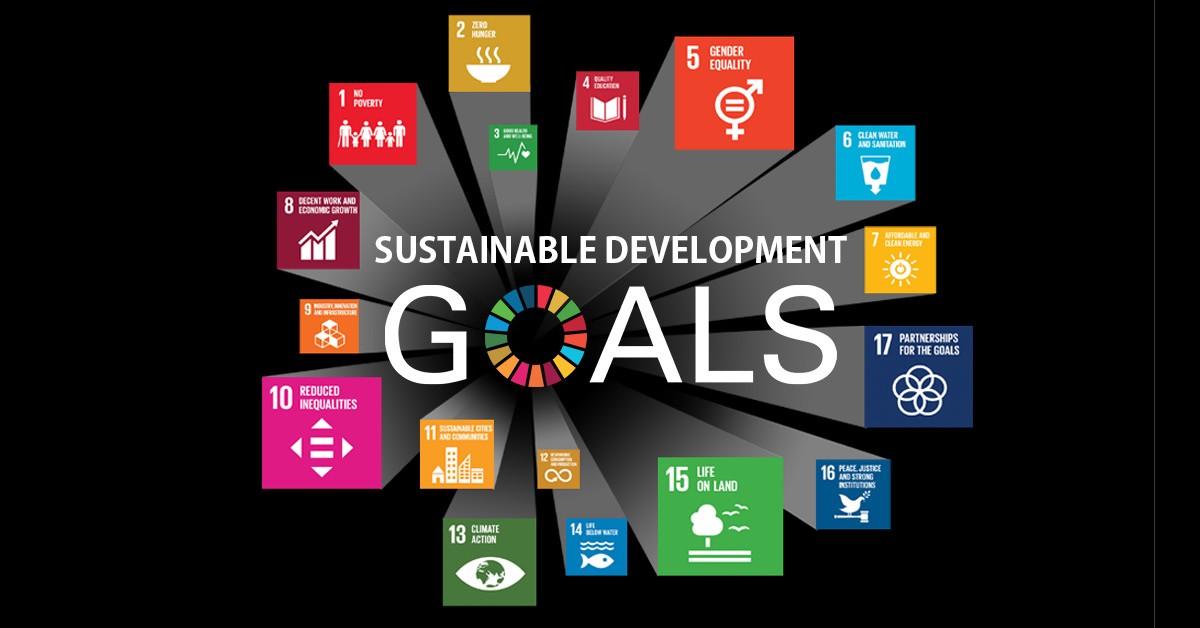
- 04 May 2024
Why is it in the News?
2024 is an election year across the world and newly elected governments need to focus on the all-important sustainability issue.
Context:
- The United Nations Summit on Sustainable Development Goals (SDGs) held in September in New York presented a chance to assess progress toward the lofty Agenda 2030 goal.
- The COVID-19 pandemic and other worldwide crises have made progress towards these goals difficult, despite the fact that they are part of a framework that has been widely agreed upon.
- It is critical to evaluate the state of SDG implementation, investigate critical areas that call for immediate attention, talk about the results of academic studies on the SDGs' political influence, and suggest ways to advance sustainable development.
What is Sustainable Development?
- Sustainable development entails fostering development that fulfils present needs while safeguarding the capacity of future generations to meet their own needs.
- Coined by the Brundtland Commission in its 1987 report, "Our Common Future," this definition remains widely embraced.
- Embracing sustainable development involves collaborative endeavours aimed at constructing an inclusive, sustainable, and resilient future for both humanity and the environment.
What is the Progress and Emerging Challenges in SDG Implementation?
- Slow Progress and Growing Concerns: The path toward achieving the Sustainable Development Goals (SDGs) has been marred by sluggish progress and mounting concerns, casting doubt on the world's ability to attain the 2030 targets.
- Despite initial optimism following the adoption of Agenda 2030 by the UN General Assembly in 2015, reports indicate inadequate progress and deviation from the intended trajectory.
- While there were modest improvements noted between 2015 and 2019, particularly in areas like poverty reduction and access to essential services, they fell significantly short of the necessary benchmarks outlined in the agenda.
- Challenges Amplified by Global Crises: The onset of the COVID-19 pandemic and other global crises has compounded the hurdles in SDG achievement.
- The pandemic, in particular, has triggered profound socioeconomic repercussions, disrupting economies, widening inequalities, and propelling millions into poverty.
- The diversion of resources and attention toward addressing immediate health and economic exigencies has further impeded advancements toward long-term sustainable development objectives.
- Concerns Over Environmental Sustainability: A notable concern arises from the insufficient emphasis on goals related to environmental sustainability and biodiversity conservation.
- Critical objectives such as sustainable consumption and production, climate action, and marine and terrestrial biodiversity preservation have been overlooked, jeopardising the welfare of present and future generations.
- Neglecting these environmental imperatives not only undermines progress toward specific SDGs but also poses existential threats to humanity and the planet.
- Fragmented Approach to SDG Pursuit: Furthermore, the prevailing approach to SDG pursuit often disregards the interconnected and indivisible nature of the goals.
- The SDGs are interlinked, with progress in one goal intricately linked to advancements in others.
- Yet, the disjointed strategies adopted by many nations and stakeholders fail to acknowledge these interconnections, leading to isolated efforts unlikely to yield substantive outcomes.
- Without a holistic and cohesive approach to sustainable development, achieving the overarching objective of harmonising human well-being with environmental health remains elusive.
International Promises and Real-World Execution:
Renewed Pledges from International Leaders:
- Amidst these developments, the UN SDG Report 2023 underscored five critical areas necessitating immediate attention:
- The government's commitment to seven years of accelerated, sustained, and transformative actions to fulfil SDG promises;
- Concrete, comprehensive, and targeted governmental policies to eradicate poverty, mitigate inequality, and combat environmental degradation, prioritising the empowerment of women, girls, and marginalised communities;
- Enhancement of national and subnational capacities, institutional accountability, and governance mechanisms to expedite progress;
- Reaffirmation of the international community's commitment to provide assistance and mobilise resources for developing nations, alongside fortifying the UN development system.
- Acknowledging the gravity of the situation, world leaders reiterated their commitments and pledged intensified efforts to achieve the SDGs, envisioned as the global pathway out of crises by 2030.
- However, the extent to which these global declarations translate into action at the grassroots level remains uncertain.
Challenges in National Implementation:
- Despite governments' global vows, significant disparities often exist between rhetoric and practical implementation on the national stage.
- Political considerations, competing agendas, and resource limitations can impede the effective execution of SDG-related policies.
- Furthermore, inadequate coordination and coherence among various government departments and administrative tiers may lead to fragmented initiatives, diminishing the overall efficacy of SDG implementation efforts.
Academic Perspectives and Suggestions:
- Limited Political Influence: The research highlights that while the SDGs have sparked discussions and prompted some normative and institutional adjustments, their direct political impact at national and local levels remains constrained.
- Despite international endorsement, the SDGs have yet to yield significant political outcomes in many nations, underscoring the necessity for a nuanced understanding of the factors shaping SDG implementation and the pathways for driving political transformation.
- Systemic Strategies for SDG Achievement: The study underscores the significance of embracing a systemic approach to unlock the transformative potential of the SDGs.
- This entails identifying and managing trade-offs while maximising synergies across diverse goals.
- By addressing interconnected challenges comprehensively, policymakers can capitalise on synergistic effects and enhance the efficacy of their interventions.
- For instance, initiatives promoting renewable energy can simultaneously advance climate action (SDG 13), foster economic growth (SDG 8), and improve access to clean water and sanitation (SDG 6).
- Customised Implementation Approaches: Moreover, the study stresses the importance of tailored strategies for SDG implementation tailored to regional and national contexts.
- Cookie-cutter solutions are unlikely to succeed given the varied socio-economic, political, and environmental landscapes in which the SDGs are being pursued.
- Instead, policymakers should identify context-specific entry points and leverage existing resources and capacities to drive progress.
- This may involve targeting specific sectors or geographic areas requiring interventions and engaging marginalized communities to ensure their voices and needs are addressed.
- Pragmatic Steps to Enhance Implementation: Additionally, the study provides pragmatic recommendations for bolstering SDG implementation.
- These encompass strengthening governance frameworks and accountability mechanisms, mobilising financial resources, fostering innovation and technology dissemination, and nurturing partnerships among governments, civil society, the private sector, and other stakeholders.
- By adopting a multi-faceted approach addressing political, economic, social, and environmental dimensions, policymakers can foster an enabling environment for transformative change.
Conclusion
The evaluation of SDG advancement highlights the imperative for swift and collaborative measures to overcome prevailing hurdles and hasten advancement. As 2024 heralds elections in numerous nations, incoming administrations have a chance to elevate sustainability as a focal point and harmonise domestic policies with the SDGs. By infusing sustainability tenets into governance structures and policy formulations, governments can play a pivotal role in expediting SDG attainment.
Analysing Labour on a Warming Planet

- 02 May 2024
Why is it in the News?
The latest report from the International Labour Organization (ILO), titled 'Safeguarding Workers in a Changing Climate', underscores the pressing necessity to ensure the resilience of labour in the face of climate change.
Context:
- The International Labour Organisation (ILO) recently released a report titled "Ensuring Safety and Health at Work in a Changing Climate," highlighting the urgency of climate-proofing labour practices to protect workers' well-being.
- As the planet experiences warming, workplace environments evolve, and the ILO emphasizes the need to update occupational safety and health (OSH) regulations to address emerging risks.
- According to the report, over one-third of the global population is exposed to extreme heat each year, resulting in nearly 23 million work-related injuries.
- The ILO urges an overhaul of existing OSH laws and protections, as they have not kept pace with climate change-related hazards, leading to increased worker mortality and morbidity.
What Are the Emerging Climate-Related Risks?
- The International Labour Organization (ILO) has identified six primary impacts of climate change:
- Excessive heat
- Ultraviolet (UV) radiation
- Extreme weather events
- Workplace air pollution
- Vector-borne diseases
- Agrochemicals
- These hazards can result in various health issues such as stress, stroke, and exhaustion. Particularly vulnerable to these risks are workers in sectors like agriculture, construction, urban conservation, transportation, and tourism.
- Of significant concern is the rising prevalence of gig employment globally, which is particularly susceptible to heat-related conditions.
- In India, gig workers, including ride-hailing app drivers, food and grocery delivery personnel, home repair technicians (electricians, plumbers, AC mechanics), and courier service employees, constitute approximately 1.5% of the total workforce, a figure projected to reach 4.5% by 2030 according to a Nasscom study.
- In the Indian context, the collective impact of these segments suggests that approximately 80% of the country's workforce, projected to be 600 million by 2023, is vulnerable to heat-related hazards.
- This staggering figure exceeds the entire current population of South America by 180 million.
Which Sectors Bear the Brunt of Climate Impact?
Agriculture Sector:
- Globally, agriculture stands out as the most heat-vulnerable sector, particularly in developing nations where informal farm labourers toil without adequate weather protection.
- In India, where agriculture and allied activities employed about 45.76% of the workforce in 2022-23 according to Union Agriculture Minister Arjun Munda, there's a concerning trend of decline from levels three decades ago.
- NSSO data from July 2018 to June 2019 reveals that nearly 90% of Indian farmers own less than two hectares of land, with incomes hovering around ?10,000 monthly on average.
- The situation is even direr in states like Jharkhand, Odisha, and West Bengal, where farmers' earnings can be as low as ?4,895, ?5,112, and ?6,762 respectively.
- Additionally, half of India's farmers are burdened with debt and lack access to modern agricultural technology, impeding their ability to adapt to a warming climate.
- Many communities have already adjusted work schedules to avoid peak heat hours, while the ILO recommends increased hydration facilities, breaks, and shaded rest areas in plantations.
Micro, Small and Medium Enterprises (MSME) Sector:
- Following agriculture, India's MSME sector employs over 123 million workers, accounting for about 21% of the workforce.
- Despite its significant contribution to exports and manufacturing output, the sector's pervasive informality has led to minimal oversight of worker conditions by state Occupational Safety and Health (OSH) departments, rendering workers highly susceptible to heat-related risks.
Building & Construction Sector:
- The building and construction industry, with around 70 million workers constituting almost 12% of India's workforce, faces unique challenges exacerbated by urbanization.
- Workers in this sector contend with the urban heat island effect, heightened by rapid urban growth.
- Moreover, they are disproportionately exposed to physical injuries and air pollution-related health hazards, such as asthma, given the alarming pollution levels in many Indian cities.
Legislation Safeguarding Worker Rights in India:
- Central Laws: Integral to ensuring workplace safety in India are the Factories Act, the Workmen Compensation Act, and the Building and Other Construction Workers Act.
- These laws encompass various facets of labour rights and welfare, addressing conditions within factories and providing compensation for work-related injuries.
- Occupational Safety, Health, and Working Conditions Code, 2020 (OSH Code, 2020): Introduced in 2020, the OSH Code represents a comprehensive effort to consolidate and revise existing legislation pertaining to workplace safety.
- Its primary objective is to streamline and strengthen the legal framework governing occupational safety and health nationwide.
- By amalgamating disparate regulations into a unified code, it aims to establish a more cohesive and effective system for ensuring workplace safety across diverse sectors and industries.
State Laws in Tamil Nadu and Maharashtra:
- Tamil Nadu: Tamil Nadu formulated its regulations under the Factories Act as early as 1950.
- These regulations stipulate a maximum wet bulb temperature of 30°C on shop floors and outline requirements for adequate air circulation.
- However, they lack specific provisions for thermal comfort tailored to varying activity levels or modern cooling solutions, indicating a need for updated standards.
- Maharashtra: Similarly, Maharashtra devised its rules under the Factories Act in 1963. Like Tamil Nadu, these regulations address maximum wet bulb temperatures and air circulation standards.
- Nevertheless, they also lack detailed provisions for contemporary cooling methods or adjustments for thermal comfort aligned with evolving production processes, underscoring the necessity for modernization.
Challenges in Addressing Heat Hazards:
- Regulatory Ambiguity: Existing regulations lack specificity regarding thermal comfort standards and the integration of air conditioning in workplaces.
- There's a pressing need to update regulations to accommodate modern cooling technologies and ensure the well-being and safety of workers.
- Impact of the Gig Economy: The burgeoning gig economy in India exacerbates workers' vulnerability to heat-related risks.
- Many gig workers, comprising a substantial portion of the workforce, often operate without adequate protections or support systems to mitigate extreme heat conditions.
- Pressures on Labor Unions: Labour unions face mounting pressures from management and bureaucratic entities, often prioritizing industry interests over worker welfare.
- This dynamic can result in the neglect of worker safety concerns pertaining to heat hazards and other climate-related risks.
- Effluent and Byproduct Management: The disposal of effluents and byproducts poses significant health risks, particularly with fluctuating temperatures, necessitating robust management strategies to safeguard worker health.
- Silicosis in Mining and Quarries: The escalating prevalence of silicosis, stemming from silica exposure in mines and quarries, presents a profound occupational health challenge that demands urgent attention and intervention.
- Shortcomings in Labor Inspection Departments: Vacancies and a lack of expertise within labour inspection departments undermine effective oversight of workplace safety measures, hindering the enforcement of regulations and exacerbating risks for workers.
Way Forward:
- Modernize Regulatory Frameworks: Revamp existing regulations to include clear guidelines on thermal comfort and air conditioning standards in workplaces.
- Integrate innovative cooling technologies to ensure the safety and well-being of workers.
- Empower Labor Unions: Strengthen labour unions and equip them with the resources needed to advocate for worker welfare and safety.
- Foster collaboration among unions, management, and governmental bodies to effectively tackle heat hazards.
- Enhance Labor Inspection Mechanisms: Boost staffing and training within labour inspection departments to enhance oversight of workplace safety.
- Conduct regular inspections and rigorously enforce safety regulations to shield workers from climate-related risks.
- Invest in Research and Development: Allocate funding for research initiatives focused on developing climate adaptation strategies tailored to various industries.
- Support studies assessing the efficacy of interventions and technologies in mitigating heat hazards and other climate-related risks.
- Raise Awareness and Education: Launch awareness campaigns to educate workers, employers, and the public about the health implications of climate change.
- Provide training programs on heat stress management and preventive measures to bolster resilience in vulnerable sectors.
Conclusion
Amidst the challenges posed by climate change, safeguarding workplace safety and health emerges as a critical imperative. The ILO report highlights a pressing call for a globally accepted regulatory framework to fortify workplaces against climate-related risks and safeguard workers. Achieving this necessitates concerted action from governments, industries, and workers alike to address evolving hazards and uphold the well-being of workers amidst the changing climate landscape.
How Can India Revive its Investment Cycle

- 20 Apr 2024
Why is it in the News?
Centre has been meeting its capex targets, but the trajectory of private sector and state governments is less certain.
Context:
- Policymakers in India are grappling with the imperative task of revitalizing the investment cycle. Despite the central government's success in meeting capital expenditure (capex) targets, uncertainty clouds the trajectory of investments from the private sector and state governments.
- Thus, a comprehensive examination of India's current investment landscape is essential, scrutinizing key indicators and trends to identify the hurdles and prospects in reigniting the investment momentum.
Overview of Investment Patterns:
- Fluctuating Investment Rates: The investment rate, representing gross fixed capital formation as a percentage of GDP, has shown variability in recent years.
- After dropping to 27.2% in 2020-21, there has been a slight improvement, with the rate climbing to 31.3% in 2023-24 from 30.8% in the preceding fiscal year.
- This increase suggests a possible resurgence in investment sentiment and activity, albeit starting from a relatively low level.
- Composition of Investments: Delving Deeper: Yet, a closer examination of investment composition reveals noteworthy nuances.
- A significant part of the recent uptick in capital formation stems from dwelling construction, supported by government initiatives to bolster the housing sector.
- While housing investments spur economic growth and job creation, diversification is essential for sustainable and equitable development.
- Declining Investment in Plant and Machinery: Of particular concern is the diminishing share of investments in plant and machinery, crucial for fostering productivity, innovation, and competitiveness across sectors.
- The allocation of investment to plant and machinery declined from 36% in 2017-18 to 30.7% in 2022-23, indicating a potential shift in investment priorities or hurdles in attracting investments in manufacturing and industrial domains.
Private Sector Investment:
- Insights from CMIE Data: Examining private sector investment trends often involves analyzing data provided by the Centre for Monitoring the Indian Economy (CMIE), offering valuable insights into the investment intentions and actions of private enterprises.
- Mixed Signals in Investment Intentions: Recent CMIE data reveals a nuanced picture of private sector investment in India.
- While new investment announcements dipped to Rs 27.1 lakh crore in 2023-24 from the previous year's Rs 39 lakh crore, they still represented the second-highest figures in a decade.
- However, it's essential to recognize that these announcements signify intentions rather than realized investments, potentially leading to disparities between planned projects and actual investments.
- Prevalence of Private Sector Intentions: The bulk of investment intentions—around 85%—originated from the private sector, underscoring its pivotal role in driving investment dynamics.
- Furthermore, foreign companies contributed 11% of the total investment intentions, reflecting a certain degree of confidence in India's business landscape among international investors.
Analyzing Investment Trends Across Sectors:
- Power Sector Dynamics: Investment inflows into the power sector have surged, reflecting a strategic focus on bolstering infrastructure, particularly in renewable energy projects like solar and wind power, driven by initiatives such as the Production Linked Investment (PLI) scheme.
- This expansion not only enhances energy security and environmental sustainability but also stimulates job creation and technological advancements.
- Transportation Sector Insights: Investment intentions in transportation services, notably aviation, have risen sharply due to ambitious expansion plans by major airlines.
- While these investments promise improved connectivity and economic growth, concerns persist about reliance on imported aircraft, emphasizing the need for initiatives to foster domestic manufacturing and technological capabilities.
- Diverse Industry Investment Trends: Various industries, including chemicals, machinery, metals, and automotive sectors, have attracted substantial investment commitments, reflecting a broad spectrum of opportunities for private sector investment.
- However, the absence of significant investments in consumer goods industries raises questions about the depth and breadth of sectoral investments.
- Challenges in Consumer Goods: Consumer goods industries face challenges such as excess capacity, subdued demand, and high inflation, which dampen investment enthusiasm despite government incentives like the PLI scheme.
- Lingering issues in job creation and rural demand further contribute to the subdued investment outlook in this segment.
- Impact of State Government Spending: Reduced capital expenditure by state governments in 2022-23 to meet fiscal targets poses a challenge to the investment cycle, given their significant contribution to overall investments.
- Budgetary constraints in state governments have a ripple effect on the broader investment landscape in the country.
Way Forward:
- Promoting Sustainable Growth: While the rise in capital formation is encouraging, ensuring its sustainability and fostering long-term growth hinges on achieving a balanced distribution of investments across sectors.
- Over-reliance on specific industries, like construction, may impede the economy's adaptability and hinder innovation and technological progress.
- Policy Imperatives for Investment Stimulus: Effective policy measures are imperative to stimulate private sector investment and cultivate a favorable investment environment.
- Streamlining regulatory frameworks, bolstering infrastructure, fostering innovation and entrepreneurship, and addressing sector-specific hurdles can incentivize private enterprises to invest in vital areas crucial for fostering economic growth and advancement."
Conclusion
Revitalizing India's investment cycle demands collaborative action from public and private stakeholders. Despite promising sectors, obstacles like sectoral disparities, muted consumer demand, and fiscal limitations at the state level impede a comprehensive rebound. Tackling these hurdles via tailored policies to spur demand, foster sectoral variety, and bolster the investment environment will be pivotal for nurturing enduring economic progress and advancement.
India Planning to Adopt ‘Living Wage’ Instead of ‘Minimum Wage’ by 2025
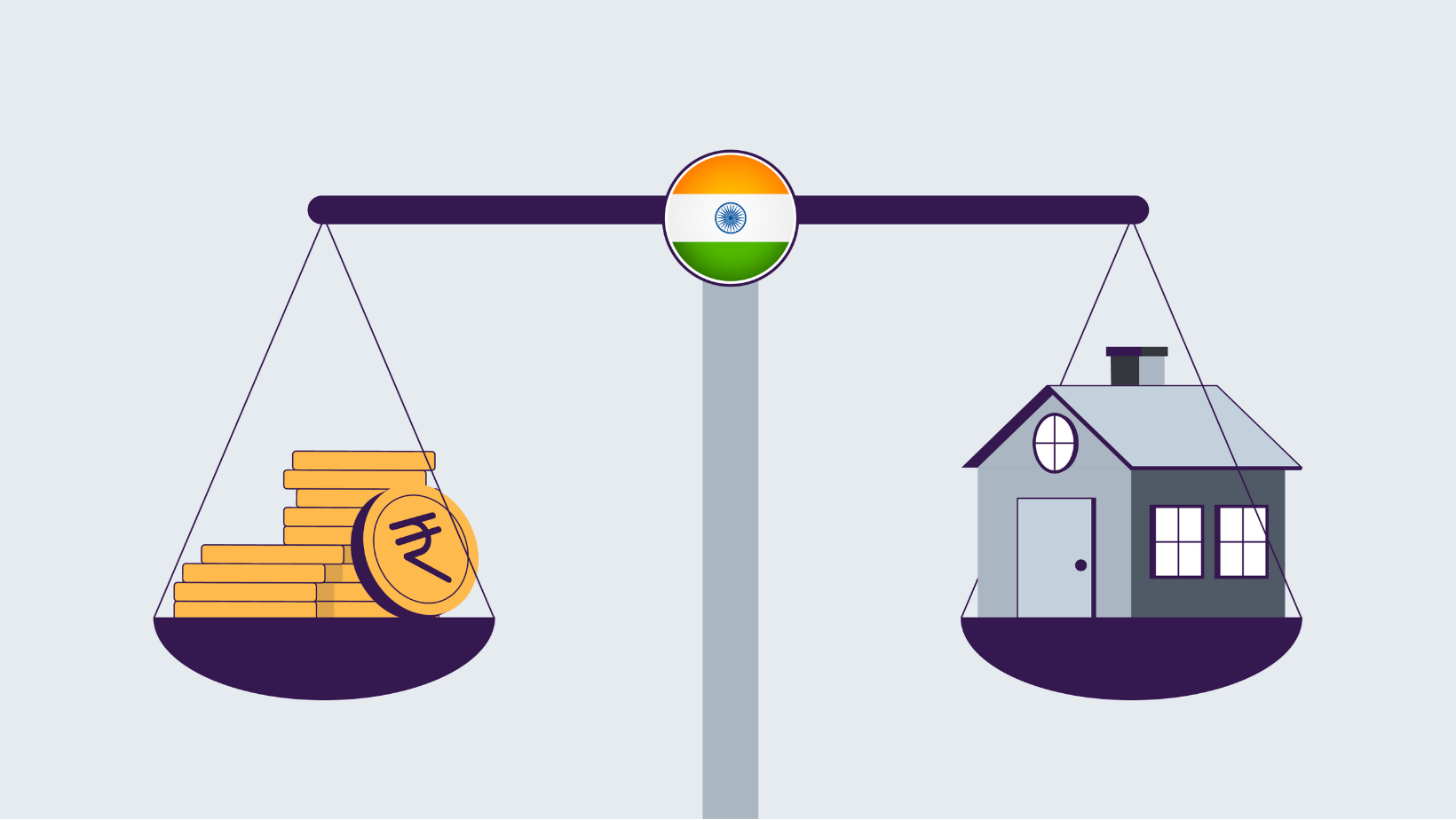
- 06 Apr 2024
Why is it in the News?
India is reportedly poised to replace the minimum wage with the living wage system, with the transition anticipated to occur by next year.
Context:
- India is reportedly considering shifting from the minimum wage to the living wage by 2025.
- India has approached the International Labour Organization (ILO) to help it chalk out a framework to assess and operationalize the living wages.
- India has asked the ILO to help it in “capacity building, systemic collection of data and evidence of the positive economic outcomes resulting from the implementation of living wages”.
- Earlier in March, the United Nations agency forged an agreement on the living wage, which was also endorsed by its governing body.
- India, a founding member of the ILO and a permanent member of its governing body since 1922, passed the Code on Wages in 2019.
What is the Current Wage System in India?
- National Floor Level Minimum Wage (NFLMW): Established under the Code on Wages 2019, the NFLMW is determined by the government, requiring establishments to set minimum wages not below this level.
- Flexibility in Minimum Wage Standards: Section 5 of the Code on Wages 2019 prohibits employers from setting wages below the NFLMW, though states have the discretion to revise minimum wage rates as needed.
- Presently, the National Floor Wage stands at Rs 178 per day.
What’s a Living Wage?
- The International Labour Organization (ILO) defines the living wage as the level of remuneration “necessary to afford a decent standard of living for workers and their families, taking into account the country's circumstances and calculated for the work performed during the normal hours of work”.
- This decent standard of living includes being able to afford food, water, housing, education, healthcare, transportation, clothing, and other basic needs including a provision for contingencies, says the Global Living Wage Coalition.
- The goal of a living wage is to ensure the employees get an income enough for satisfactory living standards as well as reduce poverty.
What is Minimum Wage?
- Minimum wage refers to the legally mandated lowest level of compensation that employers must pay employees for their work over a specified period.
- While minimum wage endeavors to prevent low pay, living wage extends beyond by ensuring income is adequate to meet necessities like food, shelter, clothing, and other essentials, addressing the risk of workers falling below the poverty line despite earning minimum wages.
- In India, minimum wage calculation factors in variables such as the state of employment, the skill level of the worker, the nature of their job, and other pertinent factors.
Living Wage vs Minimum Wage:
- Definition: A living wage is the income required to meet basic needs and maintain a decent standard of living, while minimum wage is the lowest legally mandated compensation for workers.
- Purpose: A living wage seeks to address the risk of workers falling below the poverty line, while minimum wage aims to prevent low pay.
- Mandatory vs Voluntary: Minimum wages are legally required, whereas living wages are voluntary unless the government sets the minimum wage at the living wage level.
- Calculation: Living wages consider basic necessities and a decent standard of living, while minimum wages factor in variables like skill level, state of employment, and job nature.
Pros and Cons of Living Wages:
- Living wage is a divisive issue. Proponents of the living wage say people get paid more, leading to a rise in employee satisfaction.
- A boost in employee morale is likely to result in higher productivity.
- It also saves recruitment and training costs for companies as employee turnover falls.
- On the other hand, critics of the concept say companies may cut back on hiring if forced to pay increased wages, creating more job losses.
- Opponents also argue that imposing a living wage means creating a wage floor, which would hurt the economy by impacting businesses, especially those that cannot pay hiked salaries.
How Does Living Wage Benefit India?
- India has over 500 million (50-crore) workers, of which 90 percent are in the unorganized sector, noted ET.
- The national floor level minimum wage (NFLMW) – an amount below which no state government can fix the minimum wage – was Rs 178 per day or more depending on the location in 2023.
- This was set at Rs 176 per day in 2017 and has not been changed since then.
- Currently, some states pay workers in the unorganized sector even below the NFLMW.
- The Code on Wages, 2019 was passed by Parliament states that the minimum wage cannot be fixed below the national wage floor.
- However, this code, which is binding on all states, is yet to be implemented.
- If India replaces the minimum wages with living wages, workers are expected to earn more.
- According to the ILO, the living wage has to be calculated following its principles and wage-setting process.
Conclusion
India's pursuit of the Sustainable Development Goals by 2030 hinges on strategic shifts, such as transitioning from minimum to living wages, to uplift millions from poverty while safeguarding their welfare. This is particularly pertinent against the backdrop of escalating income inequality, highlighting the imperative for a revamped wage system. As poverty rates decline yet inequality persists, a more equitable approach to wages becomes paramount, underscoring India's commitment to inclusive growth and social justice.
International Labor Organization (ILO):
- The International Labor Organization (ILO) is a specialized agency of the United Nations, founded in 1919 to promote social and economic justice through the establishment of international labor standards.
- The ILO operates with a unique tripartite structure, allowing governments, employers, and workers to engage in dialogue and decision-making on labor matters.
Key Roles and Functions:
- Setting International Standards: The ILO develops and adopts international labor standards in the form of conventions and recommendations, covering areas such as freedom of association, collective bargaining, child labor, forced labor, and non-discrimination.
- Technical Assistance and Capacity Building: The organization provides support to member states in enhancing their labor administration, labor inspection, employment policies, and social protection systems.
- Monitoring and Supervision: The ILO monitors the application of international labor standards in member states, offering guidance and assistance in their implementation.
- Research and Knowledge Sharing: The organization conducts research, collects data, and disseminates information on labor-related topics, facilitating evidence-based policy-making and dialogue.
- The ILO plays a critical role in promoting decent work, social justice, and labor rights worldwide, fostering cooperation among its 187 member states to address labor-related challenges and achieve sustainable development.
- The ILO headquarters are located in Geneva (Switzerland).
Understanding India’s Coal Imports
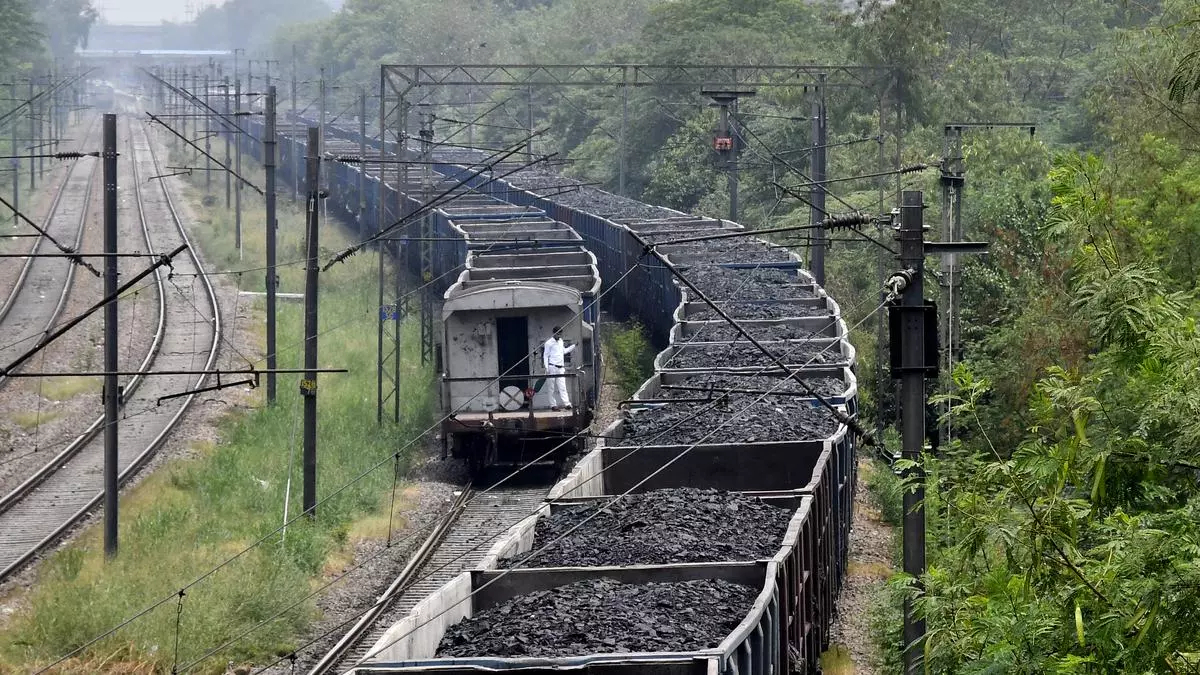
- 29 Mar 2024
Why is it in the News?
In recent years, the combination of unpredictable weather patterns and rapid economic growth has resulted in significant spikes in electricity demand, posing a challenge to reliably meet the escalating requirements.
Background:
- India has grappled with the looming threat of electricity shortages in recent years, particularly exacerbated by rising temperatures amplifying the power demand.
- While discussions on this matter typically revolve around the deficit in domestic thermal coal and the need for imports, a more thorough investigation uncovers intricate challenges concerning logistics and regulatory interpretation.
- Therefore, it is imperative to delve into these dimensions, shedding light on the complexities of the situation and seeking solutions to tackle the root causes.
What are the Primary Causes of Domestic Thermal Coal Shortages?
- Transportation Infrastructure Deficiencies: A critical challenge lies in the inadequacy of transportation infrastructure, notably the railway network, which predominantly facilitates coal transportation across India.
- Despite substantial coal production, the limited capacity of railways often hampers timely delivery to power plants, contributing to delays and inefficiencies in the coal supply chain.
- Geographical Disparities: Complicating matters, the distribution of coal mines and power plants across diverse regions adds another layer of complexity to logistics.
- Power plants situated far from coal mines encounter heightened logistical hurdles, facing difficulties in securing a consistent coal supply due to increased transportation time and costs.
- Storage and Handling Limitations: Insufficient storage and handling infrastructure at both mines and power plants exacerbate challenges in managing demand and supply fluctuations.
- Inadequate storage capacity can lead to stockpiling issues, exacerbating delays and hindering efficient coal delivery.
Balancing Alternative Domestic Sources and Imports:
- Exploration of Alternative Domestic Sources: While alternative coal sources, like auctions organized by Coal India Ltd., present a viable domestic option, they often receive less attention compared to imports.
- These auctions enable power plants to procure coal domestically, albeit potentially at higher prices, yet remain overlooked in favor of imported coal.
- However, auctions offer a feasible alternative, particularly for plants not hindered by logistical constraints in accessing coal from auction sites.
- Narrow Focus on Imports: The discourse tends to prioritize imports as the default solution for coal shortages, neglecting the potential of domestic alternatives and failing to consider the broader implications of heavy reliance on imported coal.
- Cost Implications: Importing coal entails additional costs, including transportation, handling, and import duties, resulting in higher variable costs for coal-based electricity.
- These expenses are often transferred to consumers through elevated electricity tariffs, burdening both households and industries.
- Regulatory Interpretation: Misinterpretation of Ministry of Power advisories recommending coal imports as mandates further blur the distinction between alternative sources and imports.
- While these advisories may propose importing a certain percentage of coal, they should not be perceived as obligatory requirements but rather as guidelines to be tailored to each power plant's unique circumstances.
- Less Emphasis on Domestic Procurement Enhancement: The emphasis on imports sidelines opportunities to improve domestic coal procurement and distribution processes.
- Addressing logistical hurdles and streamlining administrative procedures could enhance the efficiency and reliability of India's domestic coal supply chain, potentially reducing the reliance on costly imports.
Regulatory Frameworks Influencing Responses to Electricity Shortages and Coal Procurement Strategies:
- Clarifying Advisory Interpretations: An ongoing challenge in regulatory considerations involves clarifying interpretations of advisories from government entities like the Ministry of Power.
- While these advisories may offer recommendations for addressing coal shortages, particularly through import suggestions, they should not be misconstrued as mandates.
- Misinterpretation can lead to unnecessary costs and burdens on consumers, as power plants may feel compelled to comply with import recommendations, disregarding potentially viable domestic alternatives.
- Forward-Thinking Regulatory Decision-Making: Regulatory bodies overseeing electricity generation and distribution must adopt a forward-thinking approach to decision-making.
- This entails comprehensive assessments of regulatory measures' implications on stakeholders, including consumers, power producers, and distribution utilities.
- Analysis should weigh the costs and benefits of various coal procurement strategies, encompassing factors like transportation costs, import duties, and environmental impacts.
- Customized Approaches for Diverse Plant Settings: Recognizing the varied challenges among power plants regarding coal shortages, regulatory bodies should tailor measures to each plant's specific circumstances.
- Pit-head plants, closer to coal mines, may have easier access to domestic coal and encounter fewer logistical constraints compared to plants situated farther away, necessitating heavier reliance on imports.
- Regulatory interventions should thus be nuanced and adaptable rather than uniformly applied.
- Balancing Cost-Efficiency and Reliability: Regulators face the critical task of balancing cost and reliability in electricity supply.
- While imports may offer prompt solutions to coal shortages, they incur substantial costs affecting consumers.
- Therefore, regulators must meticulously evaluate the potential cost savings of domestic procurement against the reliability and security of imported coal supply, ensuring transparency and equity in decision-making.
- Long-Term Planning and Sustainability Integration: Regulatory considerations should encompass long-term planning and sustainability objectives alongside immediate coal shortage mitigation.
- While addressing immediate needs is crucial, regulators must also contemplate the broader ramifications of coal procurement strategies on energy security, environmental sustainability, and renewable energy transition.
- This necessitates a forward-looking approach aligning short-term actions with long-term sustainability objectives, facilitating India's transition to a resilient and sustainable energy framework.
Conclusion
Addressing electricity shortages in India necessitates a nuanced approach that considers both logistical hurdles and regulatory complexities. While importing coal may offer a temporary solution, it does not tackle the fundamental logistics inefficiencies. India can better navigate the challenges of power generation by addressing root causes and implementing tailored solutions, ensuring a more effective response to evolving weather patterns and increasing demand for electricity
WTO’s Investment Facilitation Negotiations Are Not Illegal
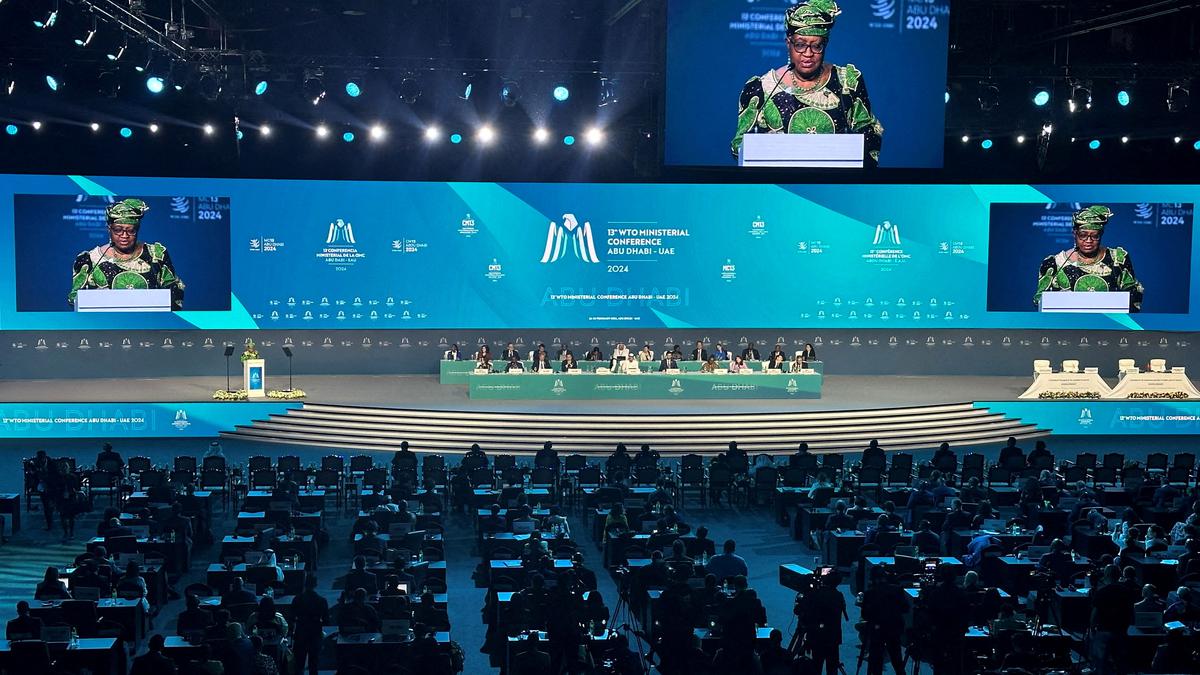
- 28 Mar 2024
Why is it in the News?
One significant event during the 13th Ministerial Conference (MC13) of the World Trade Organization (WTO) in Abu Dhabi was the inability to ratify the agreement concerning investment facilitation for development (IFD). Despite garnering backing from over 70% of the membership, approximately 120 member countries, the agreement remained unadopted.
Context:
- The recent 13th Ministerial Conference (MC13) of the World Trade Organisation (WTO) in Abu Dhabi unfolded a notable occurrence as the agreement on investment facilitation for development (IFD) failed to gain adoption.
- Despite substantial backing from approximately 120 member countries, the IFD Agreement encountered resistance, particularly from India and South Africa.
- In light of these events, it becomes imperative to delve into India's opposition to the IFD Agreement and its apprehensions regarding its alignment with WTO principles, especially concerning the intertwining of investment with trade and the procedural aspects of negotiation surrounding the agreement.
What is the IFD agreement?
- The Investment Facilitation for Development (IFD) Agreement is a legally binding framework that aims to enhance investment flows and promote transparency in regulatory processes.
- Finalized in November 2023, the agreement is the result of plurilateral negotiations initiated by 70 countries under the Joint Statement Initiative at the WTO in 2017.
- Despite initial opposition from some countries, including India, the IFD Agreement gained significant support, with 120 nations pushing for its inclusion as a plurilateral agreement within Annex 4 of the WTO Agreement.
- Although the WTO is primarily a multilateral trade organization, the allowance for plurilateral agreements under Article II.3 of the WTO Agreement sets the stage for binding commitments among participating WTO member countries.
Key objectives of the IFD Agreement include:
- Regulatory Transparency: Increasing openness in investment policies and procedures to instill confidence and predictability in the investment landscape.
- Streamlined Administrative Procedures: Simplifying investment-related processes and reducing red tape to attract and facilitate foreign investment inflows.
- By creating a stable and transparent environment for international investments, the IFD Agreement aims to contribute to economic growth and development, catalyzing cooperation among participating WTO members without imposing obligations on non-signatory countries.
What are India’s Concerns?
- India's resistance to the Investment Facilitation for Development (IFD) Agreement stems from concerns regarding its alignment with the WTO framework and the process undertaken to integrate it into the WTO rulebook.
- Given the WTO's dispute settlement mechanism, which solely permits state-to-state legal claims, incorporating Investor-State Dispute Settlement (ISDS) appears infeasible.
- This challenge contributed to India and South Africa's significant efforts to prevent the IFD Agreement from becoming an official component of WTO regulations.
India's primary apprehensions surrounding the IFD Agreement:
- Integrating Investment into the WTO: India questions the compatibility and relevance of investment policies within the WTO's scope, particularly when considering existing platforms dedicated to investment negotiations.
- Process-related Concerns: India argues that the procedure for incorporating the IFD Agreement into the WTO rulebook must be carefully scrutinized, ensuring adherence to established protocols and consensus-building among all member nations.
- While the actual content of the IFD Agreement does not appear to be India's primary concern, the nation's stance underscores the importance of considering the broader implications of such agreements within the global trade and investment landscape.
- As the international community navigates the complexities of investment facilitation and regulatory reform, the debate surrounding the IFD Agreement will continue to shape the future of multilateral cooperation and the evolution of the WTO's mandate.
Is Investment a Suitable Component of the WTO Framework?
- India posits that investment's integration into the World Trade Organization (WTO) may not inherently translate to increased cross-border trade, contrasting with scholarly perspectives emphasizing the interconnectedness of trade and investment.
- Citing the Organisation for Economic Co-operation and Development (OECD), it is highlighted that a substantial portion—70%—of international trade occurs within global value chains, underscoring the symbiotic relationship between trade and investment.
- Contemporary free trade agreements like the Regional Comprehensive Economic Partnership (RCEP) and the Comprehensive and Progressive Agreement for Trans-Pacific Partnership exemplify this integration, featuring comprehensive investment provisions encompassing facilitation and protection measures.
- Intriguingly, India's recent trade pact with the European Free Trade Association, despite including investment provisions focused on facilitation and promotion, underscores a pragmatic approach to incorporating investment elements, albeit with limitations.
Negotiating Process of the IFD Agreement:
- India has emphasized the absence of a negotiating mandate regarding investment discussions.
- India contends that the WTO's General Council's decision in 2004 ruled out talks on the nexus between trade and investment, a facet categorized under the 'Singapore issues' introduced during the 1996 WTO Singapore ministerial conference.
- These discussions were explicitly excluded from the Doha round of negotiations initiated in 2001.
- Additionally, India has pointed to the 2015 WTO Nairobi ministerial decision, which stipulates that launching negotiations on new issues multilaterally necessitates unanimous agreement among all member states.
- India argues that since consensus wasn't reached among all nations to commence negotiations on an IFD Agreement, the ensuing negotiations and the resultant text presented for adoption are deemed illegitimate.
Key Questions Surrounding the IFD Agreement:
- India's assertion of a negative mandate against initiating negotiations on the trade and investment relationship raises two critical queries warranting clarification.
- Firstly, does this negative mandate extend to all facets of investment, including facilitation?
- Notably, the shelved investment agreement proposed during the 1996 Singapore ministerial primarily addressed market access and investment protection, leaving ambiguity regarding whether the negative mandate encompasses all investment-related aspects within the WTO.
- Secondly, does the negative mandate solely pertain to launching negotiations on new issues in a multilateral context?
- The inquiry arises as to whether this prohibition extends to negotiations commenced on a plurilateral basis.
- The negotiations for an IFD agreement were instigated on a plurilateral, not multilateral, basis.
- Although Article X.9 of the WTO Agreement stipulates that adding an agreement to the existing set of Plurilateral Agreements listed in Annex 4 necessitates consensus exclusively, the agreement lacks provisions mandating consensus for initiating negotiations for a Plurilateral Agreement.
Way forward:
- As the primary regulatory body for international trade, the World Trade Organization (WTO) is responsible for updating existing rules and establishing new ones.
- However, reaching a consensus on decision-making within the WTO remains a significant challenge, often leading to legislative deadlock.
- In this context, Preferential Agreements (PAs), such as the proposed Investment Facilitation for Development (IFD) Agreement, can serve as catalysts for reinvigorating the WTO's legislative function.
- By fostering cooperation among subsets of WTO members, Preferential Agreements (PAs) can help circumvent the challenges of consensus-building within the broader organization.
- As India continues its ascent to become the world's third-largest economy, it is increasingly critical for the nation to reassess its defensive posture toward PAs.
- By recognizing the potential benefits of agreements like the IFD, India has the opportunity to demonstrate leadership on the global stage, support the revitalization of the WTO's legislative function, and contribute to a more collaborative and effective approach to international trade regulation.
Conclusion
The failure to ratify the IFD agreement at MC13 underscores the formidable challenges encountered by the WTO in navigating intricate matters such as investment facilitation. It underscores the divergent perspectives among member nations regarding the scope and nature of the WTO's role in governing global economic interactions. Closing these divergences becomes imperative for the WTO to adeptly address the evolving landscape of international trade and investment
Inter-Ministerial Joint Workshop on “Blue Economy”
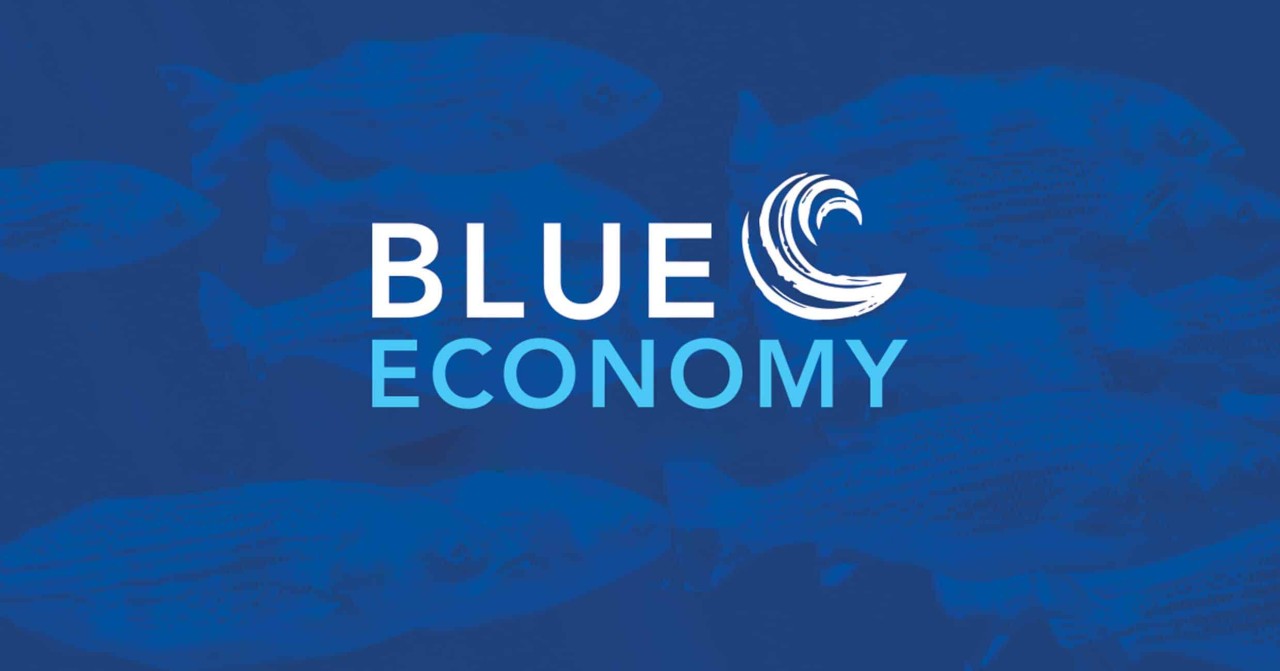
- 23 Mar 2024
Why is it in the News?
Recently, the Ministry of Earth Sciences (MoES) organized a consultative workshop in New Delhi today on the Blue Economy Pathways study report status.
Context:
- The Ministry of Earth Sciences (MoES) has collaborated with the World Bank to conduct a technical study and compile a report titled 'India’s Blue Economy: Pathways for resource-efficient, inclusive, and resilient growth in India.'
- This report aims to explore global best practices in Blue Economy implementation, develop an ocean accounting framework, enhance institutional capacity, and propose innovative finance mechanisms in alignment with India's Blue Economy Policy framework.
What is the Blue Economy?
- The blue economy, or the ocean economy, is a term used to describe the economic activities associated with the oceans and seas.
- The World Bank? defines the blue economy as the “sustainable use of ocean resources to benefit economies, livelihoods, and ocean ecosystem health”.
- The activities? commonly understood to represent the blue economy include maritime shipping, fishing and aquaculture, coastal tourism, renewable energy, water desalination, undersea cabling, seabed extractive industries and deep sea mining, marine genetic resources, and biotechnology.
- The blue economy is estimated to be worth more than US$1.5 trillion? per year globally.
- It provides over 30 million jobs and supplies a vital source of protein to over three billion people.
How do the Oceans Contribute to Sustainable Development?
- There is a Sustainable Development Goal (SDG) dedicated to oceans: number 14, ‘Life Below Water?’ aims to conserve and sustainably use the oceans, seas, and marine resources.
- It sets out seven targets for a sustainable ocean economy by 2030. So far, progress toward reaching these goals has been limited?.
- There have been some small improvements in the sustainability of fisheries and an expansion of Marine Protected Areas (MPAs), but these cover only around 7.5% of the oceans.
How are the Oceans Governed?
- Governance of the ocean and the blue economy is both complex and potentially difficult to implement, which has led to fragmented approaches to the sharing of marine resources between nations and impeded understanding of the environmental impacts of the blue economy.
- Ocean-related regulations apply to Exclusive Economic Zones (EEZs), which include territorial waters, archipelagos, and the area of sea that extends 200 nautical miles out from countries’ coastlines.
- The remaining area is called the High Seas? (or ‘open ocean’) and accounts for 64% of the world’s oceans.
Importance of the Blue Economy:
- Economic Prosperity: The Blue Economy offers substantial avenues for economic advancement across various sectors including fisheries, aquaculture, tourism, maritime transport, renewable energy, and biotechnology.
- Sustainable Resource Management: It advocates for the responsible and sustainable utilization of marine resources such as fish stocks, minerals, and energy sources, ensuring their availability for present and future generations.
- Renewable Energy Development: By fostering the exploration of renewable energy sources like offshore wind, wave, and tidal energy, the Blue Economy reduces reliance on fossil fuels, thereby combating climate change.
- Tourism Boost: Coastal and marine tourism serves as a cornerstone of the Blue Economy, stimulating revenue generation, and job creation, and bolstering local economies in coastal areas.
- Climate Change Mitigation: Healthy oceans play a pivotal role in regulating the planet's climate.
- Through conservation efforts and sustainable practices, the Blue Economy aids in mitigating climate change impacts by preserving coastal ecosystems and reducing carbon emissions.
- Biodiversity Protection: Through the promotion of sustainable practices and responsible resource management, the Blue Economy contributes to the conservation of marine biodiversity, safeguarding endangered species and habitats.
Challenges Facing the Blue Economy:
- Pollution and Environmental Degradation: India's coastal regions confront significant pollution stemming from industrial discharge, untreated sewage, agricultural runoff, and plastic waste.
- This pollution adversely impacts marine ecosystems, biodiversity, and the long-term sustainability of marine industries.
- Overexploitation of Marine Resources: Illegal, unreported, and unregulated (IUU) fishing practices exacerbate resource depletion, leading to diminished fish stocks and jeopardizing the livelihoods of coastal communities.
- Climate Change Impacts: The effects of climate change, such as rising sea levels, ocean acidification, and alterations in oceanic conditions, pose threats to fisheries, aquaculture, coastal infrastructure, and marine biodiversity.
- Maritime Security Challenges: India's maritime security faces multifaceted challenges including piracy, illegal trafficking, maritime terrorism, and territorial disputes, necessitating robust security measures.
- Limited Institutional Capacity and Infrastructure: Effective management and sustainable development of the blue economy require robust institutional frameworks, governance mechanisms, and infrastructure.
- However, India grapples with capacity constraints, inadequate funding, bureaucratic inefficiencies, and regulatory gaps, hindering optimal resource management and development.
India's Blue Economy:
- India's Blue Economy, encompassing its vast coastline and Exclusive Economic Zone (EEZ), holds immense potential for driving sustainable growth and development.
- With a coastline stretching 7,517 km and an EEZ covering over two million square kilometers, India is endowed with abundant living and non-living resources.
- Although currently contributing approximately 4% to the nation's GDP, India's Blue Economy is projected to experience significant expansion with improved mechanisms and infrastructure.
- Furthermore, the coastal economy plays a crucial role in sustaining the livelihoods of over four million fisherfolk and other coastal communities.
Four key industries are poised to propel India's Blue Economy forward:
- Fishing: Leveraging the rich marine resources to enhance fisheries production and promote sustainable fishing practices.
- Aquaculture: Developing innovative techniques to foster the cultivation of aquatic organisms, contributing to food security and livelihood opportunities.
- Ports: Investing in port infrastructure and capacity building to facilitate maritime trade, cargo handling, and logistics efficiency.
- Shipping: Strengthening the shipping industry to support global commerce, transportation, and connectivity while ensuring environmental sustainability
Government Initiatives Promoting Blue Economy:
- Sagarmala Programme: The Sagarmala Programme, a flagship initiative, focuses on modernizing India's ports, improving port connectivity, and driving port-led development.
- It prioritizes logistics optimization, coastal shipping promotion, and the establishment of coastal economic zones to stimulate economic expansion and employment generation.
- National Policy Framework: The government has devised a comprehensive National Policy Framework for the Blue Economy, outlining a strategic path for the sustainable development and management of marine resources.
- It aims to integrate sectors like fisheries, aquaculture, shipping, tourism, and renewable energy to foster holistic growth.
- National Marine Fisheries Action Plan (NMFAP): This plan encompasses strategies to enhance fishery resources assessment, upgrade infrastructure and technology in the fisheries sector, and encourage aquaculture development.
- Integrated Coastal Zone Management (ICZM): The government has initiated the Integrated Coastal Zone Management Program to foster sustainable development and conservation of coastal ecosystems.
- Blue Economy Cell: The Ministry of Earth Sciences has instituted a dedicated Blue Economy Cell to streamline research, policy formulation, and implementation of Blue Economy endeavors.
- Marine Spatial Planning (MSP): India is actively developing Marine Spatial Planning frameworks to ensure the efficient and sustainable utilization of marine space.
Conclusion
India's Blue Economy is on the brink of substantial expansion in the coming years.
With the government's proactive Blue Economy Mission, there's potential for this sector to emerge as a key economic driver, contingent upon effective policy implementation.
Aligned with the government's broader vision outlined in the 'Vision of New India by 2030', the Blue Economy policies are geared towards securing enduring economic benefits, fostering job creation, promoting equity, and safeguarding environmental sustainability.
Addressing the Persistent Issue of Gender Pay Disparity

- 20 Mar 2024
Why is it in the News?
A recent World Bank Group report highlighted that women globally earn only 77 cents for every dollar earned by men, underscoring the persistent gender pay gap where women, on average, earn less than men.
Context:
- The World Bank Group's recent report sheds light on the persistent issue of the gender pay gap, revealing that women globally earn only 77 cents for every dollar their male counterparts earn.
- This disparity has been a contention, with critics sometimes questioning its existence.
- However, the International Labour Organisation regards the gender pay gap as a tangible indicator of inequality between men and women.
- While various reports present different figures, it is crucial to acknowledge the underlying factors that contribute to this gap and work towards eradicating them to achieve equitable pay for all individuals, regardless of gender.
How is the Gender Pay Gap Calculated?
- The International Labour Organization (ILO) defines the gender pay gap as the difference between the average wage levels of all working women and men in the labor market, whether they are paid a monthly salary, hourly wage, or daily wage.
- It is crucial to note that this gap does not exclusively represent the wage disparity between men and women with similar qualifications and job responsibilities.
- Rather, it encompasses the overall earnings difference between all working women and men.
- While the concept of "equal pay for equal work" advocates for equitable compensation for men and women with the same qualifications and job duties, the gender pay gap reflects broader income disparities.
- There is no single, universally agreed-upon method for calculating the gender pay gap.
- Different organizations and studies may produce varying figures due to their distinct approaches.
- Understanding the various factors contributing to the gender pay gap and addressing them through appropriate policies and initiatives is vital for achieving gender equality in the workforce and ensuring fair compensation for all workers.
Methodological Differences and the Persistence of the Gender Pay Gap:
- The variation in reported gender pay gaps can be attributed to the distinct methodologies employed by different organizations and studies.
- For instance, Pew Research used hourly wages to calculate the disparity. At the same time, the US Bureau of Labor Statistics utilized weekly wages, considering only full-time workers, defined as those working at least 35 hours per week.
- Such differences in approach can lead to varying estimates of the gender pay gap.
- Despite these discrepancies in methodology, it is essential to recognize that the gender pay gap is a persistent issue in most countries and industries.
- While the extent of the gap may differ across studies, the underlying reality is that income disparities between men and women continue to be a prevalent challenge.
What are the Root Causes of the Gender Pay Disparity?
- The gender pay gap can be attributed to several interconnected factors that perpetuate income inequality between men and women.
- Firstly, women's lower labor force participation rate is influenced by prevailing gender stereotypes and societal expectations about gender roles.
- The International Labour Organization (ILO) reveals that the global labor force participation rate for women stands at just under 47%, compared to 72% for men.
- In India, the 2011 Census reported a workforce participation rate of 25.51% for women, against 53.26% for men.
- Secondly, even when women join the workforce, they are often concentrated in lower-paying sectors or job roles.
- The ILO's Women in Business and Management report found that fewer women occupy management and leadership positions, particularly at higher levels.
- They are more likely to work in support functions such as human resources and financial administration, leading to a lower average salary compared to male managers.
- A Georgetown University survey in 2013 further highlighted that the top 10 highest-paying professions, primarily in engineering and computer science, were dominated by men, while women were overrepresented in the 10 lowest-paying professions, such as arts and education.
- Additionally, women are more likely to work part-time due to limited full-time employment opportunities and family responsibilities.
- In 73 countries, based on 2018 data, women outnumbered men as part-time workers.
- The ILO explains that part-time work often lacks proportional benefits to full-time positions, impacting women's overall remuneration over time.
- Other institutional and socioeconomic factors, such as the traditional view of men as breadwinners, lower investments in women's education, and concerns over safety in commuting and the workplace, also contribute to the gender pay gap.
- Addressing these underlying issues and promoting gender equity in the workforce is essential to bridging the gender pay gap and achieving fair compensation for all individuals.
Understanding the Implications of the Gender Pay Gap:
- Analyzing the gender pay gap through various demographic factors reveals patterns that provide valuable insights into income disparities between men and women.
- For example, women in their mid-30s and 40s often experience a decline in earnings compared to men in similar positions and professions.
- Critiques of the 77% statistic argue that it overlooks the "motherhood penalty," where unmarried women earn 95 cents or more for every dollar a man makes.
- This penalty suggests that women face career growth setbacks when they take breaks to raise children, highlighting an area requiring attention to promote equal opportunities.
- The 2023 Sveriges Riksbank Prize in Economic Sciences winner, Claudia Goldin, extensively researched pay equality and argued that traditional gender roles force men to "step up" in their careers while women "step back" for family responsibilities.
- This dynamic ultimately disadvantages both genders, as men miss out on family time, and women sacrifice their careers.
- Efforts to close the gender pay gap, such as implementing maternity and paternity leave policies and flexible work arrangements, have shown promise in reducing income disparities.
- However, the pace of progress varies, emphasizing the need for continued attention and innovation in promoting equal opportunities for all workers.
Conclusion
The gender pay gap continues to pose significant challenges across nations and industries. Examining demographics and career stages reveals important patterns that underline disparities between men's and women's earnings. Addressing inequalities, such as the "motherhood penalty," and transforming traditional work structures are vital for achieving equal opportunities. While policies like parental leave and flexible work arrangements have shown promise, sustained commitment to innovation and reform is crucial for fostering lasting progress and a more equitable professional environment.
The Role of NFHS Data in Formulating Policies for Women's Financial Inclusion
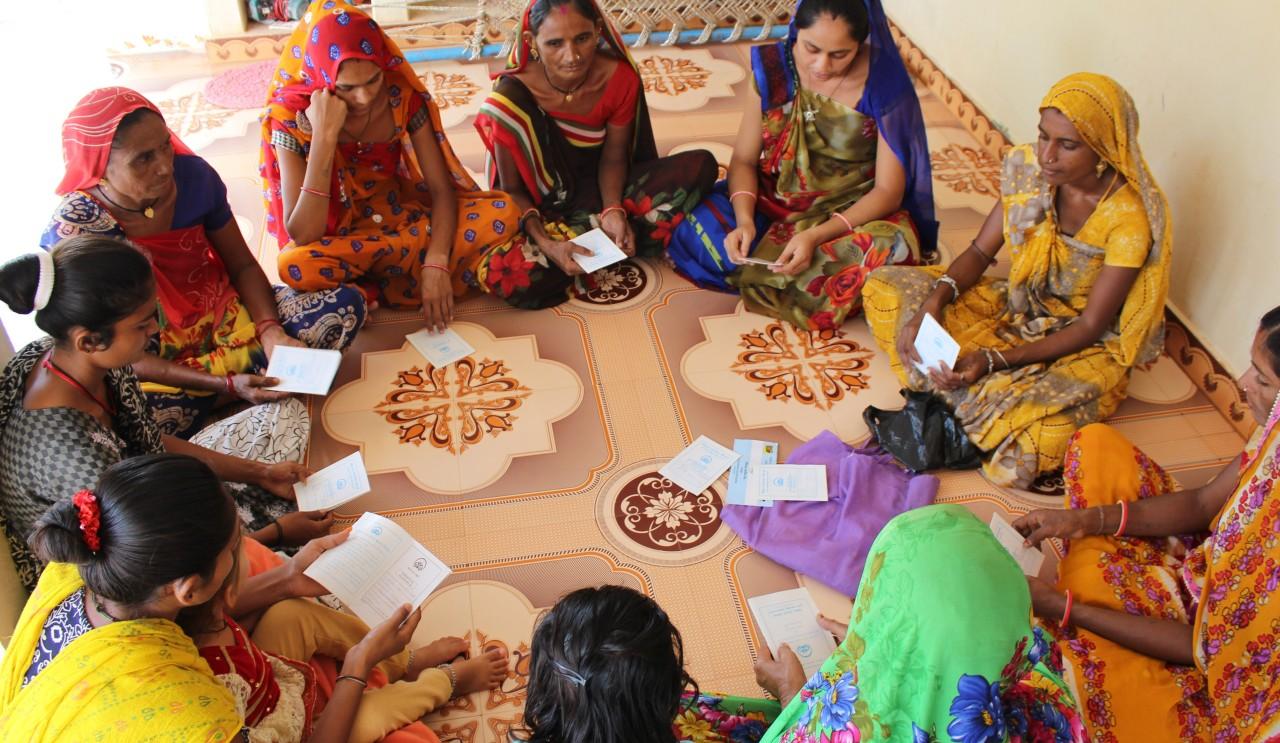
- 19 Mar 2024
Why is it in the News?
Financial inclusion awareness programmes must give special attention to women in households not headed by women.
Context:
- Financial inclusion is a key driver for realizing a more sustainable and inclusive future, as it directly influences the achievement of eight out of the 17 United Nations' Sustainable Development Goals (SDGs).
- Despite its importance, inequalities continue to exist, with India's subpar performance in the Global Gender Gap Report 2023 underscoring significant gaps in the economic realm.
- To address these disparities, particularly for women in India, it is vital to conduct a comprehensive evaluation of the complex aspects of financial inclusion.
- Insights can be drawn from multiple sources such as the World Bank's Global Findex Database and the National Family Health Survey (NFHS), ultimately paving the way for targeted interventions and improved financial access for all.
What is Financial Inclusion?
- Financial inclusion is a method of offering banking and financial services to individuals.
- It aims to include everybody in society by giving them basic financial services regardless of their income or savings.
- It focuses on providing financial solutions to the economically underprivileged.
- The term is broadly used to describe the provision of savings and loan services to the poor in an inexpensive and easy-to-use form.
- It aims to ensure that the poor and marginalized make the best use of their money and attain financial education.
- With advances in financial technology and digital transactions, more and more startups are now making financial inclusion simpler to achieve.
The Role of Financial Inclusion in Advancing Women's Empowerment:
- Financial inclusion not only facilitates women's access to bank accounts but also drives broader economic participation and empowerment.
- By offering women avenues for savings, credit, and investment, financial inclusion empowers them to manage risks, build assets, and seize socio-economic opportunities.
- In doing so, it bolsters women's resilience to economic uncertainties, fosters greater household welfare, and promotes economic stability, thereby illustrating its pivotal role in driving gender equity and sustainable development.
Insights from NFHS Data on Women's Financial Inclusion Progress:
- The NFHS data offers a comprehensive understanding of the multi-faceted dimensions of financial inclusion among women in India.
- Over the past two decades, several indicators point towards a significant improvement in women's economic empowerment and access to financial services including:
Financial Autonomy and Decision-making:
- A notable aspect highlighted by the NFHS surveys is the increasing financial autonomy among women.
- There has been a marked shift towards greater control over financial resources, with more women possessing self-operated bank accounts and playing an active role in financial decision-making within their households.
- This trend signifies a positive step towards women's economic independence, contributing to their overall empowerment and well-being.
Awareness and Utilization of Micro-Credit Programs:
- Micro-credit schemes have emerged as a key facilitator of financial assistance for women entrepreneurs and small business owners in rural India.
- The NFHS data indicates a growing awareness of these programs among women, with an increasing number utilizing micro-credit facilities to support their economic activities.
- This underscores the importance of targeted interventions and support mechanisms in promoting women's access to formal credit sources, fostering entrepreneurship, and generating income at the grassroots level.
Access and Utilization of Formal Banking Services:
- An analysis of factors such as education, occupation, and household characteristics reveals key determinants of women's financial inclusion.
- The NFHS data emphasizes the pivotal role of education in enabling women's awareness and utilization of financial services.
- Similarly, occupation and access to electronic media also significantly influence women's access to formal banking channels and digital financial tools.
- These insights underscore the need for targeted interventions and policy measures to address disparities and barriers, ensuring inclusive financial access, particularly among marginalized and vulnerable groups of women.
Advances in Global Financial Inclusion and India:
- Financial inclusion has become a key enabler of economic growth and development worldwide, with India demonstrating substantial progress in this arena.
- According to the World Bank's Global Findex Database, there has been a significant increase in adult ownership of bank accounts globally between 2011 and 2020.
- India's commendable growth of 42 percentage points during this period exemplifies the success of targeted interventions promoting financial access, particularly for marginalized communities such as women.
- This upward trend emphasizes the importance of continued efforts in fostering inclusive financial systems to ensure sustainable development and shared prosperity.
The Influence of Government Initiatives on Financial Inclusion:
- India's commitment to advancing financial inclusion has resulted in substantial progress, particularly in reducing the gender gap in account ownership.
- The introduction of the Pradhan Mantri Jan Dhan Yojana (PMJDY) in 2014 played a pivotal role in this achievement, offering universal access to banking services, including savings accounts, remittances, and overdrafts to underserved communities such as women in rural and urban areas.
- By January 2024, PMJDY had facilitated the opening over 28 crore accounts for women, significantly contributing to bridging the gender gap in financial access.
- Furthermore, government initiatives like the Deendayal Antyodaya Yojana and the National Rural Livelihood Mission (DAY-NRLM) have been instrumental in fostering women's economic empowerment and participation in the formal financial sector.
- These schemes provide opportunities for skill development, entrepreneurship training, and access to credit, enabling women to establish and sustain livelihoods.
- In addition, social protection programs such as the Pradhan Mantri Awas Yojana and Pradhan Mantri Matru Vandana Yojana offer financial assistance and support during critical life stages such as pregnancy and homeownership.
- Collectively, these initiatives have played a vital role in promoting women's economic independence and overall well-being, underscoring the importance of continued efforts towards inclusive financial systems.
Challenges and Way Forward:
- While significant progress has been made in advancing financial inclusion, several challenges remain, requiring concerted efforts and multi-stakeholder collaboration to address. Key areas of focus include:
- Enhancing Financial Literacy: Despite the expansion of banking services, a significant proportion of the population, particularly in rural and marginalized communities, lack adequate knowledge and understanding of financial products and services.
- By promoting targeted education and awareness campaigns, we can empower individuals to make informed financial decisions and fully utilize available resources.
- Bridging the Digital Divide: The potential of digital financial services to enhance access and convenience is immense.
- However, disparities in internet connectivity, smartphone ownership, and digital literacy create barriers to their effectiveness.
- Expanding digital infrastructure and promoting digital literacy initiatives are critical to ensuring equitable access to digital financial services for all segments of society.
- Promoting Inclusivity of Marginalized Communities: Systemic barriers continue to hinder the meaningful participation of marginalized communities, including women, minorities, and persons with disabilities in the financial ecosystem.
- These barriers are multifaceted, encompassing social, cultural, and economic factors.
- To overcome these challenges, tailored interventions and affirmative action programs are necessary, fostering an enabling environment that promotes their inclusion and empowerment.
- Advancing through Collaboration: A collaborative approach involving multiple stakeholders, including government agencies, financial institutions, civil society organizations, and grassroots initiatives, is indispensable in advancing financial inclusion.
- By coordinating efforts, leveraging resources, and implementing holistic solutions, we can collectively navigate the path ahead, overcoming challenges, and ensuring inclusive and sustainable financial systems for all.
Conclusion
Advancing financial inclusion for women in India is essential for fostering inclusive growth and sustainable development. While initiatives like PMJDY and DAY-NRLM have made significant strides, concerted action is necessary to tackle remaining disparities and fully leverage women's economic potential. By emphasizing education, digital literacy, and tailored awareness initiatives, India can unlock fresh opportunities for women's economic empowerment, thereby advancing the agenda of inclusive growth and prosperity.
Green jobs and the problem of gender disparity
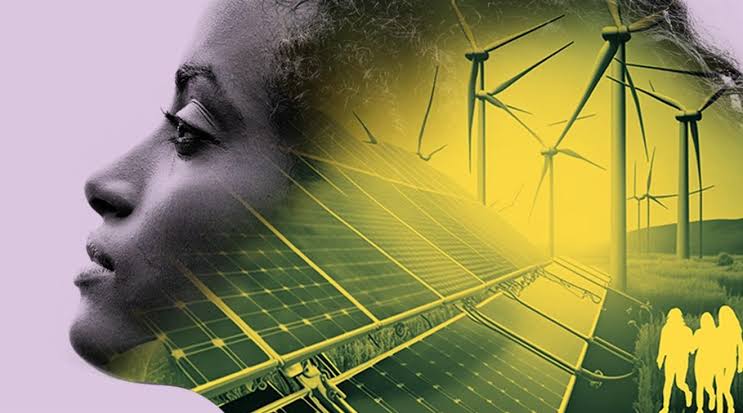
- 06 Mar 2024
Why is it in the News?
Increasing women’s representation in green jobs will lead to benefits such as boosting a low-carbon and environmentally sustainable economy
Context:
- The worldwide movement towards low-carbon development presents India with a distinctive opportunity for progress.
- Nevertheless, this transition brings forth a gender disparity challenge, as men tend to transition to green jobs more rapidly than women.
- Hence, it's crucial to delve into the gender aspects of India's green transition, highlighting the imperative for women's empowerment and gender equality in climate initiatives.
What are Green Jobs?
- Green jobs represent a category of employment directly benefiting the planet and contributing to overall environmental well-being.
- These roles are geared towards mitigating the negative environmental impact of various economic sectors and advancing the creation of a low-carbon economy.
- Occupations involving renewable energy, resource conservation, and the promotion of energy-efficient practices fall under this umbrella.
- The International Labour Organization characterizes green jobs as 'decent jobs that contribute to the preservation or restoration of the environment.'
- They encompass diverse sectors such as manufacturing, construction, renewable energy, energy efficiency, and automobiles, historically characterized by lower female representation.
Gender Disparity in Green Jobs:
- Globally, men tend to transition to green jobs at a faster pace than women.
- Despite India's significant increase in renewable energy capacity by 250% between 2015 and 2021, women constitute only 11% of workers in the solar rooftop sector.
- The Annual Survey of Industries 2019-20 reveals that women workers are predominantly concentrated in industries like apparel, textile, leather, food, and tobacco.
- According to a Confederation of Indian Industry (CII) 2019 report, men make up 85% of the workforce in sectors such as infrastructure, transport, construction, and manufacturing.
- A 2023 study by the Skill Council for Green Jobs indicated that 85% of green skills training was provided to men, with over 90% of women expressing belief that social norms hinder their participation in such training.
- Restrictive social norms contributing to this disparity include perceptions that women are unsuitable for certain technical roles, safety concerns, lower representation in science, technology, engineering, and mathematics (STEM) subjects, and familial constraints.
Advantages of Women's Engagement in Green Jobs:
- Addressing Gender Bias in the Labour Market: Increased representation of women in green jobs acts as a potent remedy to entrenched gender biases in the labor market.
- By entering traditionally male-dominated sectors like manufacturing, construction, and renewable energy, women challenge stereotypes and reshape societal perceptions of gender roles.
- Expanded Economic Opportunities: Women's greater involvement in green jobs opens up expanded economic avenues for them.
- Participation in sectors such as renewable energy and energy efficiency enables women to access high-growth industries, fostering both economic growth and personal financial stability.
- Beyond economic benefits, engagement in green jobs offers opportunities for women's advancement in technical and social spheres, exposing them to innovative technologies, sustainable practices, and networking opportunities.
- Empowerment of Women's Agency: The transition to green jobs empowers women by granting them agency over their economic destinies.
- In roles contributing to environmental preservation or restoration, women find alignment with a broader sense of purpose, fostering a deeper connection to their work and its societal impact.
- Contribution to Long-Term Gender Empowerment: Participation in green jobs extends beyond immediate economic gains, contributing to the enduring empowerment of women.
- By breaking into historically imbalanced sectors, women pave the way for future generations, inspiring young girls to pursue careers in STEM fields.
- Promotion of Environmental Stewardship: Women's involvement in green jobs resonates with their recognized role as custodians of the environment.
- With a nuanced understanding of the interconnectedness of social and ecological systems, women offer unique perspectives to the development and implementation of sustainable practices within green industries.
Way Forward:
- Addressing Data Gaps: Rectifying the lack of data is imperative to understand the landscape of women's participation in green jobs in India.
- Initiatives should focus on mapping emerging areas for green growth and collecting sex-disaggregated data on green jobs to enhance women's engagement.
- Conducting gender analysis, gathering gender statistics through periodic labor force surveys, and mobilizing additional resources can shed light on the present and future impact of low-carbon transitions on women workers and entrepreneurs.
- Supporting Women Entrepreneurs: Gender-targeted financial policies and products tailored to the needs of women entrepreneurs can catalyze their entry into the green transition market.
- Measures such as collateral-free lending, financial literacy training, and establishing supportive networks are crucial to unlock their potential.
- Developing appropriate tools to assess creditworthiness, facilitate loan disbursement, and reduce operational costs for women-owned businesses is essential.
- Promoting a Gender-Just Transition: A comprehensive strategy for a gender-just transition encompasses employment, social protection, reduction of care work burden, and skill development.
- Collaboration among government, private sectors, and stakeholders is essential to harness innovation, technology, and finance for women entrepreneurs and workers.
- Businesses must prioritize gender justice to mitigate barriers and promote equitable job opportunities for a fair transition.
Conclusion
As India navigates its green transition, prioritizing women's empowerment and gender equity in climate actions is essential for unlocking the co-benefits of a low-carbon and environmentally sustainable economy. Bridging the gender gap in green jobs requires concerted efforts to address social norms, collect gender-disaggregated data, and implement inclusive policies. This is not only an economic imperative but a crucial step towards building a socially equitable and inclusive future for all.
India's Surprising GDP Growth Rate

- 02 Mar 2024
Why is it in the News?
India's gross domestic product (GDP) growth for the third quarter (October-December) of the fiscal year 2023-24 has surpassed expectations, coming in at 8.4% compared to the estimated 6.7%.
News Summary:
- India's economy saw a growth of 8.4% in the December quarter compared to the same period last year, surpassing the 7.6% growth recorded in the previous quarter and the forecast of 6.7% as per a Reuters poll of economists.
- Further, the NSO pegged a higher GDP growth rate of 7.6% for the entire fiscal year, up from the initial estimate of 7.3%.
- To comprehend India’s unexpected growth, it is imperative to delve into the diverse aspects of the country's economic landscape, and evaluating the factors underpinning this surprising growth is equally crucial, including consumption patterns, savings dynamics, and investment trends.
What are the Factors Driving India’s Growth Surplus?
- Enhanced Economic Momentum: Initially estimated at 7.3 percent, the GDP growth set a promising tone for the fiscal year.
- However, the subsequent second advance estimate, incorporating third-quarter data, surpassed expectations.
- This signals a bolstered economic momentum, notably fueled by increased net taxes contributing significantly to the growth trajectory.
- Impact of Rising Net Taxes and Subsidies: An essential aspect of this growth narrative is the comparison between gross value added (GVA) and GDP growth.
- While GDP growth stands impressively at 7.6 percent, GVA, excluding net tax effects, registers a slightly lower 6.9 percent.
- This nuanced distinction underscores the influence of net taxes and subsidies on overall economic performance.
- Furthermore, with an average growth rate of 8.2 percent for the first three quarters, extrapolations suggest a projected fourth-quarter growth of approximately 5.9 percent.
- Effective Policy Measures and Financial Resilience: Despite GDP figures still below pre-pandemic levels, concerted domestic efforts and policy initiatives have steered the economy toward a 7 percent growth trajectory.
- A significant factor contributing to this progress is the reinforced state of banking and corporate balance sheets, indicative of the efficacy of strategic policy interventions.
Assessment of Challenges and Expected Downturn:
- Impact of High-Interest Rates: The enduring prevalence of high interest rates presents a formidable obstacle to sustained economic advancement.
- Elevated interest rates have the potential to deter borrowing and investment, thereby affecting both consumer expenditure and corporate expansion initiatives.
- This concern is further compounded by the limited effectiveness of monetary policy, given that inflation projections persist above the Reserve Bank of India's (RBI) 4% target.
- Normalisation of Net Tax Effects: The current fiscal period has significantly contributed to GDP growth from the escalation of net taxes (taxes minus subsidies).
- However, there is an anticipation that the net tax influence on GDP will revert to normal levels in the upcoming year.
- This normalization implies that the impetus provided by the net tax element to the economic growth rate may diminish, potentially leading to a slowdown.
- Influence of Global Economic Conditions: India's economic performance is intricately intertwined with global economic circumstances.
- Uncertainties prevailing in the global market, such as trade tensions, geopolitical dynamics, and external disruptions, could trigger spill-over ramifications on India's economy.
- Consequently, external factors beyond the nation's jurisdiction may exert influence on the overall economic outlook.
Private Consumption, Household Savings, and Evolving Trends:
- Disparities in Growth: The growth disparity between rural and urban areas is notable, with rural consumption likely trailing urban consumption.
- This discrepancy can be attributed primarily to the disproportionate impact of high food inflation on rural households.
- The sluggish growth of agriculture, at a mere 0.7%, underscores the challenges faced by the rural economy, where food inflation significantly affects discretionary spending.
- Impact of Food Inflation: High food inflation has exerted a considerable influence on consumption patterns, particularly in rural regions.
- Nominal food consumption spending surged by 13% last year, indicative of the inflationary pressure on essential commodities.
- This trend is expected to persist, impacting purchasing power and discretionary spending across both rural and urban landscapes.
- Shifting Consumption Patterns: Household consumption expenditure data reflects a gradual shift towards non-food items over time, mirroring rising per capita income and evolving consumer preferences.
- This transition underscores the necessity to recalibrate weights in the consumer price index basket, which currently reflects consumption patterns from 2011-12.
- Household Savings: Disaggregated data reveals that household savings constitute a substantial portion, comprising 61% of total savings in the economy.
- Despite its prominence, the share of household savings in GDP declined to 18.4% in 2022-23, indicating changing trends in savings composition.
- Household savings are further categorized into financial and physical savings, with financial savings, including bank deposits and securities, witnessing a significant decline to 5.3% of GDP in 2022-23.
- Conversely, physical savings, driven by borrowings for assets like houses, have increased, reflecting evolving preferences and market dynamics.
Analysis of Investment Trends: Public, Corporate, and Household:
- Private Corporate Investment Patterns: The data indicates a stagnant trajectory in private corporate investments, with no clear signs of revival evident in the fiscal year 2022-23.
- This stagnation raises concerns, as private sector investments play a pivotal role in propelling economic growth, fostering job creation, and stimulating innovation.
- Public and Household Investment Dynamics: In contrast to private corporate investments, both public and household investments have exhibited substantial growth during the fiscal year 2022-23.
- Public investments, often influenced by government policies and infrastructure projects, contribute significantly to economic development.
- On the other hand, household investments, encompassing expenditures on residences and durable goods, serve as indicators of consumer confidence and economic stability.
Way Forward:
- Mitigating Policy Uncertainty: The government must mitigate policy uncertainty and streamline compliance costs.
- A stable and foreseeable policy landscape is indispensable for fostering private-sector investments.
- Addressing these concerns is paramount to cultivating an environment conducive to long-term corporate strategizing and sustained economic expansion.
- Encouraging a Comprehensive Revival of Private Investments: Recognizing the pivotal role of a comprehensive revival of private investments in sustaining high growth rates over the medium term is imperative for the government.
- While the government's emphasis on infrastructure development and targeted initiatives like the Production-Linked Incentive (PLI) scheme has yielded positive outcomes, a more holistic approach is warranted to invigorate investments across diverse sectors of the economy.
Conclusion
India's unexpected GDP growth, underpinned by resilient domestic fundamentals and strategic policy emphasis, necessitates a nuanced examination of various economic facets. As India traverses through these multifaceted dimensions, focused attention on private corporate investments, consumption trends, and savings dynamics emerges as pivotal for achieving sustained and inclusive economic progress. Furthermore, the government's role in ensuring policy stability and minimizing compliance burdens emerges as a decisive factor in unlocking the full potential of India's economic prowess.
Paradigm Shift: Unleashing Local Wisdom for Sustainable Economic Growth
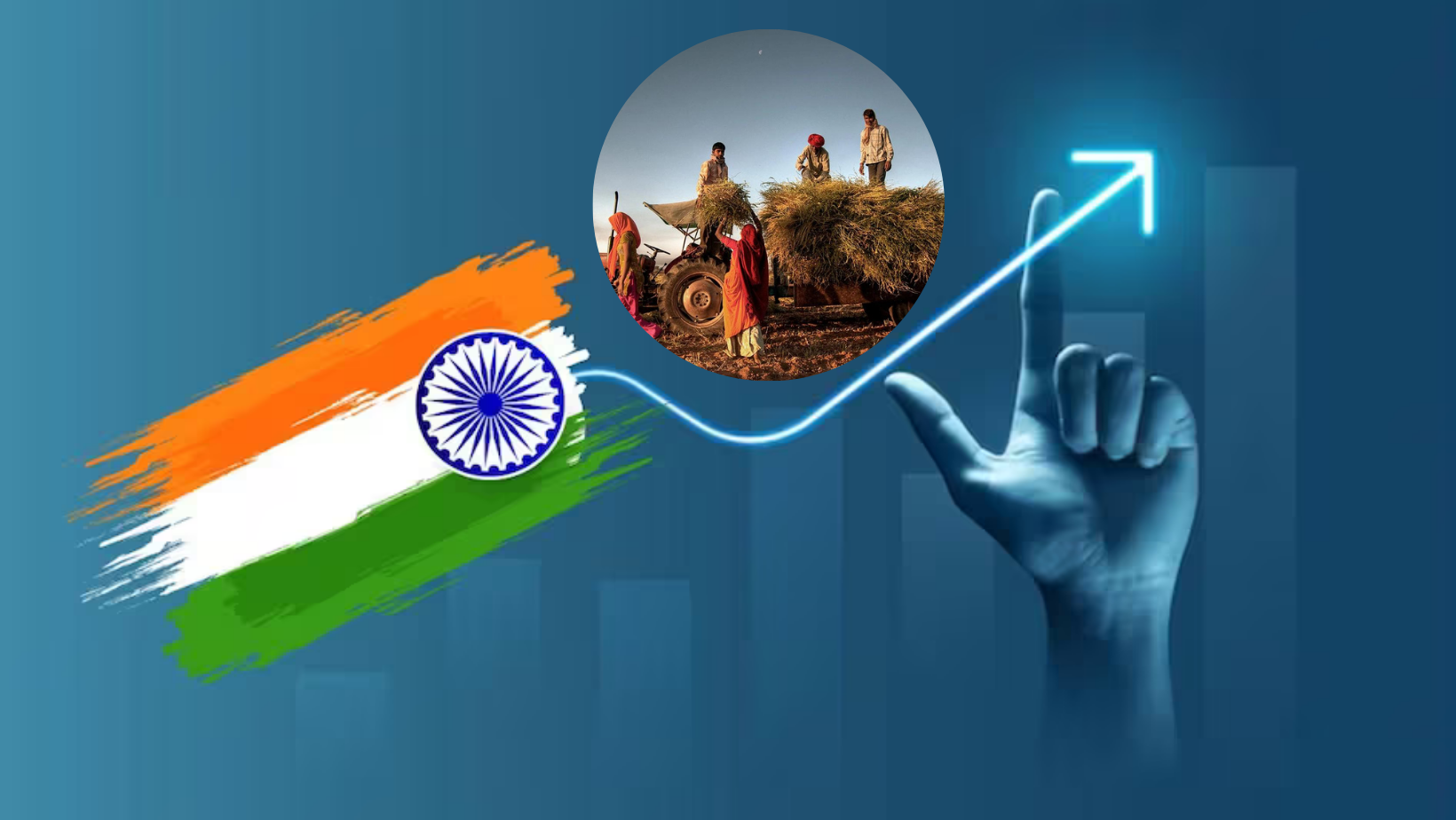
- 24 Feb 2024
Why is it in the News?
India’s policymakers must free themselves from Western-dominated theories of economics and in this, local solutions are the way to solve global systemic problems.
What is Economic Growth?
- Economic growth denotes the expansion of a nation's economy over a defined duration.
- This expansion is commonly quantified by the aggregate output of goods and services within the economy, known as gross domestic product (GDP).
Key Points:
- GDP Measurement: Gross domestic product serves as the primary metric for assessing economic growth, reflecting the overall economic activity within a nation.
- GDP represents the total monetary value of all finalized goods and services generated within a country's borders during a specified timeframe.
- Definition of Economic Growth: Economic growth signifies the sustained increase in a country's real national income and per capita income over an extended period.
- This progression indicates an expansion in the nation's economic output and its citizens' earning potential.
- Long-term Perspective: Economic growth is characterized by its longitudinal nature, emphasizing continuous advancement in a nation's economic prosperity over time.
- It underscores the importance of sustained increases in productivity, income levels, and overall economic well-being.
Current Economic Analysis:
- GDP as a Benchmark: Gross Domestic Product (GDP) growth has emerged as the predominant yardstick for evaluating the overall well-being of economies worldwide.
- It serves as a comprehensive measure of a nation's economic output, encompassing the total value of goods and services produced within its borders over a specific period.
- Paradigm Shift: There has been a notable shift in economic ideology, prioritizing the expansion of the economic "pie" before addressing issues of income distribution.
- This paradigmatic change has supplanted previous socialist models that emphasized addressing socio-economic disparities at the grassroots level.
- Historical Economic Focus: Since the liberalization of India's economy in 1991, successive governments have placed considerable emphasis on fostering GDP growth as a primary driver of economic development.
- This policy orientation has underscored the significance of achieving robust GDP expansion as a cornerstone of national economic policy.
- Projected Growth Trajectory: The First Advance Estimates of National Income for the fiscal year 2023-24 indicate a projected Real GDP growth rate of 7.3 percent for India.
- This forecast, as outlined in the Macro-Economic Framework Statement 2024-25, reflects the anticipated trajectory of India's economic growth in the near term.
- Global Economic Projections: According to the International Monetary Fund (IMF), India is poised to ascend to the rank of the third-largest economy globally by 2027, measured in terms of market exchange rate.
- Additionally, the IMF anticipates a substantial increase of 200 basis points in India's contribution to global economic growth over the next five years.
Addressing Challenges and Considerations:
- Beyond GDP: Limitations in Assessing Well-being: Gross Domestic Product (GDP) fails to comprehensively measure a nation's overall standard of living or well-being.
- It overlooks critical aspects that contribute to general welfare, such as environmental sustainability and quality of life indicators.
- External Costs and Trade-offs: While GDP growth may signify increased economic output, it can also entail adverse consequences, including environmental degradation and societal trade-offs.
- For instance, heightened industrial activity may lead to environmental harm or infringe upon individuals' leisure time.
- Socioeconomic Inequality: The distribution of GDP among a country's populace significantly impacts its citizens' quality of life.
- India's economic progress, marred by increasing inequality, underscores the importance of addressing disparities in wealth distribution to foster inclusive growth.
- Unemployment Challenges: Despite remarkable GDP growth, India grapples with persistent challenges in providing adequate employment opportunities.
- The discrepancy between economic expansion and job creation highlights the need for targeted interventions to address unemployment concerns.
- Reimagining Economic Progress: Rethinking traditional metrics of economic success is imperative to address the multifaceted challenges facing nations today.
- Embracing alternative indicators that prioritize sustainability, social equity, and inclusive growth can pave the way for a more holistic approach to economic development.
Inclusive and Sustainable Development:
- Traditional economic models advocate for linear development paths, prioritizing urbanization and industrialization.
- However, India's slow progress in these areas raises concerns, especially amidst global climate challenges.
- The reliance on fossil fuels for growth further complicates matters, requiring a reevaluation of development paradigms.
- India must pioneer inclusive and environmentally sustainable growth models to address these challenges effectively.
- This necessitates a shift towards alternative pathways that prioritize both economic advancement and environmental stewardship.
- By fostering innovation and collaboration, India can lead the way towards a more sustainable future for itself and the world.
Fossil Fuels and the Modern Economy:
- ??Fossil fuels play a crucial role in the global economy, serving as vital resources for various sectors.
- These include coal, oil, and natural gas, which contribute significantly to the production and distribution of essential materials for modern society, including steel, concrete, plastics, and food.
- While fossil fuels have fueled industrialization and economic growth, their adverse effects on both human health and the environment raise significant concerns.
- Balancing their economic importance with the need for sustainable alternatives poses a challenge for modern society.
Way Forward:
- Addressing the Global Climate Crisis: India must confront the pressing challenge of the global climate crisis while simultaneously advancing its own economic growth to bridge the gap with developed nations.
- Embracing a New Paradigm: India should strive to forge a new paradigm of progress that prioritizes inclusive and environmentally sustainable growth, benefiting both its citizens and the global community.
- Diversifying Economic Perspectives: Policymakers in India ought to liberate themselves from the dominance of Western economic theories, fostering a more diverse and contextually relevant approach to economic development.
- Harnessing Rural Potential: Rural India has the potential to serve as a hub of innovation, generating novel solutions in institutions and policies conducive to inclusive and sustainable growth, with relevance beyond national borders.
- Local Solutions for Global Challenges: Systems science underscores the efficacy of locally crafted solutions, collaboratively developed by communities in their own locales, as effective remedies for global systemic issues such as climate change and inequitable economic growth.
- Prioritizing Economic Development: A concerted focus on economic development is essential, encompassing efforts by policymakers and communities to enhance the standard of living and economic conditions across the country.
- Holistic Approach to Development: Economic development encompasses not only material prosperity but also the overall quality of life of the population, encompassing factors such as education, healthcare, and nutrition.
- Enhancing Living Standards: The advancement of a nation's economic development correlates with improvements in the living standards of its people, reflecting better access to education, healthcare, and other essential amenities.
India Allows 100% Foreign Direct Investment in Space Sector
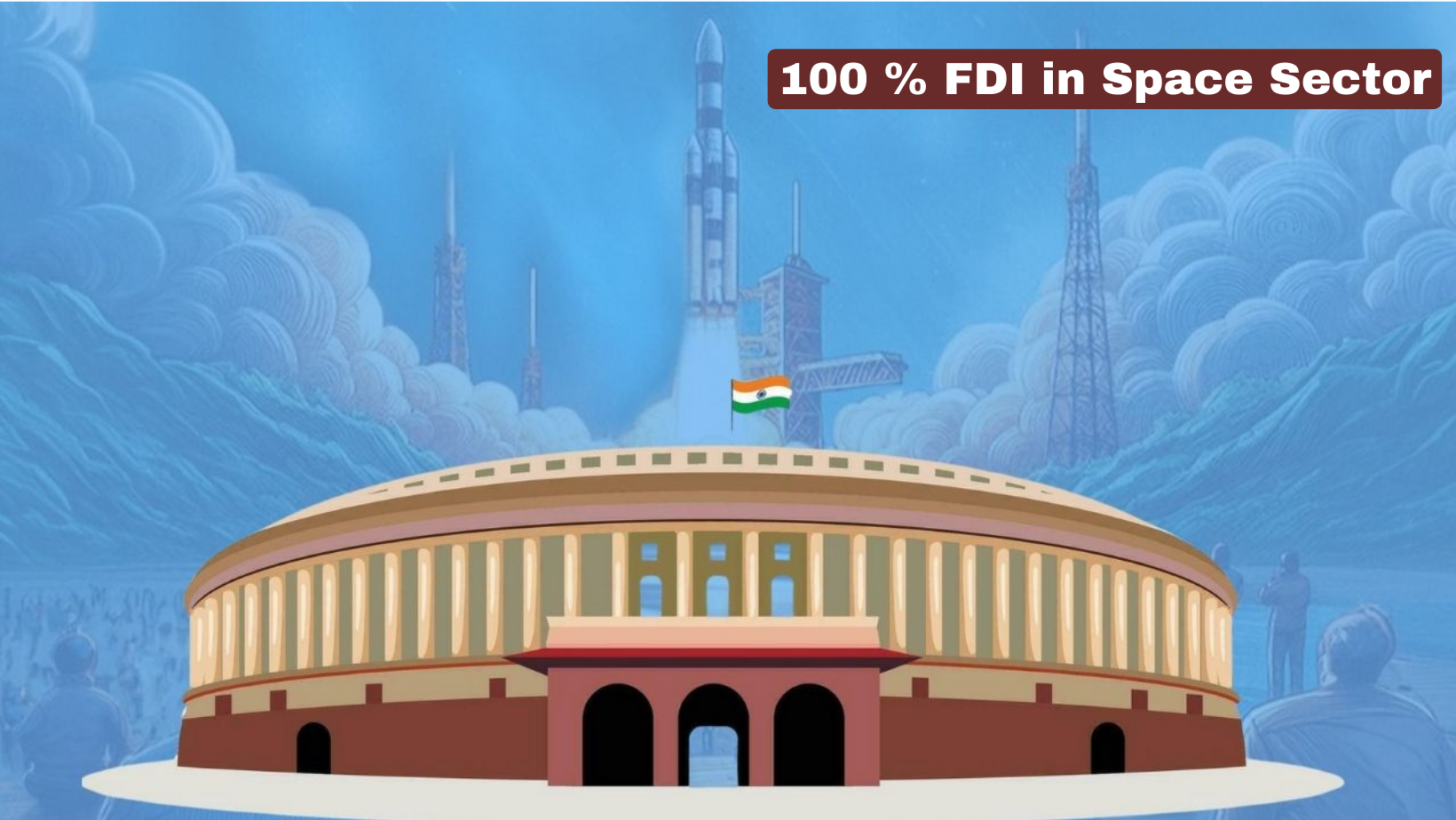
- 22 Feb 2024
Why is it in the News?
Recently, the government of India has approved the amendment in the Foreign Direct Investment (FDI) policy for the space sector.
Context:
- India’s space industry, though nascent compared to global leaders such as the US, Russia, and China, has made significant strides in cutting-edge technologies, as evidenced by successful missions like Chandrayaan-3, Aditya-L1, and XpoSat.
- These achievements have not only demonstrated India’s economic prowess in space technology but have also positioned the Country favourably on the global map.
- However, the sector faces challenges, particularly in funding.
- Despite the sector’s expansion from 10 to 150 startups within three years, the absence of a substantial domestic investor pool interested in space ventures, which are inherently slow to yield returns, has hindered growth.
- The only other way out was to look at Foreign Direct Investment (FDI) policy.
- According to experts, “India stands at a critical juncture in its space journey.
- With strategic investments in infrastructure and manufacturing, alongside fostering innovation and education, India can achieve its goal of a US$44 billion space economy by 2033, enhancing its position as a global leader in space technology and services.
What is the Current Status of India’s Space Sector?
- India's expertise in the space sector is globally acknowledged, with achievements ranging from cost-effective satellite construction to launching foreign satellites.
- Aligned with its commitment to the Geneva Conference on Disarmament (1979), India advocates for the peaceful and civilian utilization of outer space, opposing any militarization efforts.
- The Indian Space Economy is valued at approximately $8.4 billion, constituting around 2-3% of the global space economy.
- ISRO stands as the 6th largest space agency globally, boasting an impressive success rate.
- India also ranks 5th worldwide in the number of private space companies, with over 400 such entities.
- Budgetary Allocation: The Department of Space has witnessed a nominal 4% increase in its allocation in the Interim Union Budget for 2024-25, rising from ?12,545 crore to ?13,043 crore.
- Future Projections: Implementation of the Indian Space Policy 2023 could propel the Indian space economy to reach $44 billion by 2033.
- Growth in Space Start-Ups: The number of Space Start-Ups has surged from just 1 in 2014 to 189 in 2023, as reported by the DPIIT Start-Up India Portal.
- Investment in Indian Space Start-Ups has concurrently risen to $124.7 million in 2023.
Key Changes in FDI Policy:
- With the privatization of space launches, India aims for a significant five-fold increase in its share of the global launch market.
- The recent changes in the FDI policy reflect a more welcoming approach to foreign investment.
- Specifically, the satellite sector which used to have strict rules has now been split into different parts each with its own limits on how much foreign investment is allowed.
- Launch Vehicles and Associated Systems/Subsystems: Foreign investment up to 49% is permitted under the automatic route with government approval mandated for anything beyond this threshold.
- This includes activities related to the establishment of spaceports for spacecraft launches and receptions.
- Satellite Manufacturing and Operation: The automatic route allows for up to 74% FDI covering satellite manufacturing, operation, satellite data products and both the Ground Segment and User Segment.
- Approval from the government is required for FDI exceeding 74% in these activities.
- Manufacturing of Components and Systems/Subsystems: Foreign investors are now allowed to invest up to 100% in manufacturing components and systems for satellites, ground segments and user segments through the automatic route.
- The decision to liberalize FDI norms in the space sector stems from a strategic vision outlined in the Indian Space Policy 2023.
- By fostering a more investor-friendly environment the government aims to tap into the potential of non-government entities (NGEs) encouraging them to invest in Indian companies within the space domain.
- This move is expected to drive technological advancements, scale up operations globally and boost India's position in the global space economy.
Recent Advancements in the India’s Space Sector:
- Indian Space Policy 2023: This policy delineates the roles and responsibilities of entities like ISRO, NewSpace India Limited (NSIL), and private sector players with the aim of bolstering involvement from research, academia, startups, and industry.
- Strategic Proposals by SIA: The Space Industry Association – India (SIA-India) has recommended in its Pre-Budget Memorandum for FY 2024-25 a substantial increase in India's space budget.
- Defence Space Agency (DSA): India inaugurated its Defence Space Agency (DSA) alongside the Defence Space Research Organisation (DSRO), tasked with developing space-based weapons to counter adversaries.
- Defence Space Mission Launch: The Indian Prime Minister unveiled the Defence Space Mission during the Defence Expo 2022 in Gandhinagar.
- Expansion of Satellite Manufacturing: India's satellite manufacturing sector is forecasted to grow to USD 3.2 billion by 2025, up from USD 2.1 billion in 2020.
- SAMVAD Program: ISRO introduced the SAMVAD Student Outreach Program at its Bengaluru facility, aimed at fostering space research among young minds.
- The objective is to bolster India's expanding space program, encourage private sector participation, drive technological innovation, and position the nation as a prominent player in the global space landscape.
Importance of Foreign Direct Investment (FDI) in the Space Sector:
- Advancement in Space Missions: India's achievements in space missions have positioned it as a reliable provider of cost-effective space solutions globally, with FDI expected to further enhance technological capabilities and expand operations.
- Boost to Manufacturing: Encourages the establishment of manufacturing facilities within India, aligning with the government's 'Make In India' initiative and bolstering domestic manufacturing capabilities.
- Private Sector Engagement: FDI facilitates greater private sector involvement in India's space endeavours, transitioning from ISRO-driven initiatives to leveraging space technology for commercial applications and fostering industry participation.
- Integration into Global Value Chains: Expected to integrate Indian companies into global value chains, enabling them to contribute significantly to the global space economy.
- Technology Uptake and Global Collaboration: FDI promotes the absorption of advanced technology and facilitates global integration, enabling companies to enhance product sophistication, scale operations globally, and increase their share in the global space economy.
- Enhanced Business Environment: FDI policy reforms improve the Ease of Doing Business in India, attracting greater FDI inflows and fostering investment, income, and employment growth.
- Stimulus for Research and Innovation: FDI in the space sector stimulates technology transfer, fosters research collaborations, and encourages innovation, driving advancements in space technology and applications.
What are the Challenges?
- Limited Investor Engagement: Investors show limited interest in the later stages of space tech development, likely due to perceived high risks and long-term investment horizons.
- Talent Shortage: The space tech sector faces a shortage of skilled professionals, highlighting the need for expanded talent development initiatives.
- Policy Ambiguity: Ambiguous policies in the space sector create uncertainty, necessitating clear and consistent regulatory frameworks to attract foreign investment.
- Streamlining FDI Procedures: Simplification of foreign direct investment processes is essential to remove barriers and encourage investor participation in the space industry.
- High Capital Requirements: Space technology ventures demand substantial capital investments, posing challenges for startups and smaller enterprises in accessing necessary funds.
- Competition Concerns with ISRO: Foreign investors express reservations due to competition concerns with ISRO, highlighting the importance of addressing perceived conflicts of interest to instil investor confidence.
Conclusion
The amendment in the FDI policy on the space sector heralds a new era of growth and opportunity for India’s space industry. By opening doors to foreign investment, India aims to leverage private sector participation to enhance its space capabilities, drive innovation, and foster economic development. The policy reform underscores India’s commitment to becoming a global leader in space exploration and technology.
The Cost of Legal MSP is Greatly Exaggerated (Indian Express)
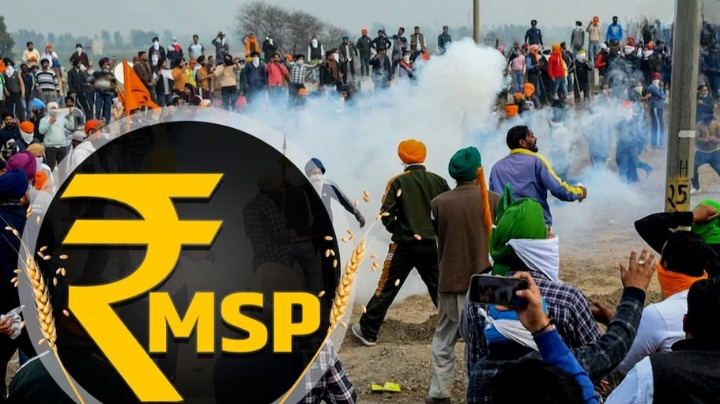
- 17 Feb 2024
Why is it in the News?
Farmers have resumed protests without a specific trigger, unlike their previous march against contentious farm laws. Their main demand is a legal guarantee for Minimum Support Prices (MSP).
Context:
- The renewed protest by farmers, advocating for a legal assurance of Minimum Support Prices (MSP), underscores the enduring battle for agricultural sector stability.
- Amidst this, it's crucial to delve into the intricacies of MSP, address prevailing misconceptions, and explore the advantages of formalising this system.
What is the Minimum Support Price (MSP)?
- MSP (Minimum Support Price) is the cost at which the government buys crops from the farmers, to guarantee farmers against any sharp fall in agricultural income.
- It is declared by the Government based on the proposal of the Commission for Agricultural Cost and Prices (CACP), at the start of the planting season.
- This mechanism aims to protect small and marginal farmers from financial losses and ensure an adequate supply of food grains for public distribution across India.
- Since its inception in 1966-67 for wheat, the MSP framework has expanded to cover various essential food crops, facilitating their availability to the public through subsidized rates under the public distribution system.
- However, only a small percentage, approximately 6% or less, of farmers are able to sell their produce at prices higher than the MSP.
Is the MSP Different in different states?
- Because of the variety in irrigation and wages, the expense of a similar yield changes from one state to another.
- However, there is no draft of the local Minimum Support Price, so there is one MSP for the whole country.
Significance of Minimum Support Price:
- Fixed Remunerations: The farmers are financially insured against the impulses of price fall in the market.
- It gives security to farmers from crop loss and price uncertainty.
- Help in Decision Making: MSPs are reported toward the start of the planting season, this assists farmers with settling on the best choices of crop that they should plant.
- This development data assists the farmer with settling on the best choice with regards to which yield to plant for the most extreme monetary advantage inside the restrictions of his agricultural land size, environment, and irrigation framework.
- Crop Diversification: The MSP declared by the Government of India without precedent for 1966-67 for wheat has reached out to around 24 crops at the present.
- This has urged the farmers to develop these different crops to maximize their agricultural income.
- Price Limitations for Private Purchasers: MSP conveys a value message to advertise that if vendors don’t offer higher than MSP costs the farmer may not sell them his produce.
- In this manner, it goes about as an anchor or benchmark for agricultural produce.
- It guarantees the market costs won’t be radically lower than the Minimum Support Price.
- Commercial Crops: MSP is utilized as an instrument to boost the creation of explicit food crops which is short in supply.
- MSP spurs farmers to develop commercial crops and expand creation on a commercial basis.
- Purchasing Power Enhancement: MSP provides fixed amounts in framers’ hands which makes them financially stable.
- It helps in upgrading the buying limit and updating the style of living of farmers and their families.
Challenges in Implementation of MSP:
- Selective Intervention and Limited Coverage: Despite the annual announcement of MSP for 23 crops, actual implementation tends to be selective, primarily focusing on major crops like rice and wheat.
- This limited coverage undermines the broader objective of ensuring stability across various agricultural commodities.
- MSP Implementation Bias: The unequal application of MSP, favouring specific crops, marginalizes farmers cultivating other essential commodities.
- This bias exacerbates regional disparities and impacts the economic well-being of farmers engaged in non-major crop cultivation.
- Disconnect Between Market Price and MSP: The disparity between market prices and MSP poses a significant challenge, as government intervention is triggered primarily when market prices fall below the MSP.
- Inconsistent intervention exacerbates uncertainties for farmers, leading to financial distress during market downturns.
- Perceived Government Apathy: Farmers perceive a lack of genuine interest or urgency from the government in effectively implementing MSP.
- This perceived apathy breeds distrust and frustration among farmers, fueling demands for a legal guarantee to ensure consistent and widespread implementation.
- Political Hesitation and Decision-Making Delays: While there is political consensus supporting a legal guarantee for MSP, successive governments have hesitated to formalize this mechanism.
- Delayed decision-making perpetuates uncertainties in the agricultural sector, undermining the effectiveness of MSP as a stabilizing force.
What Does a Legal Guarantee of MSP Mean and What Obstacles in Legalising MSP?
- It means that anyone paying less than the price set by the government for crops could be criminally charged.
- Currently, there is an MSP for 23 crops.
- However, the highest procurement by the government is of wheat and rice.
- According to experts, if MSP is legally guaranteed, the government will have to pay it regardless of supply and demand dynamics.
- At the moment, about 60 per cent of the total field crop production in India comes from wheat and paddy.
- Fiscal Concerns: Misconceptions regarding the fiscal implications of guaranteeing MSP have posed obstacles to its legalization.
- Despite the political consensus, concerns over perceived excessive fiscal burdens have deterred governments from formalizing MSP.
- Prevalent Misconceptions: There is a prevalent misconception that legalizing MSP necessitates government procurement of all agricultural produce, which is inaccurate.
- Government intervention is required only when market prices dip below MSP, and it does not entail the procurement of the entire marketable surplus.
- Misunderstanding of Procurement Costs and Subsidies: The cost of procuring rice and wheat is often misconstrued as the cost of the MSP program, whereas it primarily serves as a subsidy to consumers rather than farmers.
- For other crops, government procurement is not a cost unless sold with a subsidy, with the actual cost being the difference between economic cost and issue price.
Potential Advantages of Legalising MSP:
- Ensuring Uniform Implementation: Formalizing Minimum Support Prices (MSP) establishes a clear legal framework, ensuring consistent application across all crops.
- This move addresses current issues of selective intervention, providing farmers with a dependable safety net.
- Promoting Inclusive Agricultural Growth: Expanding MSP coverage to various crops ensures that price stability benefits all segments of the farming community.
- Small and marginal farmers cultivating diverse crops can access MSP protection, fostering inclusive agricultural development.
- Reducing Farmer Vulnerability: Formalizing MSP reduces farmers' susceptibility to market fluctuations by guaranteeing a minimum income for their produce.
- This assurance enables farmers to navigate uncertainties with confidence, knowing that government intervention is assured during price downturns.
- Boosting the Rural Economy: A secured MSP contributes to farmers' economic well-being, leading to increased rural income.
- This upliftment stimulates the rural economy by generating demand for goods and services, fostering growth across multiple sectors.
- Clarifying Consumer Subsidies: Formalization helps distinguish between procurement costs and consumer subsidies, often conflated as MSP program expenses.
- This clarity aids policy discussions and ensures targeted subsidy allocation, benefiting both farmers and consumers.
- Facilitating Strategic Government Operations: A legal framework empowers the government to conduct strategic operations in domestic and international markets.
- Through controlled sales during periods of high market prices, the government can manage inflation, ensuring price stability for consumers.
Conclusion
The legalization of MSP presents a holistic remedy to the agricultural sector's woes.
Beyond ensuring uniform application, it fosters diversification, inclusivity, and economic robustness, ultimately benefiting farmers and bolstering rural prosperity. By dispelling misconceptions and tackling apprehensions, policymakers can pave the way toward a more secure and prosperous future for our farmers.
Vision document to make India a $30 trillion economy by 2047 (TOI)
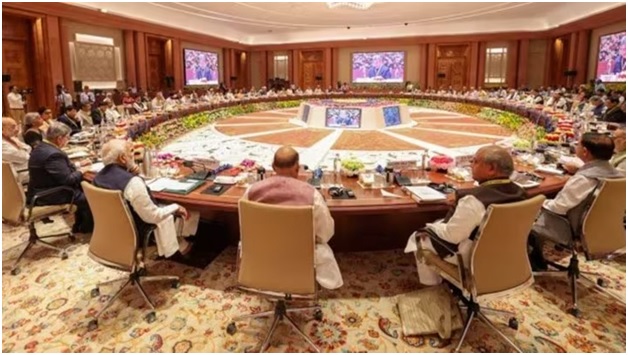
- 31 Oct 2023
Why is it in the News?
India will aim to become a ‘developed nation’ by 2047, with an economy of $30 trillion in its 100th year of independence, which will be propelled by radical policy changes and reforms in governance by 2030.
News Summary:
- The 'Viksit Bharat @2047' document, which outlines this vision, is nearing completion, following its inception in December 2021 by Prime Minister Narendra Modi.
- Ten sectoral groups of secretaries (SGoSs) were entrusted with the task of preparing sector-specific visions, and these are nearly finalized.
- Niti Aayog will consolidate these sectoral visions into a single comprehensive document by December, following consultations with SGoSs and thought leaders, including industry leaders.
- Prime Minister Modi is expected to unveil this vision document in December or January.
What is the Current State of the Indian Economy?
- India’s economy was $3.5 trillion in FY23, but currently with a GDP of $3.7 trillion, it is estimated to be the 5th largest economy in the world and according to some projections, India's GDP will surpass that of Germany and Japan by 2030.
- The country’s per capita income was estimated at around $2,500 in FY23.
- Nations with per capita income beyond a threshold of $17,000 are considered as developed.
- This rapid rate of economic expansion would result in India becoming the second-largest economy in the Asia-Pacific region.
NITI Aayog Vision India@2047 Document:
- The process of shaping the Vision India@2047 document commenced in December 2021.
- To ensure comprehensive coverage, ten groups of secretaries were assembled, each focused on distinct sectors such as rural and agriculture, infrastructure, social vision, welfare, technology, governance, security, foreign affairs, and more.
- This document will provide a blueprint for achieving the ambitious goal of transforming India into a $30-trillion developed economy by 2047, with a per-capita income ranging from $18,000 to $20,000.
- It will encompass a range of crucial elements, including re-engineering government processes, implementing reforms, and streamlining the efforts of various ministries and departments to eliminate redundancy.
- Expect insights into India's global involvement in areas like trade, investment, technology, capital flows, and research and development.
- Furthermore, the document will shed light on which Indian companies are poised to lead on the global stage and the strategic approach for nurturing the ecosystem required to realize this vision.
- It will also delve into matters related to human capital development, leveraging the nation's vast market size, and addressing regional disparities.
- The vision document will also provide a roadmap, delineating where India aims to be in 2030 and, ultimately, in 2047."
What are the obstacles ahead in implementing the Vision India@2047?
- NITI Aayog is assisting Gujarat and Andhra Pradesh in preparing their vision documents in order to bring them into compliance with the national vision document.
- While other states, such as Uttarakhand, Goa, Tamil Nadu, and Uttar Pradesh, are working on their own documents.
- Middle-income trap: The plan will include safeguards to make sure the economy stays out of the "middle-income trap".
What is the middle-income trap?
- According to the World Bank, the term "middle-income trap" describes a scenario in which a nation with a middle-class income is unable to make the transition to a high-income economy because of growing expenses and a decrease in its competitiveness.
- It's when per capita income reaches around $5,000 to $6,000, and then progress slows down.
- Low-income countries often tend to transition faster to middle-income levels, driven by low wages, cheap labour and basic technology catch-up.
- However, only a few countries manage to achieve high-income status.
What are the reasons for the middle-income trap?
- An example of what is known as the "middle-income trap" is when labour wages become so high that a middle-income nation is unable to compete on a global scale in the production of standardized, labour-intensive goods.
- But because of its relatively low productivity, it is also unable to compete on a large enough scale in higher value-added activities.
- As a result, growth is slowing, wages are stagnant or falling, and the informal economy is expanding.
Countries that are stuck in the middle-income trap:
- Historically, some evidence suggests that Latin American and Middle Eastern countries suffered middle-income traps for at least four or five decades.
- According to a World Bank report, out of 101 middle-income countries in 1960, only 13 countries achieved high-income status by 200
- The most recent examples are Brazil and Mexico, which were touted to transition to developed economies but failed to achieve the same success as Japan or some countries in Eastern Europe.
What Strategies Can Help India Overcome Middle-Income Traps?
- Investment: India should aim for an investment-to-GDP ratio of 35%. Achieving this goal requires boosting savings to 32% of GDP.
- In the fiscal year 2022, savings and investment rates were 30.2% and 29.6%, respectively, indicating the need for further growth.
- Balancing Fiscal Consolidation with Growth: India faces a challenge with a general public debt of 83% of GDP and high fiscal deficits.
- Balancing fiscal consolidation while meeting targets set under the Fiscal Responsibility and Budget Management (FRBM) framework is crucial.
- Structural Reforms: The Asian Development Bank (ADB) emphasizes the need for structural reforms in India to address issues like structural bottlenecks, declining investment, and an increasing current account deficit.
- Notable reforms include the Insolvency and Bankruptcy Code (IBC), which has strengthened the country's banking systems.
- Education and Skill Development: Skill development is vital for enhancing labour productivity and promoting inclusive growth.
- Recent reports suggest that employability among young people needs improvement, emphasizing the importance of education and skill enhancement programs.
- Research, Development, and Innovation: Innovation plays a significant role in transforming India's economy. India's progress in the Global Innovation Index reflects its potential.
- Initiatives like the CoWin platform for monitoring vaccination programs and the development of data ecosystems through platforms like UPI and Aadhaar are driving India's growth.
- Climate Change Adaptation: India should focus on developing and customizing adaptation technologies and solutions to address climate-induced vulnerabilities.
- This includes addressing challenges in agricultural production, food security, disaster risks, resource access (water, power, coastal resources), and human health in the face of climate change.
